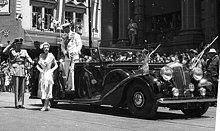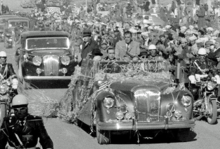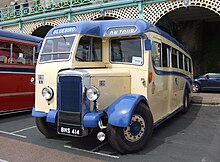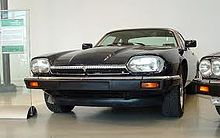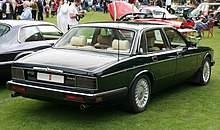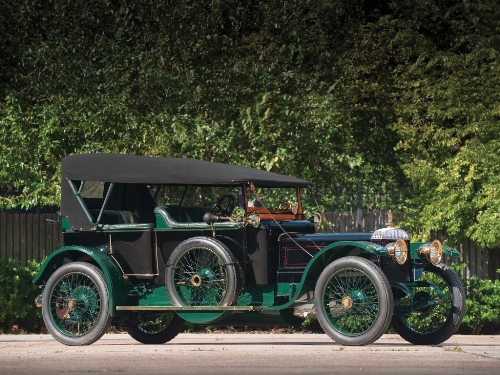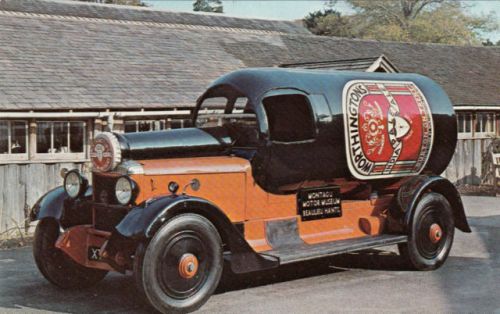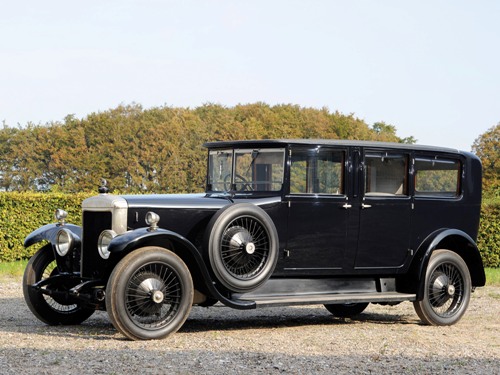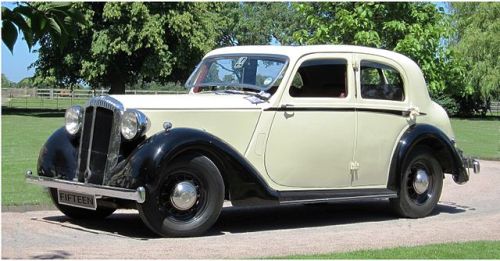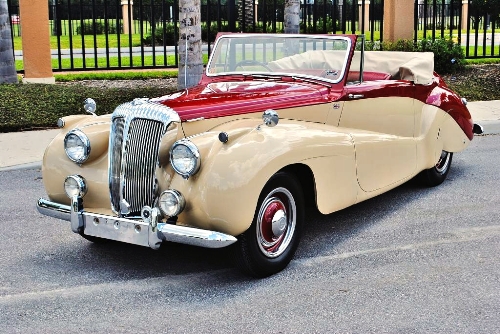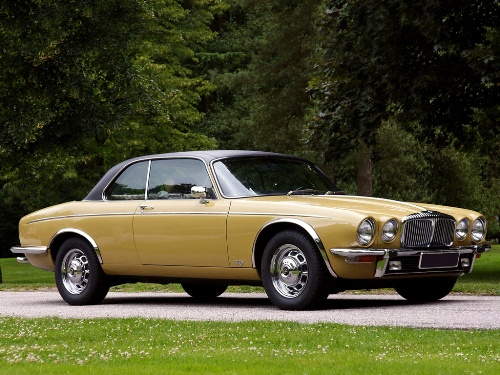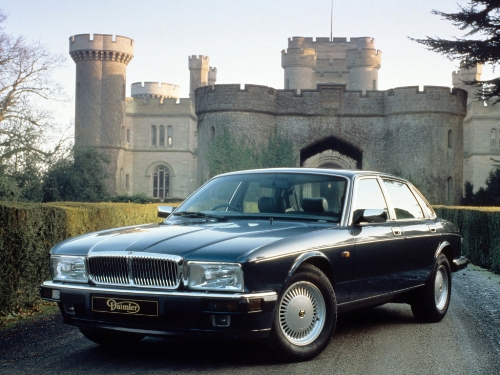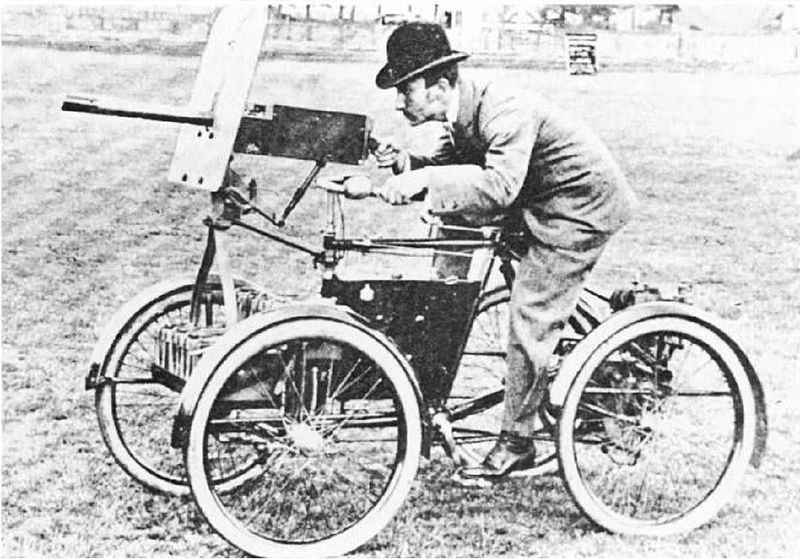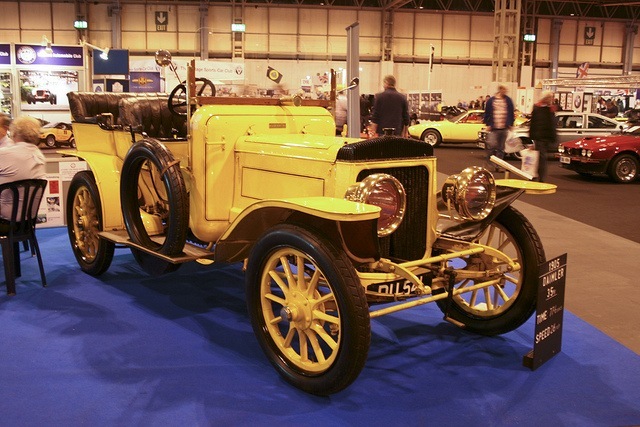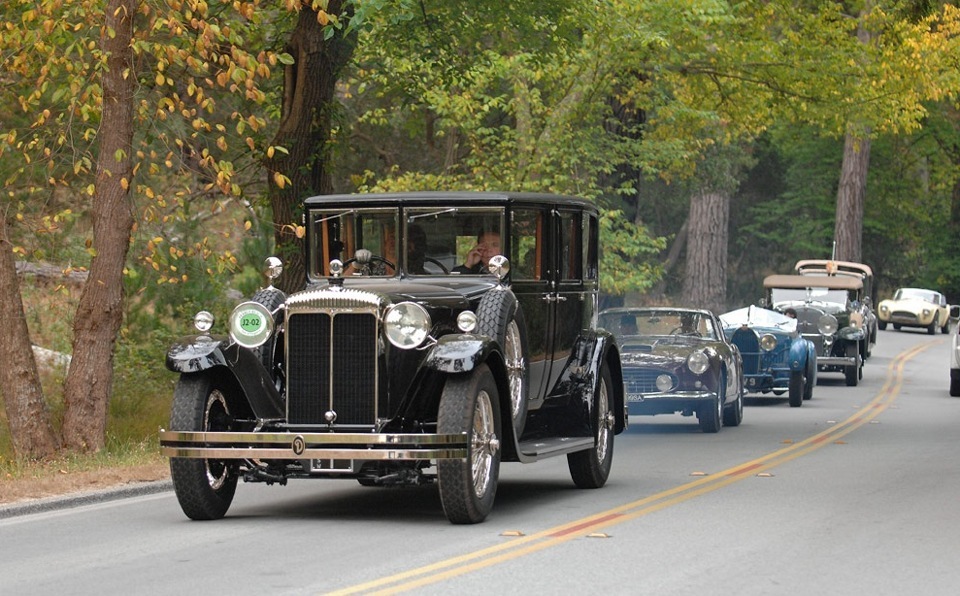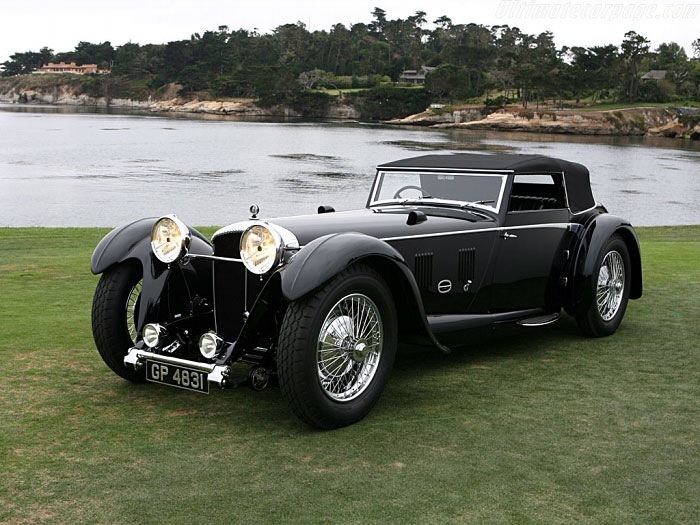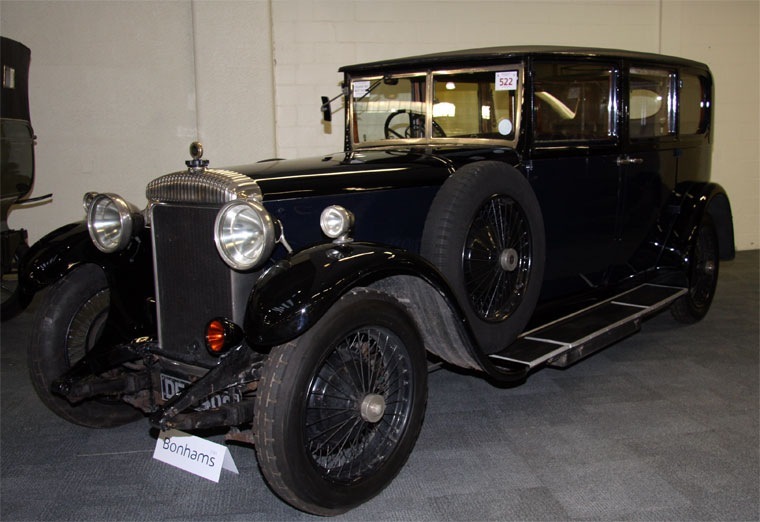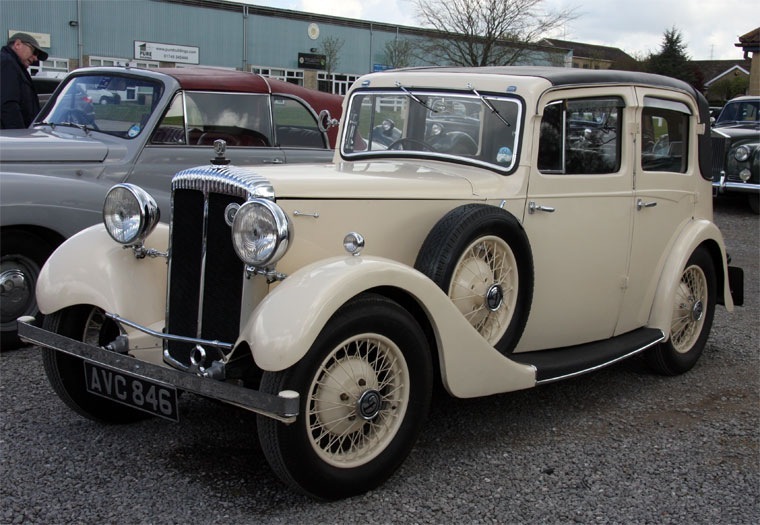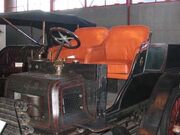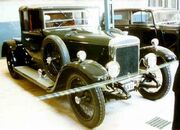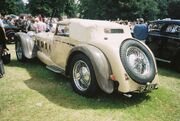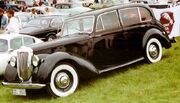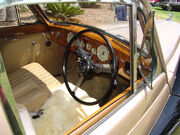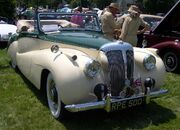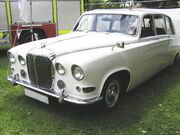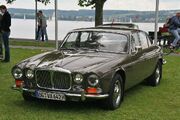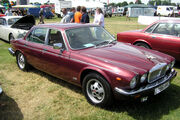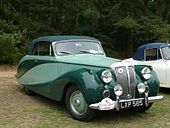| Daimler Motor Company | |
| Год основания |
1896 |
|---|---|
| Упразднена |
1960 |
| Причина упразднения |
слияние с Jaguar Cars |
| Преемник |
Jaguar Cars |
| Расположение |
|
| Отрасль |
автомобилестроение |
| Продукция |
Легковые автомобили |
| Материнская компания |
Tata Motors |
Не следует путать с Daimler — германской автомобилестроительной компанией.
Daimler (произносится как Дэмлер) — c 1896 года британская автомобильная марка, принадлежавшая компании Daimler Motor Company, специализирующаяся на выпуске эксклюзивных и представительских автомобилей. Штаб-квартира находится в Ковентри. В 1960 вошла в состав компании Jaguar, а затем Ford Motor Company. 2 июня 2008 года корпорация Ford, владеющая брендами Daimler, Jaguar и Land Rover, объявила об их продаже компании Tata Motors.
История
Одна из старейших автомобильных компаний мира. Ее история началась с покупки в 1891 Фредериком Симмсом у Готлиба Даймлера патента на производство его бензиновых двигателей. Начало выпуска автомобилей относят к 1896. Партнером Симмса стал Гарри Лоусон. Компания разрабатывала свои модели независимо от компании Готлиба Даймлера. Почти с момента своего основания «Даймлер» сосредоточила свои усилия на выпуске больших автомобилей. В 1904 появляются мощные 8-цилиндровые двигатели и цепной привод колёс. В 1908 компания приобрела лицензию на выпуск бесклапанных моторов фирмы «Найт» (Night). Серийные автомобили не выпускались, каждый заказ обрабатывался индивидуально. С 1900, когда свой первый «Даймлер» приобрел принц Уэльский (будущий король Эдуард VII) и вплоть до 50-х гг. фирма сохраняла за собой статус поставщика автомобилей для королевского двора, хотя последний из королевских «Даймлеров» был изготовлен несколько раньше для Георга VI.
В 1910 компания попала под контроль «Бирмингемской компании лёгкого оружия» (Birmingham Small Arms Company, BSA) и с началом войны взялась за производство легковых автомобилей, самолётов, тракторов и военного снаряжения для нужд армии. Производство гражданской продукции возобновилось в 1919 выпуском новых моделей 30НР и 45НР; в 1927 вышла — Double Six c V-образным 12-цилиндровым двигателем.
В 1931 «Даймлер» была выкуплена компанией «Ланчестер» (Lanchester), входившей в корпорацию BSA. Она пересмотрела политику компании и отказалась от достаточно сложных и неэкономичных бесклапанных моторов, устанавливаемых на выпускаемые автомобили, и перешла на выпуск шести- и восьмицилиндровых рядных двигателей обычной конструкции. К концу 1930-х появились первые автомобили с независимой подвеской колес. После Второй мировой войны компания продолжила выпуск довоенных моделей DB-18 и DE-27, а также представила новые: DE36, Conquest Century, Regency, Magestic Major.
В 1960 «Даймлер» попал под контроль компании «Ягуар», а через несколько лет вместе с ней стал частью концерна «Бритиш Лейланд» (British Leyland). С этого времени он перешёл на выпуск моделей, унифицированных с моделями «Ягуар», потеряв свою самостоятельность. Исключениями стали спортивный двухместный SP-250 с 2,5-литровым V8-двигателем (1961—1964) и представительский лимузин DS-420 с рядным шестицилиндровым 4,2-литровым двигателем мощностью 167 л.с. (1968—1992). DS-420 до сих пор можно встретить около Букингемского дворца или резиденций высших руководителей Великобритании. В 1990 «Даймлер» вместе с компанией «Ягуар» стал частью американского автомобильного концерна «Форд Мотор» (Ford). В 1992 была снята с производства последняя собственная разработка компании — DS-420, и она перешла на выпуск «Ягуаров» повышенной комфортности под маркой «Даймлер».
C 2005 по 2009 год, модельный ряд компании был представлен всего одной моделью — Daimler Super Eight.
This article is about the British motor vehicle manufacturer. For the German motor vehicle manufacturer, see Mercedes-Benz Group. For the disambiguation of other Daimlers, see Daimler.
 |
|
| Industry | Automotive |
|---|---|
| Founded | 1896; 127 years ago |
| Fate | Dormant since 2010 |
| Successor | Jaguar Cars continued to use the Daimler marque |
| Headquarters |
Coventry , United Kingdom |
|
Key people |
Percy Martin Edward Manville |
| Products | Motor vehicles |
|
Number of employees |
16,000 (peak) |
| Parent | from 1910 to 1960 Birmingham Small Arms Company |
| Subsidiaries | Lanchester Motor Company Daimler Hire Daimler Air Hire Daimler Airway Transport Vehicles (Daimler) Hooper & Co Barker & Co Carbodies Hobbs Transmission Stratton-Instone |
 |
|

5½-litre 150 bhp Straight-Eight drop-head coupé 1949 |
|
| Product type | Motor vehicles |
|---|---|
| Owner | Jaguar Land Rover (since 2013)[1] |
| Country | United Kingdom |
| Introduced | 1891 |
| Discontinued | 2007 |
| Related brands | Jaguar |
| Markets | International |
| Previous owners |
|
Flutes: Daimler’s traditional radiator grille topped by now-vestigial cooling fins adopted by 1905
The Daimler Company Limited ( DAYM-lər), prior to 1910 The Daimler Motor Company Limited, was an independent British motor vehicle manufacturer founded in London by H. J. Lawson in 1896, which set up its manufacturing base in Coventry. The company bought the right to the use of the Daimler name simultaneously from Gottlieb Daimler and Daimler-Motoren-Gesellschaft of Cannstatt, Germany. After early financial difficulty and a reorganisation of the company in 1904, the Daimler Motor Company was purchased by Birmingham Small Arms Company (BSA) in 1910, which also made cars under its own name before the Second World War. In 1933, BSA bought the Lanchester Motor Company and made it a subsidiary of Daimler Company.
Daimler was awarded a Royal Warrant to provide cars to the British monarch in 1902; it lost this privilege in the 1950s after being supplanted by Rolls-Royce. Daimler occasionally used alternative technology: the Knight engine which it further developed in the early twentieth century and used from 1909 to 1935, the worm gear final drive fitted from 1909 until after the Second World War, and their patented fluid flywheel used in conjunction with a Wilson preselector gearbox from 1930 to the mid-1950s.
Daimler tried to widen its appeal in the 1950s with a line of smaller cars at one end and opulent show cars at the other, stopped making Lanchesters, had a highly publicised removal of their chairman from the board, and developed and sold a sports car and a high-performance luxury saloon and limousine.
BSA sold Daimler to Jaguar Cars in 1960 and Jaguar briefly continued Daimler’s line adding a Daimler variant of its Mark II sports saloon. Jaguar was then merged into the British Motor Corporation in 1966 and British Leyland in 1968. Under these companies, Daimler became an upscale trim level for Jaguar cars except for the 1968–1992 Daimler DS420 limousine, which had no Jaguar equivalent despite being fully Jaguar-based. When Jaguar Cars was split off from British Leyland in 1984 it retained the Daimler company and brand.
Ford bought Jaguar Cars in 1990 and under Ford it stopped using the Daimler marque in 2009 when the last X358 Daimler models were discontinued. The X351 Jaguar XJ took its place and there was no Daimler variant. Jaguar Cars remained in its ownership, and from 2000 accompanied by Land Rover, until they sold both Jaguar and Land Rover to Tata Motors in 2008, who formed Jaguar Land Rover as a subsidiary holding company for them. In 2013, Jaguar Cars was merged with Land Rover to form Jaguar Land Rover Limited, and the rights to the Daimler car brand were transferred to the newly formed British multinational car manufacturer Jaguar Land Rover.[1]
Origin[edit]
Simms and the Daimler engine[edit]
Gottlieb Daimler’s railcars «tirelessly ferrying passengers around the Bremen showground as if by magic».
Engineer Frederick Richard Simms was supervising construction of an aerial cableway of his own design for the Bremen Exhibition in 1889 when he saw tiny railcars powered by Gottlieb Daimler’s motors. Simms, who had been born to English parents in Hamburg and raised by them there, became friends with Daimler, an Anglophile who had worked from autumn 1861 to summer 1863 at Beyer-Peacock in Gorton, Manchester.[2][3]
Simms introduced Daimler’s motors to England in 1890 to power launches. In an agreement dated 18 February 1891, he obtained British and Empire rights for the Daimler patents. That month, Daimler Motoren Gesellschaft lent Simms a motorboat with a 2 hp engine and an extra engine.[4] In June 1891 Simms had set up a London office at 49 Leadenhall Street and founded Simms & Co consulting engineers.[5] In May 1892, the motorboat, which Simms had named Cannstatt, began running on the Thames from Putney.[5] After demonstrating a motor launch to The Honourable Evelyn Ellis, Simms’s motor launch business grew rapidly, but became endangered when solicitor Alfred Hendriks was found to have been illegally taking money from the company.[5] Hendriks severed his connections with Simms & Co. in February 1893. Simms’ Daimler-related work was later moved into a new company, The Daimler Motor Syndicate Limited, which was formed on 26 May 1893.[6]
Simms plans to make cars[edit]
Following the success of Daimler-powered Peugeots and Panhards at the 1894 Paris–Rouen competition, Simms decided to open a motor car factory,[7]
On 7 June 1895 Simms told the board of the Daimler Motor Syndicate that he intended to form The Daimler Motor Company Limited to acquire the British rights to the Daimler patents and to manufacture Daimler engines and cars in England.[8] That month, he arranged for the syndicate to receive a ten percent (10%) commission on all British sales of Daimler-powered Panhard & Levassor cars.[9]
At the same meeting Simms produced the first licence to operate a car under the Daimler patents. It was for a 3+1⁄2 hp Panhard & Levassor that had been bought in France by The Honourable Evelyn Ellis, who had three Daimler motor launches moored by his home at Datchet. On 3 July, after Ellis bought the licence, the car was landed at Southampton and driven by Ellis to Micheldever near Winchester where Ellis met Simms and they drove together to Datchet. Ellis later drove it on to Malvern. This was the first long journey by motorcar in Britain.[8] Simms later referred to the car as a «Daimler Motor Carriage».[9]
Later in 1895 Simms announced plans to form The Daimler Motor Company Limited and to build a brand-new factory, with delivery of raw materials by light rail, for 400 workmen making Daimler engines and motor carriages. Simms asked his friend Daimler to be consulting engineer to the new enterprise.[10] Works premises at Eel Pie Island on the Thames[10] where the Thames Electric and Steam Launch Company, owned by Andrew Pears of Pears Soap fame, had been making electrically powered motor launches,[11] were purchased to be used to service Daimler-powered motor launches.[8][10]
Simms sells out to Lawson[edit]
Investor Harry John Lawson had set out to use the British Motor Syndicate to monopolise motor car production in Britain by taking over every patent he could. As part of this goal, Lawson approached Simms on 15 October 1895, seeking the right to arrange the public flotation of the proposed new company and to acquire a large shareholding for his British Motor Syndicate.[7] Welcomed by Simms, the negotiations proceeded on the basis that this new company should acquire The Daimler Motor Syndicate Limited as a going concern, including the name and patent rights.[12]
In order that the Daimler licences could be transferred from Simms to the new company, all the former partners would have to agree to the transfer. By this time, Gottlieb Daimler and Wilhelm Maybach had withdrawn from Daimler Motoren Gesellschaft’s business to concentrate on cars and engines for them.[13] Simms offered to pay DMG £17,500 for the transfer and for a licence for Daimler and Maybach’s Phénix engine, which DMG did not own. Simms therefore insisted that the transfer be on the condition that Daimler and Maybach rejoined DMG.[13][14] This was agreed in November 1895 and the Daimler-Maybach car business re-merged with DMG’s. Daimler was appointed DMG’s General Inspector and Maybach chief Technical Director.[14][15] At the same time Simms became a director of DMG but did not become a director of the London company. According to Gustav Vischer, DMG’s business manager at the time, Simms getting Daimler to return to DMG was «no mean feat».[16]
The sale of Daimler Motor Syndicate to Lawson’s interests was completed by the end of November 1895. The shareholders of the Syndicate had made a profit of two hundred percent (200%) on their original investment.[17]
Independent (1896–1910)[edit]
From starting to stability[edit]
1897 Daimler Grafton Phaeton built in Coventry
On 14 January 1896 Lawson incorporated The Daimler Motor Company Limited. A prospectus was issued on 15 February.[18] The subscription lists opened on 17 February[18] and closed, oversubscribed, the next day.[19] The Daimler Motor Company Limited bought The Daimler Motor Syndicate Limited from Lawson’s British Motor Syndicate as a going concern. Simms was appointed consulting engineer to the new business but was not to be on the board of directors,[19] possibly because he had become a director of the Cannstatt firm.
One of the duties assigned to Simms was to find a suitable location for the factory. Simms found the Trusty Oil Engine Works, a company in receivership whose six-acre site at Cheltenham included a foundry, a machine shop, and testing facilities.[20][21] Simms recommended buying the works immediately since, with ready facilities and the availability of skilled workers, they could start up in a very short time.[20] Instead, at the first statutory meeting of the company, held while Simms was overseas, Lawson persuaded the board to buy a disused four-storey cotton mill in Coventry which was owned by Lawson’s associate Ernest Terah Hooley.[20] Despite Simms’ later protest and pleas to sell the mill and buy the Trusty Oil Engine Works, Daimler stayed with the mill as the site of Britain’s first automobile factory.[22]
Delayed delivery of machines kept the factory unfinished throughout 1896 and into 1897.[23] During 1896 Daimler sold imported cars from companies for which Lawson held the licences.[24] Cannstatt supplied engine parts but the delivery of working drawings were delayed for months.[25] Four experimental cars were built in Coventry and a Panhard van was dismantled and reverse engineered.[26] Some Daimler engines, with details redesigned by works manager J. S. Critchley, were also made in 1896.[27]
The first car left the works in January 1897, fitted with a Panhard engine, followed in March by Daimler-engined cars. The first Coventry Daimler-engined product made its maiden run in March 1897.[27] By mid-year they were producing three of their own cars a week and producing Léon Bollée cars under licence. Lawson claimed to have made 20 cars by July 1897 making the Daimler Britain’s first motor car to go into serial production, an honour that is also credited to Humber Motors who had also displayed, but in their case their production models, at the Stanley Cycle Show in London in 1896. The Daimlers had a twin-cylinder, 1526 cc engine, mounted at the front of the car, four-speed gearbox and chain drive to the rear wheels.
1899 12 hp[note 1] Daimler
Because of Daimler’s financial difficulty in July 1897 Daimler began asking Lawson’s Great Horseless Carriage Company to settle its accounts with them. In the same month, they refused to send working drawings of their 4 hp motor frame to DMG in Canstatt. Lack of co-operation with the Canstatt firm caused Simms to resign as Daimler’s consulting engineer that month.[28] Also in July 1897, the company sold their launch works at Eel Pie Island at a loss of £700 or more.[29][30]
Ongoing difficulties with the Great Horseless Carriage Company and the British Motor Syndicate caused Lawson to resign from Daimler’s board on 7 October 1897.[31] He was replaced as chairman by Henry Sturmey,[32] who at the time was five days into a motor tour in his personal Daimler from John O’Groats to Land’s End. On arriving at Land’s End on 19 October, Sturmey became the first person to make that journey in a motor car.[29]
Gottlieb Daimler resigned from the board of the Daimler Motor Company in July 1898 having never attended a board meeting. Sturmey opposed the appointment of a proposed successor who, according to Sturmey, held no shares and knew nothing about the automobile business. A committee was brought in to investigate the activities of the board and the company.[33] The committee summed up the management of the business as being inefficient and not energetic and suggested that it be reorganised and run by a paid managing director.[34] When Evelyn Ellis and another board member did not run for re-election, they were replaced by E. H. Bayley and Edward Jenkinson, with Bayley replacing Sturmey as chairman. Sturmey resigned in May 1899 after Bayley and Jenkinson had reorganised the business.[35]
Simms, as a director of DMG, proposed a union between the Daimler Motor Company in Coventry and DMG in Cannstatt in mid-1900 but the reorganised company was not interested in the merger and turned the offer down.[36]
Persistent financial troubles caused Daimler to be reorganised again in 1904. The previous company was wound up and a new company was formed to acquire the old one and pay its debts and winding-up costs.[37]
Under the chairmanship of Sir Edward Jenkinson, Daimler hired American electrical engineer Percy Martin as works manager[38] and socialite Undecimus Stratton as the head of the London depot,[39] and promoted Ernest Instone to general manager.[40] Jenkinson was succeeded in 1906 by Edward Manville, a consulting electrical engineer.
Royal patronage[edit]
The first Royal car 6 hp 2-cylinders 1527 cc fitted with a «mail phaeton» body purchased by the Prince of Wales, 1900. Currently on display at Sandringham
Known as Britain’s oldest car manufacturers, Daimler was first associated with royalty in 1898 when the Prince of Wales, later Edward VII, was given a ride on a Daimler by John Douglas-Scott-Montagu later known as Lord Montagu of Beaulieu. Scott-Montagu, as a member of parliament, also drove a Daimler into the yard of the Palace of Westminster, the first motorised vehicle to be driven there.[41]
Daimler had sold the Prince of Wales a mail phaeton in early 1900.[42][43] In 1902, upon buying another Daimler, King Edward VII awarded Daimler a royal warrant as suppliers of motor cars.[43][44]
Undecimus Stratton met E. G. Jenkinson, the chairman of Daimler, in 1903 when Jenkinson’s Daimler was stranded by the roadside. Upon seeing the stranded motorist, Stratton stopped his Daimler and offered assistance.[45] Jenkinson was impressed by Stratton and by his motoring knowledge. At the time, Jenkinson was looking to replace the head of Daimler’s London depot, a particularly sensitive position because of the royal cars. Taking the position, Stratton soon found himself having to select better royal chauffeurs and mechanics.[42] He quickly became an occasional motoring companion to the King.[46] In 1908, through Stratton’s Royal connections, Daimler was awarded a «Royal Appointment as suppliers of motor cars to the Court of Spain» by King Alfonso XIII[47] and a Royal Warrant as «Motor Car Manufacturer to the Court of Prussia» by Kaiser Wilhelm II.[48] Stratton also sold Daimlers to the Sultan of Johor.[47] In 1911, he spent some weekends at Sandringham tutoring the new Prince of Wales on the workings and driving of an automobile.[49][50]
Stratton went into partnership with Daimler’s commercial manager Ernest Instone in 1921. Stratton and Instone took charge of the Daimler showrooms at 27 Pall Mall, naming the business Stratton-Instone.[51] Stratton died in July 1929 after a brief illness.[51] His successors and Instone bought out Daimler’s interest in 1930 and renamed the business Stratstone Limited.[citation needed] The following summer the future King Edward VIII rented Stratton’s house at Sunningdale from his widow.[51]
Every British monarch from Edward VII to Elizabeth II has been driven in Daimler limousines. In 1950, after a persistent transmission failure on the King’s car, Rolls-Royce was commissioned to provide official state cars and as Daimlers retired they were not replaced by Daimlers. The current official state car is either one of a pair which were specially made for the purpose by Bentley, unofficial chauffeured transport is by Daimler. Elizabeth II’s own car for personal use was a 2008 Daimler Super Eight but she was also seen to drive herself in other smaller cars.
Fluted radiator[edit]
Since 1904, the fluted top surface to the radiator grille has been Daimler’s distinguishing feature. This motif developed from the heavily finned water-cooling tubes slung externally at the front of early cars. Later, a more conventional, vertical radiator had a heavily finned header tank. Eventually these fins were echoed on a protective grille shell and, even later, on the rear licence plate holder.
Sleeve-valve engines[edit]
Knight-Daimler engine, transverse section
Attracted by the possibilities of the «Silent Knight» engine Daimler’s chairman contacted Charles Yale Knight in Chicago and Knight settled in England near Coventry in 1907. Daimler bought rights from Knight «for England and the colonies» and shared ownership of the European rights, in which it took 60%, with Minerva of Belgium. Daimler contracted Dr Frederick Lanchester as their consultant for the purpose and a major re-design and refinement of Knight’s design took place in great secrecy. Knight’s design was made a practical proposition.[52] When unveiled in September 1908 the new engine caused a sensation. «Suffice it to say that mushroom valves, springs and cams, and many small parts, are swept away bodily, that we have an almost perfectly spherical explosion chamber, and a cast-iron sleeve or tube as that portion of the combustion chamber in which the piston travels.»[53]
Daimler 22 hp[note 1] open 2-seater
among the first of the sleeve-valve Daimlers (1909 example)
» . . . left a slight haze of oil smoke trailing behind . . .» Kop Hill Climb 2014
The Royal Automobile Club held a special meeting to discuss the new engine, still silent but no longer «Wholly Knight».[citation needed] The Autocar reported on «its extraordinary combination of silence, flexibility and power.» Daimler stopped making poppet-valve engines altogether.[54] Under the observation of the Royal Automobile Club (RAC), two Daimler sleeve-valve engines were put through severe bench, road, and track tests and, upon being dismantled, showed no visible wear, earning Daimler the 1909 Dewar Trophy.[55] Sales outran the works’ ability to supply.[citation needed]
Daimler’s sleeve valve engines idle silently but they left a slight haze of oil smoke trailing behind them. These engines consumed oil at a rate of up to an Imperial gallon every 450 miles,[54] oil being needed to lubricate the sleeves particularly when cold.[56] However, by the standards of their day they required very little maintenance.[57]
Daimler kept their silent sleeve-valve engines until the mid-1930s. The change to poppet valves began with the Fifteen of 1933.[58]
First fatal motor accident in the United Kingdom[edit]
A Daimler 6 hp was involved in the first motor accident in the UK to be recorded as having involved the death of the driver. A young engineer was killed in 1899 when the rim of a rear wheel of the car he was driving collapsed under heavy braking in a turn on a sloping road in Harrow on the Hill. The driver and his four passengers were thrown from the car. One of the passengers fractured his skull in the accident and died in hospital three days later.[59][60][61]
Under BSA (1910–1960)[edit]
Acquisition by BSA[edit]
1910 Daimler 57 hp[note 1] limousine, an official state car for King George V
Under an agreement dated 22 September 1910[62] the shareholders of The Daimler Motor Company Limited «merged their holdings with those of the Birmingham Small Arms Company (BSA) group of companies,»[citation needed] receiving five BSA shares in exchange for four ordinary Daimler shares and £1 5s plus accrued dividend for each £1 preference share.[63] This deal was engineered by Dudley Docker, deputy-chairman of BSA, who was famous for previous successful business mergers.[64]
Daimler, a manufacturer of motor vehicles, had a payroll of 4,116 workmen and 418 staff immediately before the merger.[64] BSA produced rifles, ammunition, military vehicles, bicycles, motorcycles and some BSA-branded cars.[65] The chairman of the combined group was Edward Manville, who had been chairman of the Society of Motor Manufacturers and Traders – founded by Simms – since 1907.[64]
However the merger was not a great success. By 1913 Daimler had a workforce of 5,000 workers which made only 1,000 vehicles a year.[66]
Commercial Division[edit]
In 1911 Daimler had plans to create The Premier Motor Omnibus Company (running Daimler buses) and appoint Frank Searle (ex London General Omnibus Company) as the managing director. However plans had to be scrapped at the last moment, and instead the Daimler managing director, Percy Martin, created the Daimler commercial division, with Frank Searle as its head.[67] Daimler had been involved with various commercial vehicle designs for some time, and this brought vans, trucks, buses, tractors and railcars under the same division head. All vehicles used the Daimler sleeve-valve petrol engines, many using the 105 hp[note 1] 15.9 L sleeve-valve straight-six engine.
New product announcements followed rapidly, with the 36 hp tractor launched at the June 1911 Norwich Agricultural Show, and its larger 105 hp version (a joint project with William Foster & Co.) following in January 1912 (mainly destined for the South American market).[68] Both used Daimler sleeve-valve engines, the larger 6-cylinder tractor having a small BSA starter engine. Main article Foster-Daimler tractor.
In January 1912, new commercial vehicles included a 1-ton delivery van, lorries from 2 to 5 ton and a 40 hp omnibus.[67]
Buses and trucks were able to use the same chassis and engines and, as was common practice for commercial vehicles, then have bespoke bodywork fitted. The Metropolitan Electric Tramways ordering 350 double-decker buses in 1912 and engines were sold to the London General Omnibus Company (LGOC).[69] The bus models were the 13 foot wheelbase CB (same chassis as the 4 ton truck) and the 12 foot wheelbase CC, both with 40 hp engines. With the onset of WW1 CC chassis production was stopped and CB production was ramped up for trucks for the military.
A half-ton delivery van was based on a 12 hp[note 1] chassis similar to a car chassis.[69]
The railcar project utilised 2 of the large six-cylinder engines. Daimler had created a railcar in 1904, and though it went into service briefly it was hardly a success. The new project in 1911 was of advanced design with the drive engines charging accumulators which could be used to provide a power boost, or to drive the vehicle in the event of engine failure. The bodywork was completed in 1913. The war interrupted the testing though it fared well, although it wasn’t a commercial success and in 1921 the railcar project was dropped.[70]
There was a close link between the Associated Equipment Company (AEC) and Daimler commercial division. Daimler secured sole marketing rights for any AEC chassis other than those required by AEC’s owner (the London General Omnibus Company), and in exchange AEC were to fit Daimler engines in their chassis.[71] This agreement was made in 1912, and continued until AEC war service vehicles had to have the Tylor engine fitted. In the late 1920s AEC and Daimler commercial division formed the Associated Daimler Company to build commercial vehicles. The association was dissolved in 1928 with each company retaining manufacture of its original products.[72]
Royal transport[edit]
Daimler 20 hp[note 1] open drive limousine for the Empress of Korea
By 1914 Daimlers were used by royal families including those of Great Britain, Germany, Russia, Sweden, Japan, Spain, and Greece; «its list of owners among the British nobility read like a digest of Debrett;»[73] the Bombay agent supplied Indian princes; the Japanese agent, Okura, handled sales in Manchuria and Korea.[73]
World War I work[edit]
Daimler CB-type 40hp[note 1] 3-ton lorry, 1915
During World War I, the military took the normal production cars, lorries, buses and ambulances together with a scout army vehicle and engines used in ambulances, trucks, and double-decker buses. Special products included aero-engines and complete aircraft, tank and tractor engines and munitions.
The first aircraft engine manufactured by Daimler was the 80 hp Gnome Monosoupape rotary. With no drawings available to them, Daimler’s Gnome engines were reverse-engineered from an engine delivered to them on 7 August 1914.[74] Daimler later built the RAF 1 and 1a air-cooled V8s, the RAF 4 and 4a V12s, the Le Rhone rotary, and the Bentley BR2 rotary alongside other manufacturers.[75] Production of RAF 4 engines gave Daimler experience in building V12 engines which would be appreciated when they later designed and built «Double-Six» V12 engines for their large cars.[76]
Daimler trained air force mechanics at its works and its training methods became the standard for all manufacturers instructing RAF mechanics.[76]
Having its own body shop, Daimler had the woodworking ability to build complete aircraft. By the end of 1914, they had built 100 units of the Royal Aircraft Factory B.E.2c.[77] These were followed by the BE12 and RE8.[78] Daimler purchased an open field beside their Radford factory, cleared the site, and made it available to the Government, who turned it into the main RAF testing ground for aircraft built in the Coventry district.[79] Although Daimler tooled up for production of the Royal Aircraft Factory F.E.4 bomber the aircraft was cancelled due to poor performance.[80] The last wartime aircraft produced was the Airco DH.10 Amiens bomber when they were building 80 aeroplanes a month.[76]
British Mark IV tank with an extended tail designed to improve its trench-crossing ability. Powered by a version of the Daimler 105 hp engine
Before the war, Daimler had been making 105 hp engines for the Foster-Daimler tractor which was manufactured by William Foster & Co. in a joint venture with Daimler for the South American market. These tractors were developed into artillery tractors to haul 15-inch (380 mm) howitzers. Production of the artillery tractors began on 3 December 1914. These engines were later used for the first British tanks ever built, the prototypes «Little Willie» and «Mother» and later in the production Mark I tank.[81] One major difficulty for the tanks was the fine oil haze above their Daimler engines which the enemy quickly learned meant tanks were operating nearby if out of sight.[82] The early tanks weighed up to 28 tons.[82] They were all Daimler powered. The Mark IV tank — the first major improvement in design — had uprated engines delivering 125 hp; these engines had aluminium pistons and are believed[note 2] to have been designed by W. O. Bentley while he was working on the Bentley BR1 rotary engine in Coventry.[82]
Daimler made more twelve-inch (305 mm) shell casings than any other private business in the country, with a peak production of more than 2000 casings a day.[57] Each was machined from a 990 lb forging down to a finished weight of 684 lb.[83]
-
Bentley BR2
aero engine -
12-inch
artillery shells -
Daimler-Foster
105 hp[note 1]
artillery tractor
Civil aviation[edit]
De Havilland DH.34
Daimler Airway livery red and white
After the Armistice it was decided that Daimler Hire should extend its luxury travel services to include charter aircraft through a new enterprise, Daimler Air Hire. Following the take-over of Airco and its subsidiaries in February 1920 services included scheduled services London-Paris as well as «Taxi Planes» to «anywhere in Europe». In 1922, under the name of Daimler Airway services extended to scheduled flights London to Berlin and places between. Frank Searle, managing director of Daimler Hire and its subsidiaries moved with his deputy Humphery Wood into the new national carrier Imperial Airways at its formation on 1 April 1924. Searle and Wood and their Daimler Airway machines formed the core of Imperial Airways operations.
Lanchester acquisition and badging[edit]
The bulk of Daimler’s shareholding in its subsidiary Daimler Hire Limited was sold to the Thomas Tilling Group in 1930.[84] and, in January 1931, Daimler completed the purchase of The Lanchester Motor Company Limited.[84] The new Lanchester 15/18 model introduced in 1931 was fitted with Daimler’s fluid flywheel transmission.[84]
Although at first they produced separate ranges of cars with the Daimler badge appearing mainly on the larger models, by the mid-1930s the two were increasingly sharing components leading to the 1936 Lanchester 18/Daimler Light 20 differing in little except trim and grille.[85]
This marketing concept already employed with their BSA range of cars continued to the end of Lanchester and BSA car production. Some very important customers, including the Duke of York and at least two Indian princes, were supplied with big Daimler limousines with Lanchester grilles.[86] The Daimler range was exceptionally complex in the 1930s with cars using a variety of six- and eight-cylinder engines with capacities from 1805 cc in the short lived 15 of 1934 to the 4624 cc 4.5-litre of 1936.
Review of BSA management before the Second World War[edit]
The divisiveness of the Daimler board did not end with the BSA takeover, but continued into the board of BSA. Despite this, Daimler prospered until the late 1920s, increasing its profits and its reputation. Along with an apprenticeship programme that was among the best in the British industry at the time,[87] they attracted a large number of pupils out of public schools.[87] During the First World War, Daimler’s labour force grew from 4,000 to 6,000 men.
The acquisition of Airco in February 1920 was a financial disaster for the BSA group. Percy Martin had been strongly in favour of the purchase, including Airco’s extensive production facilities near London, and no one thought to examine Airco’s true circumstances, leading to liabilities in excess of £1.3 million.[88] All dividends were passed from 1920 to 1924.[89]
By 1930 the BSA Group’s primary activities were BSA motorcycles and Daimler vehicles.[90] However, all the quality car businesses experienced financial difficulties in the late 1920s. Daimler’s situation seemed particularly serious. Sales fell sharply in 1927–1928, a period of losses ensued and no dividends were paid between 1929 and 1936. The sleeve valve engine was outdated, Daimler’s production methods had become old-fashioned, they had an extravagantly large range of products. Their bankers noted the decreasing sales volume, the poor performance for price and the need for up-to-date machine tool equipment. Stratton-Instone’s dominance of distribution was removed and other outlets arranged. The interests in Singer and the Daimler Hire business were sold and Lanchester bought. The in-house bodywork department was closed and by the spring of 1931 car production ceased, only commercial vehicle production and aero engine work kept Daimler in business.[91]
Laurence Pomeroy joined Damler in late 1926, at first working on commercial vehicles but from 1928 he worked at the products of the main Daimler operation. Pomeroy introduced redesigned poppet valve engines with the Daimler Fifteen in September 1932, developed new models of Daimlers, and recommended what became the September 1932 introduction of the small BSA and Lanchester Tens with poppet valve engines to help Daimler survive the depression. According to Martin, these actions rescued the business from total collapse in 1932.[91] In 1934, the Pomeroy-designed poppet-valve Straight-Eights replaced the Daimler Double-Six sleeve-valve V12s without controversy or embarrassment, thereby being a personal triumph for Pomeroy.[92]
Management shift[edit]
From before the merger of Daimler into the BSA group the core of Daimler’s management was formed by chairman Edward Manville, works manager Percy Martin, and sales manager Ernest Instone, who left Daimler in 1921 to start auto dealer Stratton-Instone, and was responsible for Daimler sales in England and Wales thereafter.[93] Instone died in 1932, Manville died in 1933, and Martin, who in January 1934 replaced Alexander Roger, Manville’s replacement, as chairman, retired in 1935.[94] In May 1936 Laurence Pomeroy was fired as managing director of Daimler with immediate effect.[95] Daimler was not paying dividends and the 1936 BSA shareholders’ meetings were stormy. Attempted solutions had included the Lanchester acquisition and the introduction of smaller cars, the lower-priced 10 hp Lanchester and its matching but six-cylinder stable-mate the Daimler Fifteen (later DB17 and DB18) introduced in the early thirties. This particular product line as the Lanchester Fourteen and Daimler Conquest was to run through to almost the very end.
Edward H. W. Cooke attempted a revival and from 1937 introduced saloons with a freshness of design new to Daimler. The new products had successes in competitions and rallies. His policy was proved sound but another war, post-war austerity and yet more boardroom battles, this time in public, seemed to put an end to Daimler’s once-proud business.[87]
Daimler’s semi-automatic transmissions[edit]
Daimler started testing the «Fluidrive» system in a bus chassis in 1928.[96] This system, patented by Harold Sinclair in 1926, applied Hermann Föttinger’s fluid flywheel to replace the clutch in the transmission systems of road vehicles.[97][98] Daimler was initially interested in the fluid flywheel for use in commercial vehicles, but Martin decided to develop the system for use in passenger cars as well. Martin and Pomeroy originally intended to use the fluid flywheel with a conventional gearbox. Their consultant, Frederick Lanchester, warned them that putting a car with that combination on the market would be «a terribly big gambling risk,»[96] and an accident in March 1929 where a Double-Six 30 with a prototype transmission damaged a garage in Devon after Pomeroy left it idling while in gear may have shown the nature of this risk.[96] By October 1930, when Daimler introduced the fluid flywheel on their new Light Double-Six for an extra £50, it was used with the self changing gearbox developed by W. G. Wilson.[99][100] Martin and the Daimler Company patented their refinements to Sinclair’s system in 1930.[98]
By November 1933 the combination of fluid flywheel and Wilson preselector gearbox was used in all Daimler vehicles, «ranging from 10 h.p. passenger cars to double-deck omnibuses» according to the chairman’s report to the shareholders at their Annual General Meeting that month.[101] According to the same report, «more than 11,000 vehicles» were using the transmission by that time.[101] Daimler would continue to develop and use these transmissions until 1956, when Borg-Warner fully automatic units were offered initially as an alternative but later as standard.[102]
The Lanchester Sprite, a 1.6 L car with a unit body and Hobbs fully automatic gearbox, was shown at the British International Motor Show at Earls Court in 1954.[103] Problems with the transmission and other systems were never fully sorted out, and the Sprite was discontinued about two years later with only thirteen being built.[104]
Second World War work[edit]
During the Second World War, Daimler turned again to military production. A four-wheel-drive scout car, known to the Army as the Dingo had a 2.5-litre engine and the larger Daimler Armoured Car powered by a 4.1-litre engine and armed with a 2-pounder gun were produced, both with six-cylinder power units, fluid flywheels and epicyclic gearboxes.[105] These military vehicles incorporated various innovative features including disc brakes on all four wheels.[105] The Dingo was designed by parent company BSA and took the name «Dingo» from an unsuccessful competitor submitted by Alvis.[106]
During the war Daimler built more than 6,600 Scout Cars and some 2,700 Mk I and Mk II Armoured Cars. Daimler also provided tank components, including epicyclic gearboxes for 2,500 Crusader, Covenanter and Cavalier tanks.[107] They built 74,000 Bren gun, initially at a workshop in their Coventry factory and, after the workshop was destroyed in the April 1941 raid, at a boot and shoe factory in Burton-on-Trent.[108]
Instead of building complete aircraft as they had in World War I, Daimler built aircraft components, including 50,800 Bristol radial aero-engines—Mercury, Hercules and Pegasus—with full sets of parts for 9,500 more of these engines,[108] propeller shafts for Rolls-Royce aero-engines, and 14,356 gun-turrets for bombers including their Browning machine guns. In all, Daimler produced more than 10 million aircraft parts during the war.[108] All this production is Daimler’s alone excluding BSA’s other involvements.
Daimler’s peak workforce, 16,000 people, was reached in this period.[109]
The original Sandy Lane plant, used as a government store, was destroyed by fire during intensive enemy bombing of Coventry, but there were by now ‘shadow factories’ elsewhere in the city including one located at Brown’s Lane, Allesey. In 1952, Jaguar moved to Brown’s Lane which became the principal Jaguar car plant for several decades.[105] The factory has since been closed but areas retained for smaller Jaguar operations and housing together with development of industrial buildings. The Daimler Radford plant has become a large housing estate.
After that war Daimler produced the Ferret armoured car, a military reconnaissance vehicle based on the innovative 4.1-litre-engined armoured car they had developed and built during the war, which has been used by over 36 countries.
Postwar decline[edit]
Lanchester Ten, body by Briggs Motor Bodies
Winston Churchill campaigned for the 1945 and 1950 general elections in the DB18 two-door drophead coupé he had ordered in 1939.[110] The government ordered new limousines for the commanding officers of the occupying forces.[111][112] New straight-eights were supplied to the former colonies for the planned royal tours.[note 3]
The first Daimler limousines to be delivered after the war went to embassies and consulates in Europe and to the Lieutenant-Governors of Jersey and Guernsey. These were Straight-Eights built largely from pre-war stock. The first post-war model was the Eighteen, a development of the pre-war Fifteen using the Scout Car’s 2.5 L engine with a new high-compression cylinder head.[108] The model used curved glass in its side windows which were framed by chromed metal channels instead of the thick pillars that were usual at the time.[113] Because of ongoing restrictions on steel, many of the Eighteen’s body panels were made from aluminium. The first post-war Lanchester, the Ten, looked like an enlarged Ford Prefect and its body was made in the same factory, Briggs Motor Bodies on the Ford Dagenham site.[113]
Despite the austerity of the times, Daimler celebrated the 1946 golden jubilee of the founding of the business with a luncheon at the Savoy, at which they announced the pricing of the Daimler Eighteen and the Lanchester Ten. Production of large eight-seat limousines, the six-cylinder DE 27 and the eight-cylinder DE36, began in March 1946. These were among the first series-built cars with electrically operated windows.[113] They were also the first Daimler cars since 1909 to use bevel gear final drive instead of Daimler’s usual worm final drive, and the DE 36 was the last straight-eight automobile to be manufactured in Britain.[113] The DE 27 chassis was also used in the Daimler Ambulance with bodies by Barker and Hooper.[113]
Foreign monarchs, including the Queen of the Netherlands, the King of Thailand, The Aga Khan (and Prince Aly Khan), the Emperor of Ethiopia, the Prince of Monaco, and the King of Afghanistan, re-ordered to replenish their fleets.[114]
Then in June 1947 the purchase tax was doubled on cars costing more than £1,000, with home market sales already having been restricted to cars for «essential purposes».[115] Petrol remained rationed; initially ten gallons a month, the monthly ration was increased to fifteen gallons in July 1946,[116] but was reduced again late in the summer of 1947.[117] Princess Elizabeth took her 2+1⁄2-litre coupé,[118] a 21st -birthday gift from her father,[citation needed] to Malta, where her new husband was stationed.[118] The King took delivery of a new open tourer straight-eight in March 1949.[citation needed] In the commodities boom caused by the 1950 Korean War Australasian woolgrowers reported the new electrically operated limousine-division to be ‘just the thing’ if over-heated sheepdogs licked the back of a driver’s ears.[citation needed] A DE 27 limousine given to Princess Elizabeth by the Royal Air Force as a wedding present was traded for a Rolls-Royce when its transmission failed.[119]
Until the early 1950s the British aristocracy, like British royalty, preferred Daimlers because they saw Rolls-Royces as «flashy».[120]
Rolls-Royce built the straight-eight Phantom IV solely for royalty and heads of state. Former Daimler customers, including British royals and the Aga Khan, switched to the Phantom IV, while the Emperor of Ethiopia and the King and Queen of Greece ordered coachbuilt six-cylinder Silver Wraiths.[121]
Consorts discounted[edit]
All-weather tourer, Sydney, Australia 1954
Sir Bernard Docker, chairman of the parent company, took the extra responsibility of Daimler’s managing director in January 1953 when James Leek was unable to continue through illness. Car buyers were still waiting for the new (Churchill) government’s easing of the ‘temporary’ swingeing purchase tax promised in the lead up to the snap-election held during the 1951 Earl’s Court Motor Show. Lady Docker told her husband to rethink his marketing policies. 3-litre Regency production was stopped. In the hope of keeping 4,000+ employed the Consort price was dropped from 4 February 1953 to the expected new tax-inclusive level.[122]
Stagnation of all the British motor industry was relieved by the reduction of purchase tax in the April 1953 budget. Daimler announced the introduction of the moderately sized Conquest in May (apparently developed in just four months from the four-cylinder Lanchester 14 or Leda with a Daimler grille).[122]
Daimler and Lanchester (there were no more BSA cars) struggled after the War, producing too many models with short runs and limited production, and frequently selling too few of each model, while Jaguar seemed to know what the public wanted and expanded rapidly. Daimler produced heavy, staid, large and small luxury cars with a stuffy, if sometimes opulent image. Jaguar produced lower quality cars at a remarkably low price, designed for enthusiasts.[122]
The BSA group’s leadership of the world’s motorcycle market was eventually lost to Japanese manufacturers.[122]
Lady Docker’s Daimlers[edit]
Blue Clover, Lady Docker’s second show car
Sir Bernard Docker was the managing director of BSA from early in WWII, and married Norah, Lady Collins in 1949. Nora was twice-widowed and wealthy in her own right. This was her third marriage. She had originally been a successful dance hall hostess. Lady Docker took an interest in her husband’s companies and became a director of Hooper, the coachbuilders.
Daughter of an unsuccessful Birmingham car salesman[123] Lady Docker could see that the Daimler cars, no longer popular with the royal family, were in danger of becoming an anachronism in the modern world. She took it upon herself to raise Daimler’s profile, but in an extravagant fashion, by encouraging Sir Bernard to produce show cars.
The first was the 1951 «Golden Daimler», an opulent touring limousine, in 1952, «Blue Clover», a two-door sportsmans coupe, in 1953 the «Silver Flash» based on the 3-litre Regency chassis, and in 1954 «Stardust», redolent of the «Gold Car», but based on the DK400 chassis as was what proved to be her Paris 1955 grande finale, a 2-door coupé she named «Golden Zebra», the «last straw» for the Tax Office and now on permanent display at The Hague.
At the same time Lady Docker earned a reputation for having rather poor social graces when under the influence, and she and Sir Bernard were investigated for failing to correctly declare the amount of money taken out of the country on a visit to a Monte Carlo casino. Sir Bernard was instantly dumped «for absenteeism» by the Midland Bank board without waiting for the court case.[124][125] Norah drew further attention. She ran up large bills and presented them to Daimler as business expenses but some items were disallowed by the Tax Office. The publicity attached to this and other social episodes told on Sir Bernard’s standing as some already thought the cars too opulent and vulgar for austere post-war Britain.[126] To compound Sir Bernard’s difficulty, the royal family shifted allegiance to Rolls-Royce. By the end of 1960 all the State Daimlers had been sold and replaced by Rolls-Royces.[127]
Turner’s engines[edit]
Daimler SP250 (1961 example)
Jack Sangster sold his motorcycle companies Ariel and Triumph to BSA in 1951 and joined their board. In 1956 Sangster was elected chairman, defeating Sir Bernard 6 votes to 3.[127] After a certain amount of electioneering by the Dockers an extraordinary shareholders’ meeting backed the board decision and Bernard and Norah left buying a brace of Rolls-Royces as they went registering them as ND5 and BD9.[128] Many important European customers turned out to have been Docker friends and did not re-order Daimler cars.[129]
Daimler Majestic Major, 1964 example
Sangster promptly made Edward Turner head of the automotive division which as well as Daimler and Carbodies (London Taxicab manufacturers) included Ariel, Triumph, and BSA motorcycles. Turner designed the lightweight hemi head Daimler 2.5 & 4.5 Litre V8 Engines. The small engine was used to power a production version of an apprentice’s exercise, the very flexible Dart and the larger engine installed in the Majestic Major, a relabelled Majestic. Under Sangster Daimler’s vehicles became a little less sober and more performance oriented. The Majestic Major proved an agile high-speed cruiser on the new motorways. Bill Boddy described the SP250 as unlikely to stir the memories of such ghosts as haunt the tree-lined avenues near Sandringham, Balmoral and Windsor Castle.[130]
The two excellent Turner V8 engines disappeared with British Leyland’s first rationalisation, the larger in 1968 and the smaller a year later.
Buses 1911–1973[edit]
Daimler CVD6 coach 1948 example
A significant element of Daimler production was bus chassis, mostly for double deckers. Daimler had been interested in the commercial vehicle market from 1904. In 1906, it produced, using the Auto-Mixte patents of Belgian Henri Pieper, a petrol-electric vehicle and on 23 May 1906 registered Gearless Motor Omnibus Co. Limited.[131] It was too heavy. Following the introduction of Daimler-Knight sleeve-valve engines re-designed for Daimler by Dr Frederick Lanchester Lanchester also refined the Gearless design and it re-emerged in 1910 as the KPL (Knight-Pieper-Lanchester) omnibus,[132] an advanced integral petrol electric hybrid. The KPL bus had four-wheel brakes and steel unitary body/chassis construction.[133] Failure to produce the KPL set bus design back twenty years.
Introduction of the KPL was stopped by a patent infringement action brought by London General Omnibus’s associate Tilling-Stevens in early May 1911 when just twelve KPL buses had been built. This was just after Daimler had poached LGOC’s Frank Searle and announced him to be general manager of its new London bus service which would be using its new KPL type to compete directly with LGOC.[134]
Some of LGOC’s vehicles used Daimler engines. With the collapse of Daimler’s plans, Searle, an engineer and designer of the LGOC X-type and AEC B-type bus, instead joined Daimler’s commercial vehicle department. Reverting to (before LGOC) omnibus salesman, Searle rapidly achieved some notable sales. 100 to Metropolitan Electric Tramways and 250 to LGOC’s new owner, the Underground Electric Railways Company of London.
First Searle designed for Daimler a 34-seater with gearbox transmission (the KPL used electric motors each side), very like the B-Type and it was introduced by Daimler in early 1912.[131] The main difference from what became the AEC B-Type was the use of Daimler’s sleeve-valve engine. In June 1912 what had been LGOC’s manufacturing plant was hived off as AEC. Between 1913 and 1916 AEC built some Daimler models under contract and Daimler sold all AEC vehicles which were surplus to LGOC needs. After war service, now Colonel Searle, moved to Daimler Hire Limited and its involvement in aviation. The Searle models were developed after World War I, but, from 1926 to 1928, Daimler entered into a joint venture, with AEC vehicles being badged as Associated Daimler, or ADC’s.
Daimler’s CO chassis became the main model in the 1930s, followed by a similar, but heavier, CW ‘austerity’ model produced during the Second World War (100 with the Gardner 5LW engine (CWG5), the rest with the AEC 7.7-litre engine – CWA6) and in post-war years, production worked through the Daimler CV to the long-running Daimler CR Fleetline, built from 1960 to 1980 (CVG5 and CVG6 had been a common type of bus in Hong Kong between 1950 and 1988 and Fleetline had also become a major type of bus in Hong Kong until 1995). Small numbers of single deck vehicles were also built. Many British bus operators bought substantial numbers of the vehicles and there were also a number built for export. The standard London double-decker bus bought from 1970 to 1978 was the Daimler Fleetline.
Daimler buses were fitted with proprietary diesel engines, the majority by the Gardner company, of Eccles, Lancashire, although there were a few hundred Daimler diesels built in the 1940s & 1950s, and the Leyland O.680 was offered as an option on the Fleetline (designated CRL6) after the merger with Leyland. The bus chassis were also fitted with bodywork built by various outside contractors, as is standard in the British bus industry, so, at a casual glance, there is no real identifying feature of a Daimler bus, apart from the badges (Front engined Daimler buses retained the distinctive fluted radiator grille top). The last Daimler Fleetline was built at the traditional Daimler factory in Radford, Coventry, in 1973. After that date, the remaining buses were built at the Leyland factory in Farington, Lancashire, the final eight years of Fleetline production being badged as Leylands. The last Fleetline built was bodied by Eastern Coach Works in 1981.
During that Jaguar-owned period 1960–1968, Daimler became the second-largest (after Leyland) double-decker bus manufacturer in Britain, with the «Fleetline» model. At the same time, Daimler made trucks and motorhomes. BMH merged with the Leyland Motor Corporation to give the British Leyland Motor Corporation in 1968. Production of Daimler buses in Coventry ceased in 1973 when production of its last bus product (the Daimler Fleetline) was transferred to Leyland plant in Farington. Daimler stayed within BLMC and its subsequent forms until 1982, at which point Jaguar (with Daimler) was demerged from BL as an independent manufacturer.
- Daimler Freeline 1951 to 1964
- Daimler Fleetline 1960 to 1983
- Daimler Roadliner 1962 to 1972
Owned by Jaguar Cars (1960-1966)[edit]
Daimler limousine DR450 1967 example
In May 1960, the Daimler business was purchased from BSA by Jaguar Cars[135] for £3.4 million.[136] William Lyons was looking to expand manufacture, wanted the manufacturing facilities and had to decide what to do with the existing Daimler vehicles.
Jaguar had been refused planning permission for a new factory in the area in which it wanted it to be. Daimler had shrunk to representing just 15% of BSA group turnover in 1959–1960 and BSA wished to dispose of its motoring interests.[135] Jaguar stated publicly that it would continue production of the existing range of Daimler, that it would continue normal research and development for future Daimler products, and that it would expand Daimler markets in Britain and overseas.[136]
Jaguar put a Daimler 4.5 L V8 in a Mark X and tested it at the Motor Industry Research Association (MIRA). With an inefficient prototype exhaust, the car went up to 135 mph on MIRA’s banked track, faster than the production Mark X.[137]
Jaguar discontinued the six-cylinder Majestic in 1962 and the SP250 in 1964,[138] but Daimler’s core product, the old-fashioned, heavy but fast 4.5 L V8 Majestic Major, was continued throughout Jaguar’s independent ownership of Daimler. In 1961, Daimler introduced the DR450, a long-wheelbase limousine version of the Majestic Major.[139] The DR450 also continued in production beyond the end of Jaguar’s independent ownership of Daimler.[138] 864 examples of the long-wheelbase DR450 were sold, as opposed to 1180 examples of the Majestic Major saloon.[140]
The 4.5-litre saloon and limousine were the last Daimlers not designed by Jaguar.[141][142]
Jaguar-based Daimlers[edit]
Daimler V8-250, hybrid
small Daimler V8 in a rebadged Jaguar car, the most popular Daimler (1968 example)
Apart from the DR450 limousine, new models under Lyons control were the result of negotiations between Lyons and the executives of Daimler distributor Stratstone Ltd.[143] In exchange for a small Daimler in the tradition of the Consort and the Conquest, Stratstone gave up their Volkswagen franchise. Lyons’ response was the 2.5 V8, a more luxurious Jaguar Mark 2 with the V8 engine from the SP250, automatic transmission, different badges, and a grille with a fluted top.[144] Despite the obvious Jaguar heritage, motor journalist S. C. H. Davis wrote of the car’s «marked character» and claimed, «This is not a Jaguar with a Daimler radiator grille and name plate. It can stand on its own.»[144]
Daimler Sovereign (1969 example)
While the 2.5 V8, later renamed the V8-250 under new ownership, became the most popular car Daimler ever produced,[144] it was not enough to establish brand loyalty. Unlike Jaguar, whose wide range of models allowed sixty percent (60%) of new Jaguars to be sold in exchange for Jaguars, few customers traded old 2.5 V8s for new ones. Most 2.5 V8 buyers were trading up from the bigger Ford, Wolseley, or Rover cars.[145]
James Smillie, chairman of Stratstone, made Lyons aware of this situation in 1965.[145] Lyons responded by preparing a Daimler-ised version of the upcoming Jaguar 420 and presenting it to Smillie and Stratstone managing director John Olley. Lyons asked the Stratstone executives what it should be called; Smillie suggested «Sovereign» while Olley suggested «Royale». Despite Lyons stating his preference for «Royale» at the meeting, the company decided on «Sovereign» two months later. The Sovereign was launched in October 1966 to fill the gap between the 2.5 V8 and the Majestic Major.[146]
Owned by BMH (1966–1968)[edit]
Jaguar was taken over by British Motor Corporation (BMC) in 1966 and a few months later BMC was renamed British Motor Holdings (BMH).[147][148][149]
Lyons’ reasons and reactions[edit]
Though Jaguar had diversified by adding, after Daimler, Guy trucks and Coventry-Climax to their group they remained dependent on Pressed Steel for bodies. Once BMC had taken control of Pressed Steel Lyons felt compelled to submit to the BMC takeover. Lyons remained anxious to see that Jaguar maintained its own identity and came to resent the association with British Leyland. He was delighted by Sir John Egan’s accomplishments and by the new independence arranged in 1984.[150]
End of Daimler brand in the United States[edit]
BMH’s dealer network in the United States stopped importing Daimlers in 1967, claiming that there was insufficient funds in the group advertising budget to market all of BMH’s brands in the US.[151]
Owned by British Leyland (1968–1984)[edit]
Daimler DS420 Limousine[edit]
The Daimler DS420 Limousine was introduced in 1968 to replace their Daimler DR450 and BMC’s Vanden Plas Princess. The DS420 used a Jaguar Mk X unitary carcass with a restyled roof and a floor pan extended by 21 inches behind the front seat and strengthened. The extension of the Mark X unit bodies was done by Motor Panels, a subsidiary of Rubery Owen. The floor pan with mechanicals was available to coachbuilders as a rolling chassis for use with specialised bodywork, usually as hearses; Startin of Birmingham built more than 300 DS420-based hearses. Finishing from the bare metal, including final assembly and trimming the interior, was done by Vanden Plas, who had earlier made the Princess for BMC.[152]
The DS420 was withdrawn from production in 1992.[153] From 1986 it had been the last production automobile to use the William Heynes, designed Jaguar XK6 engine.[154] The last DS420-based Startin hearse was delivered on 9 February 1994 to Mr. Slack, a funeral director in Cheshire.[155]
Though based entirely on Jaguar components, the DS420 was unique to Daimler. These limousines, wedding and funeral cars (and the hearses made by independent coachbuilders) are now the Daimlers most remembered.[156]
Daimler Sovereign, Daimler Double-Six[edit]
Daimler Sovereign 4.2 SI (1972 example)
These were the first series of vehicles that were badge-engineered Jaguars (XJ Series), but given a more luxurious and upmarket finish.
For example, the Daimler Double-Six was a Jaguar XJ-12, the Daimler badge and fluted top to its grille and boot handle being the only outward differences from the Jaguar, with more luxurious interior fittings and extra standard equipment marking it out on the inside.
Chairmen[edit]
Daimler XJS prototype, Coventry Motor Museum, England
One strategy to sell Daimlers was through fleet sales of Jaguars to boards of directors; Jaguar would offer to include a more prestigious Daimler for the chairman.[157]
From 1972 to 1974 the chairman of Jaguar Cars was Lofty England, who began his career in the automotive industry as a Daimler apprentice from 1927 to 1932.[158]
Fluted grilles in Continental Europe and the US[edit]
Jaguar to Daimler ‘conversion’
The Daimler name was dropped in Europe in the 1980s, while Jaguar adopted the Sovereign designation. This caused a great demand for imported Daimler parts as «conversion kits» to convert Jaguars into Daimlers. Deducing from this «conversion kit» market that there was still a demand for Daimler cars, Jaguar Cars returned the Daimler brand to Europe at the end of 1985.[159]
Meanwhile, in the United States, Jaguar marketed the «Vanden Plas» with Daimler fluted grilles and licence plate housings.[159]
Owned by Jaguar Cars (1984–1989)[edit]
Daimler Six Europe specification
XJ40 produced 1986–1994
1988 Daimler Double-Six SIII; the V12 would not fit in the 1986-1992 XJ40
If Jaguar was not to follow Daimler into becoming just another once iconic brand it needed immense amounts of capital to develop new models and build and equip new factories. This was beyond the ability of the BMH—now British Leyland—Group.[160] It was decided to market the Jaguar business by first obtaining a separate London Stock Exchange listing to fix a price then ensuring any successful bid for all the listed shares in the whole business would be from a bidder with, or with access to, the necessary capital.[161] That bidder proved to be Ford.
1984 produced a record group output of 36,856 cars but less than 5% were badged Daimler. Two years later Daimler’s share had reached 11.5%, and would have been almost 23% if the Vanden Plas sold in the US were included.[154]
When the new XJ40 came into production in 1986, the Series III was kept in production a further six years to 1992 to carry the big Double Six engines.[154]
Owned by Ford (1989–2007)[edit]
Daimler Double Six Europe specification
XJ81 produced 1992–1994
Ford Motor Company paid £1.6 billion to buy Jaguar in 1989 and with it the right to use the Daimler name. In 1992, Daimler (Ford) stopped production of the DS420 Limousine, the only model that was a little more than just a re-badged Jaguar.[156]
When Ford bought Jaguar in 1990, the British press showed a coloured computer-generated image of a proposed ‘new’ Daimler car – not merely a rebadged Jaguar XJ. At least one related project has been documented.[156]
Daimler remained the flagship Jaguar product in every country except the US, where the top Jaguar is known as the «XJ Vanden Plas» – Jaguar may have feared that the American market would confuse Jaguar Daimler with Daimler AG.[162]
Century[edit]
Daimler’s centenary was celebrated in 1996 by the production of a special edition: 100 Double Six and 100 straight-six cars, each with special paint and other special finishes including electrically adjustable rear seats.
| X300 1994–1997[163] | SWB | LWB |
|---|---|---|
| Daimler Six | 1,362 | 1,330 |
| Daimler Double Six | 1,007 | 1,230 |
| Daimler Century Six | 100 | |
| Daimler Century Double Six | 100 |
The single 2-door 4-seater convertible built in 1996 to commemorate Daimler’s centenary and called Daimler Corsica was based on the Daimler Double-Six saloon. The prototype, which lacked an engine, had all the luxury features of the standard saloon but a shorter wheelbase. Painted «Seafrost» it was named after a 1931 Daimler Double-Six with a body by Corsica. Jaguar Daimler Heritage Trust have commissioned it to operate as a fully functional road-legal car[164] and it is on display at The Collection Centre at the British Motor Museum at Gaydon, Warwickshire, England.
Daimler Super V8[edit]
1997 saw the end of production of the Double Six. It was superseded by the introduction of a (Jaguar) V8 engine and the new car was given the model name Mark II XJ. The engine was the only significant change from the previous XJ40. The replacement for the Double Six was the supercharged Super V8, the supercharger to compensate for the loss of one-third of the previous engine’s capacity.
| X308 1997–2003[163] | SWB | LWB |
|---|---|---|
| Daimler Eight | 164 | 2,119 |
| Daimler Super V8 | 76 | 2,387 |
Daimler Super Eight[edit]
After a three-year break a new Daimler, the Super Eight, was presented in July 2005. It had a new stressed aluminium monocoque/chassis-body with a 4.2 L V8 supercharged engine which produced 291 kW (396 PS; 390 bhp) and a torque rating of 533 N⋅m (393 lb⋅ft) at 3500 rpm. This car was derived from the Jaguar XJ (X350).
Owned by Tata (2007–present)[edit]
At the end of 2007 (the formal announcement was delayed until 25 March 2008), it became generally known that India’s Tata Group had completed arrangements to purchase Jaguar (including Daimler) and Land Rover.
Tata had spoken to the press of plans to properly relaunch England’s oldest car marque.[165] In July 2008 Tata Group, the current owners of Jaguar and Daimler, announced they were considering transforming Daimler into «a super-luxury marque to compete directly with ultra luxury companies like Bentley and Rolls-Royce».[166]
An application to register the Daimler name as a trademark in the US was rejected in 2009.[162]
Current status[edit]
The Daimler Company Limited, now The Daimler Motor Company Limited, is still registered as active and accounts are filed each year though it is currently marked «non-trading».[167] Until 20 December 1988 its name was The Daimler Company Limited.
Before 5 October 2007, Jaguar, while still controlled by Ford, reached agreement to permit then de-merging DaimlerChrysler to extend its use of the name Daimler. The announcement of this agreement was delayed until the end of July 2008 and made by Jaguar’s new owner, Tata.[note 4]
By 2007, Jaguar’s use of the Daimler brand was limited to one model, the Super Eight, which was to be the last Daimler model to be produced.
In 2009, Jaguar lost the right to trademark the Daimler name in the United States.[162]
See also[edit]
- List of Daimler cars
- Critchley Light car
- List of car manufacturers of the United Kingdom
- The German company:
- Daimler-Motoren-Gesellschaft (1890-1926)
- Daimler-Benz (1926-1998) after the merger with Benz
- Daimler AG (2007–present) after divesting Chrysler (DaimlerChrysler from 1998 to 2007)
- The Daimler licensee in Austria:
- Austro-Daimler (1899-1934)
- Steyr-Daimler-Puch (1934-2003)
Footnotes[edit]
- ^ a b c d e f g h i j k RAC Rating
- ^ «Apparently developed by W. O. Bentley while he was based in Coventry working on the Bentley Rotary programme, this revised engine owed much of its improved power output to the introduction of aluminium pistons.» — Douglas-Scott-Montagu & Burgess-Wise 1995, p. 176
- ^ Among these was a fleet of six 1948 Daimler DE 36 hp Landaulette models originally commissioned by Australian Prime Minister Ben Chifley in 1948 for the proposed 1949 Royal Tour of Australia by King George VI.
When the tour was cancelled due to the King’s poor health, the fleet, already crated and ready for transport to Australia, had to be dispersed. Two were sold by Australia’s High Commissioner, Jack Beasley, to the Maharajah of Mysore, but the remaining four were shipped to Australia in 1949, where they became part of the government car pool. Occasionally used by the Governor-General, Sir William McKell, the four cars were recalled for duty for the Royal Tour of Queen Elizabeth two years later. Only two of these cars survive, one of which is being restored at the National Museum of Australia, Canberra.
- ^ Jaguar now shares the rights to the Daimler name with Daimler AG, the German car manufacturer created when DaimlerChrysler was split up. Jaguar agreed terms in 2007 which allow the German company to use the Daimler brand as the title of a trading company, a trade name, or a corporate name – rights it did not hold previously. The renegotiated terms did not affect Jaguar’s rights to build Daimler cars. A spokesman for Jaguar said, «The extended usage agreement does not affect either company’s existing right to use the Daimler name for a product.» The Times, 28 July 2008.
References[edit]
Notes[edit]
- ^ a b «Trade mark number UK00000363521». Intellectual Property Office. Crown (UK Government). Retrieved 26 January 2018.
- ^ Press Kit: Mercedes-Benz in the UK. Stuttgart, 13 June 2007; Daimler Global Media
- ^ Christoph Ehland, editor, Thinking Northern: Textures of Identity in the North of England Editions Rodopi, Amsterdam, 2007
- ^ Douglas-Scott-Montagu & Burgess-Wise 1995, pp. 13–14.
- ^ a b c Douglas-Scott-Montagu & Burgess-Wise 1995, p. 15.
- ^ Douglas-Scott-Montagu & Burgess-Wise 1995, p. 16.
- ^ a b Burgess-Wise 1974, p. 484.
- ^ a b c Douglas-Scott-Montagu & Burgess-Wise 1995, p. 18.
- ^ a b Douglas-Scott-Montagu & Burgess-Wise 1995, p. 19.
- ^ a b c Douglas-Scott-Montagu & Burgess-Wise 1995, p. 20.
- ^ References:
- «THAMES ELECTRIC AND STEAM LAUNCH COMPANY». The Electrical Journal. D. B. Adams. 29: 438. 1892. Retrieved 19 June 2013.
Mr. Andrew Pears has taken over the Electric and Steam Launch Buildings and Public Charging Station, now in course of construction upon Eel Pie Island, Twickenham, formerly the property of Mr. W. S. Sargeant, of Strand-on-the-Green, Chiswick and Twickenham, and the firm in future will be worked as the «Thames Electric and Steam Launch Company».
- «Business Announcement». The Electrical Review. Electrical review. 36: 714. 1895. Retrieved 19 June 2013.
A circular signed «Andrew Pears » states that from June 1st the works of the Thames Electric and Steam Launch Company, of Twickenham, are under new management, and all communications should be addressed to the company and not to employis (sic).
- «THAMES ELECTRIC AND STEAM LAUNCH COMPANY». The Electrical Journal. D. B. Adams. 29: 438. 1892. Retrieved 19 June 2013.
- ^ Douglas-Scott-Montagu & Burgess-Wise 1995, pp. 20–21.
- ^ a b Douglas-Scott-Montagu & Burgess-Wise 1995, pp. 21–22.
- ^ a b Dick, Robert (2005). «3 Systéme Panhard». Mercedes and Auto Racing in the Belle Epoque, 1895-1915. Jefferson, NC, US: McFarland. pp. 19–22. ISBN 0-7864-1889-3. LCCN 2004016405. Retrieved 4 August 2013.
- ^ Douglas-Scott-Montagu & Burgess-Wise 1995, p. 22.
- ^ Douglas-Scott-Montagu & Burgess-Wise 1995, pp. 22–23.
- ^ Douglas-Scott-Montagu & Burgess-Wise 1995, p. 23.
- ^ a b Douglas-Scott-Montagu & Burgess-Wise 1995, p. 26.
- ^ a b Douglas-Scott-Montagu & Burgess-Wise 1995, p. 27.
- ^ a b c Douglas-Scott-Montagu & Burgess-Wise 1995, p. 31.
- ^ John Henry Knight’s Trusty Oil Engine Works. Automobile Quarterly, Volume 4, Issue 1.
- ^ Douglas-Scott-Montagu & Burgess-Wise 1995, p. 32.
- ^ Douglas-Scott-Montagu & Burgess-Wise 1995, p. 33.
- ^ Douglas-Scott-Montagu & Burgess-Wise 1995, p. 37.
- ^ Douglas-Scott-Montagu & Burgess-Wise 1995, p. 36.
- ^ Douglas-Scott-Montagu & Burgess-Wise 1995, pp. 36–37.
- ^ a b Douglas-Scott-Montagu & Burgess-Wise 1995, p. 44.
- ^ Douglas-Scott-Montagu & Burgess-Wise 1995, pp. 49–50.
- ^ a b Douglas-Scott-Montagu & Burgess-Wise 1995, p. 48.
- ^ «JOINT STOCK COMPANIES: The Daimler Motor». Morning Post. 15 October 1897. p. 6. Retrieved 10 August 2014 – via British Newspaper Archive.
- ^ Douglas-Scott-Montagu & Burgess-Wise 1995, p. 51.
- ^ Douglas-Scott-Montagu & Burgess-Wise 1995, p. 52.
- ^ Douglas-Scott-Montagu & Burgess-Wise 1995, p. 53.
- ^ Douglas-Scott-Montagu & Burgess-Wise 1995, pp. 53–54.
- ^ Douglas-Scott-Montagu & Burgess-Wise 1995, p. 54.
- ^ Douglas-Scott-Montagu & Burgess-Wise 1995, p. 76.
- ^ Douglas-Scott-Montagu & Burgess-Wise 1995, p. 90.
- ^ Douglas-Scott-Montagu & Burgess-Wise 1995, p. 82.
- ^ Douglas-Scott-Montagu & Burgess-Wise 1995, pp. 87–89.
- ^ Douglas-Scott-Montagu & Burgess-Wise 1995, p. 85.
- ^ Douglas-Scott-Montagu & Burgess-Wise 1995, p. 58.
- ^ a b Burgess-Wise 1999, pp. 57.
- ^ a b Pigott, Peter (2005). Royal Transport: An Inside Look at the History of Royal Travel. Dundum Press. p. 99. ISBN 978-1-55002-572-9. Retrieved 25 June 2013.
In 1902, for Ascot week, the new King Edward VII ordered a second Daimler and honoured the company with a royal warrant.
- ^ Douglas-Scott-Montagu & Burgess-Wise 1995, pp. 70–71.
- ^ Burgess-Wise 1999, pp. 56.
- ^ Burgess-Wise 1999, pp. 58–59.
- ^ a b Burgess-Wise 1999, p. 59.
- ^ Burgess-Wise 1999, p. 60.
- ^ Burgess-Wise 1999, pp. 61.
- ^ «German Plays To Supply Our Stage». The Sun. New York. 28 January 1912. Second Section, Page 3, Image 19, column 6.
- ^ a b c Burgess-Wise 1999, p. 63.
- ^ Douglas-Scott-Montagu & Burgess-Wise 1995, p. 114.
- ^ Automobile Notes The Times, Tuesday, 22 September 1908; pg. 11; Issue 38758
- ^ a b Douglas-Scott-Montagu & Burgess-Wise 1995, p. 115.
- ^ Douglas-Scott-Montagu & Burgess-Wise 1995, pp. 117–118.
- ^ Douglas-Scott-Montagu & Burgess-Wise 1995, p. 120-121.
- ^ a b Douglas-Scott-Montagu & Burgess-Wise 1995, p. 162.
- ^ Douglas-Scott-Montagu & Burgess-Wise 1995, p. 222.
- ^ «Daimler history». Archived from the original on 18 April 2012. gives the date as July 1899
- ^ The commemorative plaque at the top of the street in question gives the accident date as 25 February 1899.
- ^ «General Summary». Sussex Agricultural Express. 28 February 1899. Retrieved 10 August 2014 – via British Newspaper Archive.
- ^ «Motor Trade Amalgamation». The Times. No. 39387. London. 26 September 1910. p. 6.
- ^ Douglas-Scott-Montagu & Burgess-Wise 1995, p. 145.
- ^ a b c Douglas-Scott-Montagu & Burgess-Wise 1995, p. 146.
- ^ Douglas-Scott-Montagu & Burgess-Wise 1995, pp. 128, 145.
- ^ Davenport-Hines 2004, p. 52.
- ^ a b Six New Daimler Models, Commercial Motor, 12 January 1912
- ^ Douglas-Scott-Montagu & Burgess-Wise 1995, p. 154.
- ^ a b Douglas-Scott-Montagu & Burgess-Wise 1995, pp. 154–155.
- ^ The Daimler Motor Compnay Limited, Ron Cadman, Model Railway News, 1968
- ^ The AEC and Daimler Amalgamation, Commercial Motor, 29 Jun 1926, p2
- ^ Anderson, Roy Claude; Frankis, G. (1985). History of Royal Blue express services (Second ed.). David & Charles. p. 175. ISBN 0-7153-8654-9.
- ^ a b Douglas-Scott-Montagu & Burgess-Wise 1995, p. 151.
- ^ Douglas-Scott-Montagu & Burgess-Wise 1995, p. 164.
- ^ Douglas-Scott-Montagu & Burgess-Wise 1995, pp. 165–166, 168–170.
- ^ a b c Douglas-Scott-Montagu & Burgess-Wise 1995, p. 169.
- ^ Douglas-Scott-Montagu & Burgess-Wise 1995, p. 165.
- ^ Douglas-Scott-Montagu & Burgess-Wise 1995, p. 166.
- ^ Douglas-Scott-Montagu & Burgess-Wise 1995, pp. 166–168.
- ^ Douglas-Scott-Montagu & Burgess-Wise 1995, p. 168.
- ^ Douglas-Scott-Montagu & Burgess-Wise 1995, pp. 172–174.
- ^ a b c Douglas-Scott-Montagu & Burgess-Wise 1995, p. 176.
- ^ Douglas-Scott-Montagu & Burgess-Wise 1995, p. 172.
- ^ a b c The Birmingham Small Arms Company A Difficult Trading Year, Important Transactions Effected The Times Saturday, 28 November 1931; pg. 17; Issue 45992
- ^ Georgano, N. (2000). Beaulieu Encyclopedia of the Automobile. London: HMSO. ISBN 1-57958-293-1.
- ^ Douglas-Scott-Montagu & Burgess-Wise 1995, pp. 232–233.
- ^ a b c Richardson, Kenneth (1977). The British Motor Industry 1896–1939. London: Archon Books. p. [page needed]. ISBN 0-208-01697-X.
Side by side scheme which was as good as any in the trade, they had begun to attract pupils from public schools with such success that shortly before (World War I) there was a hostel full of them in a pleasant house in St Nicholas Street near the Coventry works.
- ^ Davenport-Hines 2004, pp. 216–217.
- ^ Davenport-Hines 2004, p. 218.
- ^ «The Birmingham Small Arms Company». The Times. No. 45659. 1 November 1930. p. 20.
- ^ a b Thoms, David; Donnelly, Tom (1985). The Motor Car Industry in Coventry since the 1890s. St Martin’s Press. ISBN 0709924569.
- ^ Smith 1972, pp. 87–88, 97.
- ^ Douglas-Scott-Montagu & Burgess-Wise 1995, pp. 85, 223.
- ^ Douglas-Scott-Montagu & Burgess-Wise 1995, pp. 223–224.
- ^ Douglas-Scott-Montagu & Burgess-Wise 1995, pp. 224–225.
- ^ a b c Douglas-Scott-Montagu & Burgess-Wise 1995, p. 209.
- ^ Douglas-Scott-Montagu & Burgess-Wise 1995, pp. 208–209.
- ^ a b Smith 1972, p. 76.
- ^ «Simpler And Safer Driving». The Times. No. 45501. London. 1 May 1930. p. 13.
- ^ «A New Daimler Novel Transmission Combination». The Times. No. 45553. London. 1 July 1930. p. 14.
- ^ a b «Birmingham Small Arms Company». The Times. No. 46604. London. 17 November 1933. p. 22.
- ^ Smith 1972, pp. 210–211.
- ^ Smith 1972, p. 242.
- ^ Douglas-Scott-Montagu & Burgess-Wise 1995, p. 268.
- ^ a b c «75 Years of Daimler: A look back at one of the first car manufacturers in this country». Autocar. Vol. 134, no. 3914. 1 April 1971. pp. 16–19.
- ^ References:
- Hogg, Ian V.; Weeks, John S. (1980). The illustrated encyclopedia of military vehicles. Prentice-Hall. p. 197. ISBN 0134508173. Retrieved 7 July 2014.
- Crow, Duncan (1970). Armoured fighting vehicles of the world. Profile Publications. p. 139. Retrieved 7 July 2014.
- ^ Douglas-Scott-Montagu & Burgess-Wise 1995, p. 247.
- ^ a b c d Douglas-Scott-Montagu & Burgess-Wise 1995, p. 248.
- ^ Douglas-Scott-Montagu & Burgess-Wise 1995, p. 243.
- ^ Knapman, Chris (9 November 2010). «Winston Churchill Daimler to be auctioned». The Daily Telegraph. Archived from the original on 12 January 2022. Retrieved 10 June 2015.
- ^ Smith 1972, p. 127.
- ^ Nixon 1946, pp. 207–208.
- ^ a b c d e Douglas-Scott-Montagu & Burgess-Wise 1995, p. 249.
- ^ Douglas-Scott-Montagu & Burgess-Wise 1995, pp. 250–251.
- ^ Douglas-Scott-Montagu & Burgess-Wise 1995, p. 254.
- ^ Douglas-Scott-Montagu & Burgess-Wise 1995, p. 250.
- ^ Douglas-Scott-Montagu & Burgess-Wise 1995, p. 255.
- ^ a b Douglas-Scott-Montagu & Burgess-Wise 1995, p. 253.
- ^ Douglas-Scott-Montagu & Burgess-Wise 1995, pp. 253–254.
- ^ David Thoms, Tom Donnelly, The Motor Car Industry in Coventry Since the 1890’s. Croom Helm, London. 1985
- ^ Brooks, Philip C. (2011). Oldham, Charles (ed.). «Phantoms in a Postwar World». The International Club for Rolls-Royce and Bentley Owners Desk Diary. Tampa, FL US: Faircount Media: 34–37, 39–40. Retrieved 10 August 2014.
- ^ a b c d Douglas-Scott-Montagu & Burgess-Wise 1995.
- ^ Davenport-Hines, R., Docker, Sir Bernard Dudley Frank (1896–1978)[page needed]
- ^ Move To Unseat Sir B. Docker From Board. Resolution For Meeting of Midland Bank (News). The Times Saturday, 24 January 1953; pg. 6; Issue 52528
- ^ Sir B. Docker Fined £50. No Serious Breach of Regulations The Times, Saturday, 28 February 1953; pg. 3; Issue 52558
- ^ Sir B. Docker in B.S.A. Split. No Longer on board of directors The Times, Friday, 1 June 1956; pg. 10; Issue 53546
- ^ a b Douglas-Scott-Montagu & Burgess-Wise 1995, p. 269.
- ^ Douglas-Scott-Montagu & Burgess-Wise 1995, p. 270.
- ^ Douglas-Scott-Montagu & Burgess-Wise 1995, p. 271.
- ^ Motorsport May 1959
- ^ a b Charles F Klapper, The Golden Age of Buses, 1978, Routledge & Kegan Paul. ISBN 0-7102-0232-6
- ^ Douglas-Scott-Montagu & Burgess-Wise 1995, pp. 101–102.
- ^ Douglas-Scott-Montagu & Burgess-Wise 1995, p. 102.
- ^ The New Motor-Omnibus Company. The Times, Saturday, 6 May 1911; pg. 10; Issue 39578
- ^ a b «Jaguar Buys Daimler Company From B.S.A.». The Times. No. 54782. 27 May 1960. p. 24.
- ^ a b «Daimler Sale Complete Jaguar’s Pay £3,400,000». The Times. No. 54802. London, UK. 20 June 1960. p. 20.
Jaguars reiterate their previous statement that the production of the current range of Daimler models is to be continued. Furthermore, research and development work in connexion with future Daimler models will proceed normally. Jaguars deny rumors to the effect that sweeping changes, including even the extinction of the Daimler marque, are to be expected. The company’s long term view envisages not merely the retention of the Daimler marque, but the expansion of its markets at home and overseas, it is stated.
- ^ Skilleter, Paul (1980). Jaguar Saloon Cars.
- ^ a b Smith 1972, p. 129.
- ^ Douglas-Scott-Montagu & Burgess-Wise 1995, p. 281-282, 283.
- ^ Sedgwick, Michael; Gillies, Mark (1998). A-Z of Cars 1945–1970. Bay View Books.
- ^ Douglas-Scott-Montagu & Burgess-Wise 1995, p. 282.
- ^ Culshaw & Horrobin 2013, p. 117.
- ^ Douglas-Scott-Montagu & Burgess-Wise 1995, pp. 278–279, 282–283.
- ^ a b c Douglas-Scott-Montagu & Burgess-Wise 1995, p. 279.
- ^ a b Douglas-Scott-Montagu & Burgess-Wise 1995, pp. 282–283.
- ^ Douglas-Scott-Montagu & Burgess-Wise 1995, p. 283.
- ^ Jaguars To Join Up With B.M.C. £18m. deal to strengthen front against Detroit The Times, Tuesday, 12 July 1966; pg. 1; Issue 56681
- ^ 90PC OF JAGUAR TAKE BMC The Times, Wednesday, 14 September 1966; pg. 18; Issue 56736
- ^ British Motor Takes That New Label The Times, Thursday, 15 December 1966; pg. 17; Issue 56815
- ^ Steven Morewood, ‘Lyons, Sir William (1901–1985)’, Oxford Dictionary of National Biography, Oxford University Press, 2004; online edn, May 2006
- ^ Douglas-Scott-Montagu & Burgess-Wise 1995, p. 284.
- ^ Douglas-Scott-Montagu & Burgess-Wise 1995, pp. 284–285.
- ^ Culshaw & Horrobin 2013, p. 118.
- ^ a b c Douglas-Scott-Montagu & Burgess-Wise 1995, p. 289.
- ^ Douglas-Scott-Montagu & Burgess-Wise 1995, p. 292.
- ^ a b c «Proposed fluted replacements». Myds420.info. 19 June 1985. Retrieved 18 December 2011.
- ^ Douglas-Scott-Montagu & Burgess-Wise 1995, pp. 286–287.
- ^ Jonathan Wood, Obituaries: LOFTY ENGLAND The Independent Friday, 9 June 1995
- ^ a b Douglas-Scott-Montagu & Burgess-Wise 1995, p. 288.
- ^ Motor merger is Britain’s biggest £800m sales a year for BMH-Leyland group The Times, Thursday, 18 January 1968; pg. 17; Issue 57152
- ^ BL wants to keep 25% holding in privately owned Jaguar The Times, Saturday, 11 February 1984; pg. 21; Issue 61755
- ^ a b c USPTO 77035168
- ^ a b Thorley, Nigel (September 2003). Jaguar: All the Cars. Haynes Publishing. ISBN 1-84425-001-6.
- ^ «Daimler Corsica project». David Marks Garages. Archived from the original on 29 May 2010. Retrieved 23 September 2010.
- ^ Hardigree, Matt (29 July 2008). «Tata Considers Relaunching Daimler Luxury Brand». Jalopnik. Gawker Media. Archived from the original on 13 August 2011. Retrieved 24 June 2013.
- ^ The Times 28 July 2008
- ^ «Company Details». Companies House. Retrieved 31 March 2011.
Bibliography[edit]
- Burgess-Wise, David (May 1999). Rosenbusch, Karla A. (ed.). «Cars for King and Court – Undecimus Stratton». Automobile Quarterly. Automobile Quartertly. 39 (1): 54–63. ISBN 9781596139527. ISSN 0005-1438. LCCN 62004005. Retrieved 6 August 2013.
- Burgess-Wise, David (1974). «Daimler: Limousines Fit for Kings and Nobility». In Northey, Tom (ed.). World of Automobiles. Vol. 5. London, UK: Orbis. pp. 484–489.
- Culshaw, David; Horrobin, Peter (2013) [1974]. «Daimler». The Complete Catalogue of British Cars 1895 — 1975 (e-book ed.). Poundbury, Dorchester, UK: Veloce Publishing. pp. 109–118. ISBN 978-1-845845-83-4.
- Davenport-Hines, R. P. T. (2004). Dudley Docker: The Life and Times of a Trade Warrior. Cambridge: Cambridge University Press. p. 52. ISBN 0-521-89400-X.
- ——————————— (2004). «Docker, Sir Bernard Dudley Frank (1896–1978)». Oxford Dictionary of National Biography. Oxford University Press.
- Douglas-Scott-Montagu, Edward John Barrington & Burgess-Wise, David (1995). Daimler Century: The full history of Britain’s oldest car maker. Sparkford, Nr Yeovil, Somerset, UK: Patrick Stephens. ISBN 1-85260-494-8.
- Nixon, St. John C. (1946), Daimler 1896 to 1946: 50 Years of the Daimler Company, G.T. Foulis & Co.
- Smith, Brian E. (1972). The Daimler Tradition. Isleworth, UK: Transport Bookman. ISBN 0851840043.
- ——————— (1980). The Daimler Tradition (2nd rev. ed.). Isleworth, UK: Transport Bookman. ISBN 0851840140.
- Thorley, Nigel (2000). Daimler. Suttons Photographic History of Transport series. Stroud, Gloucestershire, England: Sutton Publishing. ISBN 0750922249.
External links[edit]
Media related to Daimler Company at Wikimedia Commons
Имя пионера автомобилестроения Готтлиба Даймлера использовали в своих названиях три независимые компании: немецкая DMG (впоследствии Daimler-Benz), австрийская Austro-Daimler и британская Daimler Company. Последняя была основана в 1896 г. в Ковентри коллегой Даймлера Фредериком Симмсом, а затем вошла в бизнес-империю Лоусона, после распада которой обрела самостоятельность. С 1910 по 1959 гг. Daimler Company принадлежала оружейному концерну Birmingham Small Arms Company (BSA), а с 1960 г. была люксовым подразделением фирмы Jaguar Cars, и вместе с ней побывала в составе British Leyland (1968-1984) и Ford Motor Company (1990-2007). На американском рынке марка Daimler отсутствует с 1984 г., на британском — с 2007 г. В 1931-1954 гг. Daimler Company владела фирмой Lanchester.
В первой половине XX века в Великобритании не было более престижного автопроизводителя, чем Daimler. В то время часто говорили, что автомобили Daimler покупают только настоящие аристократы, тогда как Rolls-Royce — выбор нуворишей. До середины 50-х гг. Daimler Company имела Королевский ордер на поставку транспортных средств британским монархам. Компания производила модели исключительно высшего класса, сочетая консервативный стиль с инновационными технологиями, такими как бесклапанные двигатели Найта и полуавтоматическая коробка передач Уилсона. После объединения с Jaguar машины Daimler всё чаще стали дублировать продукцию материнской компании. Последняя модель, которая не имела эквивалента в линейке Jaguar — роскошный лимузин Daimler DS420 — выпускалась в 1968-1992 гг.
| История Daimler | |
|---|---|
| 1895 | Фредерик Симмс, владелец лицензии на производство бензиновых двигателей Даймлера в Великобритании, продаёт свою моторостроительную компанию Daimler Motor Syndicate Гарри Лоусону и становится управляющим директором немецкого концерна Daimler Motoren Gesellschaft. Через год основанная Лоусоном фирма Daimler Motor Company привлекает Симмса в качестве инженера-консультанта, и он советует бывшим партнёрам купить предприятие Trusty Oil Engine Works в Ковентри. Однако Лоусон проигнорировал рекомендацию и приобрёл заброшенную хлопчатобумажную фабрику в том же городе. Здесь он расположил и свою фирму Great Horseless Carriage Co., выпускавшую по лицензии машины De Dion и Bollee, так что производство автомобилей Daimler затянулось ещё на несколько месяцев. |
| 1897 | Daimler Motor Company выпустила первый серийный автомобиль с ДВС, полностью разработанный в Великобритании. Он имел установленный спереди двигатель V2 объёмом 1526 см3, 4-ступенчатую коробку передач и цепной привод на задние колёса. К середине года было построено уже 20 таких экипажей. |
| 1898 | Уход Готтлиба Даймлера из совета директоров Daimler Motor Company, а Симмса — с должности инженера-консультанта, означает разрыв отношений с немецкой компанией DMG. Одновременно у Лоусона возникают юридические проблемы с его синдикатом, и председателем Daimler становится Генри Стурми, ранее совершивший 5-дневный тур на машине Daimler, преодолев 1500 км. Тем временем Daimler Motor Company разрабатывает 4-цилиндровые модели 8 HP и 12 HP. |
| 1900 | В начале XX века Daimler Motor Company несколько раз переживает реорганизацию, вплоть до ликвидации и повторного основания в 1904 г. ради списания долгов. Тем не менее, новые руководители — Е. Бейли и Э. Дженкинсон — отвергают предложение Фредерика Симмса о слиянии с DMG. |
| 1902 | Король Эдуард VII наградил Daimler Motor Company Королевским ордером на поставку автомобилей для своего двора. В 1898 г. он, ещё будучи принцем Уэльским, взял прокатиться Daimler 6 HP у лорда Монтегю, а в 1900 г. купил и себе такой фаэтон. Вскоре примеру британского монарха последовали король Испании Альфонсо XIII и прусский кайзер Вильгельм II, также выдавшие Daimler королевские ордера. К началу Первой мировой войны автомобилями Daimler уже владели королевские семьи Великобритании, Германии, России, Швеции, Японии, Испании и Греции. Модели Daimler служили официальным транспортом Британской короны до 1950 г., пока их не сменили Rolls-Royce, и до сих машины этой марки можно увидеть в гараже Её Величества. |
| 1908 | Daimler покупает у Чарльза Найта лицензию на выпуск двигателей Knight с золотниковыми клапанами, которые работали на порядок тише обычных силовых агрегатов того времени, хотя и потребляли много масла. Для доработки конструкции мотора был привлечён Фредерик Ланчестер. Компания использовала 4-х и 6-цилиндровые двигатели Knight вплоть до перехода на стандартные тарельчатые клапаны в середине 30-х гг. Отличительной особенностью продукции Daimler стали ребристые решётки радиатора. |
| 1910 | Daimler Motor Company объединяется с группой Birmingham Small Arms Company (BSA), крупнейшим британским оружейным концерном. На тот момент Daimler имеет 5000 сотрудников и производит около 1000 автомобилей в год. Председателем становится Эдвард Манвилль, с 1907 г. возглавлявший Общество производителей и продавцов автомобилей. |
| 1914 | Связь Daimler с военной промышленностью обеспечивает компанию контрактами на время Первой мировой войны: на заводе в Ковентри выпускаются грузовики, машины скорой помощи, броневики, танки Mark IV и авиационные моторы. После войны возобновляется производство 6-цилиндровых моделей TL 30HP (6 л), TJ 45HP (7.4 л) и ТС 57НР (9.4 л). В 1922 г. на Daimler впервые в истории устанавливается радио от Marconiphone Company, а в 1924 г. появляются тормоза на всех колёсах. |
| 1926 | Лоуренс Померой, назначенный на должность главного инженера Daimler, разрабатывает первый в Европе двигатель V12 объёмом 7136 см3, оснащённый гильзовой системой газораспределения Найта. Этот силовой агрегат устанавливается на люксовую модель Double Six 50, стоимость одного шасси которой доходит до £2000. Автомобиль продаётся очень плохо, и через год появляется его 3.7-литровая модификация Double Six 30.
В конце 20-х гг. производство легковых машин резко сокращается; закрывается кузовной отдел. Группа BSA выживает за счёт выпуска мотоциклов и коммерческого транспорта. Компания Daimler объединяется с Associated Equipment Company (AEC) и становится крупным изготовителем двухэтажных автобусов. |
| 1930 | На обновлённых моделях Double Six 30/40НР (5.3 л) и Double Six 40/50НР (6.5 л) впервые предлагается за доплату в размере £50 полуавтоматическая трансмиссия Fluidrive, изначально разработанная Гарольдом Синклером для установки на автобусы. Она состоит из гидромуфты, заменившей сцепление, 4-ступенчатой механической коробки передач и механизма предварительного выбора Уилсона. Впоследствии американцы изучили её конструкцию и создали первый автомат — Hydramatic. |
| 1931 | Daimler покупает фирму Lanchester, разорившуюся в результате Великой депрессии. Выпущенный в 1932 г. Lanchester 15/18HP становится двойником Daimler Light 20, и впоследствии почти все модели Lanchester и Daimler дублировали друг друга. Лоуренс Померой, в 1929 г. занявший пост управляющего директора, постепенно выводит компанию из кризиса, заменяя двигатели Найта обычными верхнеклапанными моторами, 6-цилиндровыми объёмом от 1705 до 3568 см3, а с 1934 г. и рядным 8-цилиндровым объёмом 3746 см3. Владельцами Daimler Double Six становятся король Георг V, королева Мэри и индийские махараджи. |
| 1936 | Фредерик Ланчестер и Лоуренс Померой уходят из компании, а новый совет директоров отказывается выплачивать акционерам дивиденды, вкладывая деньги в разработку новых моделей. Теперь линейка Daimler состоит из 6-цилиндровой модели 24 (3317 см3) и 8-цилиндровых Light Straight 8 (3421 см3) и Straight 8 (4624 см3). В 1937 г. к ним добавляется недорогой 6-цилиндровый Daimler 15 (2166 см3), оснащённый независимой передней подвеской. |
| 1940 | С началом Второй мировой войны Daimler переключается на производство полноприводных автомобилей-разведчиков Daimler Scout (Dingo), броневиков и авиационных двигателей. Количество рабочих достигает 16000 человек. В ходе вражеских бомбардировок основной завод Daimler в Ковентри был уничтожен, но компания переехала в новое помещение на Браунс-Лэйн. |
| 1946 | Компания организует празднование своего 50-летнего юбилея в Савойе и запускает в продажу три модели довоенной конструкции: 2.5-литровую 6-цилиндровую DB18, 4.1-литровую 6-цилиндровую DE27 и 5.5-литровую 8-цилиндровую DE36. На них впервые используются гипоидный задний мост, изогнутое лобовое стекло и электрические стеклоподъёмники, наряду с полуавтоматической коробкой передач, независимой передней подвеской и гидромеханической тормозной системой. Кузова для этих машин производятся фирмами Hooper и Barker, с 1940 г. входившими в состав BSA.
Автомобили Daimler продолжают пользоваться спросом у королевских семей: на них ездят монархи Великобритании, Нидерландов, Монако, Таиланда, Эфиопии и Афганистана, а также генерал-губернаторы британских доминионов. В 1947 г. продажи Daimler падают в связи с увеличением налогов на люксовые автомобили и ограничением продажи топлива. |
| 1951 | На смену старой 8-цилиндровой серии DE36 приходит Daimler DF300, впоследствии известный как Regency. Он имеет рядный 6-цилиндровый двигатель объёмом 2952 см3 и мощностью 90 л.с. и предлагается в двух вариантах кузова седан: традиционном от Barker и в стиле Empress Saloon от Hooper. В 1954 г. поступил в продажу ещё более престижный автомобиль Regina DF400 (впоследствии DK400) с 4.6-литровым 6-цилиндровым мотором. Параллельно с 1953 г. выпускалась модель среднего класса Daimler Conquest, разработанная на базе Lanchester Leda и оснащённая 2.4-литровым 6-цилиндровым двигателем мощностью 75 л.с. или 100 л.с. в модификации Century. До 1957 г. на его шасси было построено 65 родстеров.
С 1951 по 1955 гг. на Earls Court Motor Show в Лондоне ежегодно выставлялись эксклюзивные шоу-кары, известные как Docker Daimlers. Это были чёрный седан Golden Daimler (1951) с отделкой из 7000 золотых звёзд на бортах, сине-белое купе Blue Clover (1952), зелёное алюминиевое купе Silver Flash (1953) с прозрачной крышей, синий седан Stardust (1954) с серебристыми звёздами и купе цвета слоновой кости Golden Zebra (1955) с отделкой интерьера кожей зебры. Все эти машины были построены фирмой Hooper по заказу Норы Докер, жены управляющего директора BSA Бернарда Докера, чтобы восстановить имидж марки среди британских аристократов. |
| 1956 | Когда деятельностью Леди Докер заинтересовалась налоговая инспекция, выяснилось, что на деньги компании Daimler она не только строит себе эксклюзивные автомобили, но и покупает роскошные наряды и недвижимость, а также играет в казино Монте-Карло. Разгорелся большой скандал, который привёл к увольнению Бернарда Докера и его жены, а вместе с тем и потерей многих клиентов, лично знакомых с Докерами. Репутация марки была испорчена, и королевская семья спешно пересела на Rolls-Royce. |
| 1959 | Новый председатель BSA Джек Сенгстер в 1956 г. назначил управляющим директором Daimler Эдварда Тёрнера, который был сторонником продвижения бренда на американском рынке. В 1959 г. на Daimler Majestic Major, роскошную модификацию 6-цилиндрового седана Majestic, был установлен двигатель V8 объёмом 4561 см3 и мощностью 220 л.с. в паре с автоматической коробкой передач Borg Warner. Меньшую, 2.5-литровую версию этого агрегата мощностью 140 л.с. получила спортивная модель Daimler SP250 — трёхместный родстер с кузовом из стеклопластика. |
| 1960 | Компания Jaguar Cars покупает Daimler у BSA за £3.4 млн. Глава Jaguar Уильям Лайонс сделал это ради увеличения производственной площади, но заявил, что будет продолжать развитие существующей линейки легковых моделей Daimler. В 1961 г. был представлен длиннобазный лимузин DR450 на шасси Majestic Major, а 6-цилиндровый Majestic сняли с производства. В 1964 г. та же участь постигла и Daimler SP250, составлявший конкуренцию Jaguar E-Type. В то же время фирма Daimler оставалась вторым по величине после Leyland британским производителем двухэтажных автобусов. |
| 1962 | Jaguar разрабатывает новую модель среднего класса Daimler 2.5 V8, внешне почти идентичную седану Jaguar Mark 2, но оснащённую 2.5-литровым двигателем Daimler V8 мощностью 140 л.с., автоматической коробкой передач и рифлёной решёткой радиатора. При доступной цене £1647 этот автомобиль был достаточно комфортабельным и разгонялся до 180 км/ч. Он стал самым популярным Daimler за всю историю марки, с продажами в размере 17600 единиц за семь лет выпуска (с 1967 г. модель была переименована в Daimler V8-250. В 1966 г. появился и более дорогой Daimler Sovereign — двойник Jaguar 420. |
| 1968 | Компании Jaguar и Daimler входят в состав концерна British Leyland. Вместе с новым седаном Jaguar XJ поступает в продажу его двойник Daimler Sovereign, оснащённый 4.2-литровым рядным 6-цилиндровым двигателем DOHC. Этот же мотор мощностью 175 л.с. ставится на последнюю модель Daimler собственной конструкции — лимузин DS420, построенный на удлинённом шасси Jaguar 420G. До 1979 г. Daimler DS420 собирался вручную на заводе Vanden Plas в Лондоне, затем — в Ковентри. |
| 1973 | В модельном ряду Jaguar появляется седан XJ12 с 5.3-литровым двигателем V12 мощностью 250 л.с., а в линейке Daimler ему соответствует Daimler Double Six, который отличается рифлёной решёткой радиатора. Модели Sovereign и Double Six первого поколения выпускаются до 1992 г., причём 6-цилиндровый Sovereign с 1983 г. продаётся под маркой Jaguar. В США вместо Daimler используется бренд Vanden Plas. |
| 1990 | Марки Jaguar и Daimler выкупает Ford Motor Company. Несмотря на заявления о намерениях разработать для Daimler новые модели, Ford продолжает прежнюю политику дублирования люксовых седанов двух британских брендов. В 1992 г. снимается с производства Daimler DS420 Limousine, а второе поколение Double Six 1993-1994 гг. полностью повторяет топовую модификацию Jaguar XJ40 с 6-литровым двигателем V12, как и его преемник на базе Jaguar XJ X300 (1994-1997). |
| 1996 | В честь 100-летия Daimler выпущены ограниченные серии из 100 экземпляров седанов Six и Double Six, а также построен в единственном экземпляре кабриолет Daimler Corsica. Через год наступает конец серии Double Six, и на смену ей приходят Daimler V8 и Super V8, основанные на платформе Jaguar XJ X308 и оснащённые 4-литровым мотором V8 мощностью 290 л.с. в атмосферном варианте и 370 л.с. в компрессорном. |
| 2003 | На базе третьего поколения Jaguar XJ (X350) построен последний автомобиль марки Daimler — длиннобазный седан Super Eight с 4.2-литровым компрессорным двигателем V8 мощностью 390 л.с. |
| 2007 | Daimler Super Eight снимается с производства из-за низких продаж. Через год Ford продаёт марки Jaguar и Daimler индийскому концерну Tata Motors. Новое руководство решает не возрождать старинный бренд, хотя в первоначальные планы входил выпуск сверхдорогой модели Daimler для конкуренции с Bentley и Rolls-Royce. |

1896-1910
Daimler Co. Ltd, BSA Co. Ltd
1910-1960
Daimler Co. Ltd, Jaguar Cars Ltd.
1960-2008

Фредерик Симмс — британский инженер и предприниматель. Основатель Daimler Motor Syndicate — первого в Британии производителя двигателей внутреннего сгорания (1893) и автомобилей (1896). Создатель Королевского Автомобильного Клуба RAC (1897) и британского Общества производителей и продавцов автомобилей SMMT (1902). Вместе с Робертом Бошем — автор патента на магнето. Изобретатель первого военного броневика — Motor War Car (1902). Придумал английские слова «бензин» (petrol) и «автомобиль» (motorcar).
Родился в Гамбурге в британской семье, которая владела англо-германской торговой компанией. В 1889 г. познакомился с Готтлибом Даймлером, а через год приобрёл у него лицензию на производство бензиновых двигателей во всей Британской империи. В 1893 г. начал выпускать в Ковентри моторы для лодок. После успеха Peugeot и Panhard, оснащённых моторами Даймлера, в заезде Париж-Руан 1894 г. Симмс занялся продажей французских самоходных экипажей и решил организовать первое в Великобритании автомобилестроительное предприятие. Не дождавшись выхода серийной модели, в 1896 г. продал Daimler Motor Syndicate Гарри Лоусону и отправился в Штутгарт работать директором компании DMG. Впоследствии был владельцем нескольких фирм по продаже автомобильных запчастей.

Один из крупнейших мошенников в истории автомобилестроения, сделавший попытку монополизировать весь британский автопром. Будучи сыном сварщика, в 1870 г. вместе с Джоном Старли стал известен как изобретатель велосипеда с цепным приводом. Когда в Великобритании появились первые самоходные экипажи, Лоусон начал активно скупать важные патенты в этой области и открывать подставные компании. В 1897 г. он уже был владельцем целой промышленной империи, состоявшей из фирм British Motor Syndicate, British Motor Company, British Motor Traction Company, The Great Horseless Carriage Company, Motor Manufacturing Company и Daimler Motor Company, а также прав на производство в Англии автомобилей De Dion-Bouton и Bollee.
Лоусон стал популярен после того, как в 1896 г. вместе с Фредериком Симмсом добился отмены пресловутого «Закона о красном флаге», в соответствии с которым перед каждым самоходным транспортным средством должен был идти человек с красным флагом, предупреждающий об опасности. Однако его незаконные способы обогащения не могли остаться незамеченными. Против Лоусона были поданы судебные иски, и пирамида быстро рассыпалась. В 1904 г. за получение денег обманным путём от своих акционеров Лоусон был приговорён к каторжным работам на один год, после чего исчез из поля зрения общественности.
Daimler 4 HP Grafton Tourer (1897)
Daimler 6/23 Touring Phaeton (1911)
Daimler TL30 Worthington Bottle Car (1924)
Daimler 35/120 Hooper Limousine (1926)
Daimler Double Six Royal Limousine (1928)
Daimler Fifteen (1937)
Daimler Consort (1949)
Daimler D18 Special Sports (1951)
Daimler Regency Empress Saloon (1953)
Daimler V8-250 (1962)
Daimler Sovereign (1966)
Daimler Sovereign Coupe (1975)
Daimler DS420 (1987)
Daimler Double Six (1993)
Daimler Super V8 (1998)
Каждому человеку, который хоть, что-то да знает про автомобили знакомо имя Даймлера. Готлиб Даймлер был один из родителей автомобиля, в 1889 году он построил первый 4х колёсный автомобиль.
Конструктор Даймлер был одарённым изобретателем, но слыл чудаком, так например он раздавал свои патенты направо и налево, его имя носили фирмы Daimler Motoren Gesellschaft, Austro-Daimler AG, Luca Daimler и Daimler Motor Company Limited, про последнюю и поведу речь.
Готлиб Даймлер и Вильгельм Майбах на своём первом автомобиле
В 1899м году Фредерик Симмс, уроженец Гамбурга, но этнический англичанин, который получил образование и в Англии и в Германии, знакомится на выставке в Бремене с Готлибом Даймлером, который демонстрирует на выставке свои 4х тактные двигатели, сам Симмс занимается канатными дорогами и приехал на выставку представлять канатную дорогу собственной конструкции. Не смотря на то, что у них была разница в 30 лет мужчины подружились (Симмс учился на инженера в Берлине), а Даймлер был англофилом, который считал Англию колыбелью технического прогресса, и сам провёл два года работая в Манчестере, где работал в локомотивной фирме Beyer, Peacock and Company. К тому у обоих друзей жёны были австрийками. Через два года Симмс созревает до ДВС, и пишет своему адвокату Альфреду Хендриксу в Англию, что собирается продавать эти самые ДВС в Британии, и что пусть тот подготавливает права на патенты Даймлера в Великобритании и принадлежащие ей колонии (кроме Канады) на имя Симмса.
Симмс на своём изобретении 1899 года (военный квадроцикл)
В мае 1891 года Симмс отправляет в Англию своего механика Игонна фон Толля, что бы тот обслуживал его лодку, на которую был установлен 2х сильный мотор, кстати сама моторная лодка носила имя «Канштадт» (город где была основана фирма Daimler Motoren Gesellschaftaimler), сам Симмс прибывает в Англию через месяц и основывает фирму Simms and Co, его партнёром по бизнесу стал его же адвокат, однако в 1893м году Симмс выясняет, что Хендрикс подворовывал, причём по крупному, он разрывает с ним отношения, и основав новую фирму Daimler Motor Syndicate передаёт ей право представлять интересы Даймлера в Британской Империи. На этот раз его партнёрами стали его кузен Роберт Грей, который к тому же был виноделом, и Тео Васмер, а всего в фирме, которая в первую очередь ставила перед собой цель моторизировать лодки, работало семь человек, вместе с вышеперечисленными господами.
В мае 1895 года Симмс помогает своему приятелю и известному путешественнику Эвелину Эллиоту приобрести во Франции автомобиль марки Panhard et Levassor, который оснащён мотором Даймлера, таким образом эта машина становится одной из первых импортируемых в Англию. Однако Англия, которая была колыбелью технического прогресса на деле сильно отстала в сфере автомобильной промышленности, дело в том, что в Британии действовали законы первой половины века, по которым, самоходный экипаж не мог двигаться по дорогам общего пользования быстрее 3.2км/ч в городе, и 6.4км в час за городом, при этом впереди должен был идти человек с красным флагом и всех предупреждать об «опасности».
Так что «отсталые» законы ни сколько не способствуют развитию автомобилизма Империи, но тем не менее Гарри Джон Лоусон, велосипедный инженер (который решил установить звезду на заднее колесо, и при помощи педалей и цепи приводить в движение заднее колесо велосипеда), за плечами которого была фирма British Motor Syndicate, решает в ноябре 1895го года выкупить все права на лицензии Даймлера у фирмы Симмса, купив вместе с тем и Daimler Motor Syndicate, а в феврале 1896го года Лоусон основывает фирму Daimler Motor Company, где техническим консультантом значился сам Симмс.
Еще в октябре 1895го Симмс с сэром Дэвидом Сэломонсом организовывает первую в Англии выставку самоходных экипажей, а в январе 1896го года вместе с Лоусоном основывают Автомобильный Клуб, который начинает бороться за отмену «закона о красном флаге», и наконец в ноябре 1896го года архаичный закон отменяют. Тем временем еще в апреле 1896 года Daimler Motor Company покупает в лизинг на 62 года только что отреставрированную фабрику принадлежащий Coventry Cotton Spinning and Weaving Co (завод сильно пострадал в 1891м году от пожара), но на территории фабрики обосновывается фирма Great Horseless Carriage Co, которая так же принадлежит Лоусону. Great Horseless Carriage Co является компанией, которая владеет лицензиями на производство автомобилей марок Daimler, De Dion, Bollee, Kane-Pennington, Garrard & Blumfield и Serpollet, а фирма Daimler Motor Company теснится в сарае за главным зданием, до начала 1897 года производство автомобилей не начиналось, а в каталогах за 1896й год были нарисованы автомобили марок Daimler (Канштадт), Panhard et Levassor и Peugeot, которые имели в качестве двигателей моторы конструкции Даймлера, их кстати и продавали, устанавливая английские бирки и отчисляя комиссионные фирмам поставщикам.
В начале 1897 году появляется первый автомобиль марки Daimler Motor, оснащенный 2х цилиндровым мотором объёмом 1.5 литра. Мотор был расположен спереди, он был соединён с 4х ступенчатой коробкой, и привод был на заднюю ось цепным, а вообще машина была построена по типу Panhard et Levassor и аналогично французской машине имела деревянную раму.
Daimler 4HP
Техническую часть строили в сарае, а кузов уже доделывали на мощностях фирмы Great Horseless Carriage Co. Что бы привлечь внимание к своей продукции было решено устроить показательный заезд на 1500 км, Генри Стурми, который являлся главным редактором The Autocar отправляется из шотландской деревушки Джон О’Гроат до мыса Ленд-Эндс, по пути останавливаясь и раздавая рекламные проспекты народу, который сбегался поглазеть на диковинку, всего на эту поезду ушло 93 с половиной часа, т.е. средняя скорость составила около 16 км/ч. Однако и без этой показухи дела у фирмы шли отлично, так например пятьдесят шасси было заказано фирмой Stirling’s Motor Carriages, и еще сто London Motor Van and Wagon Co, которая кстати ставила на шасси «Дэймлера» кузова типа Wagonette, т.е. что-то типа современного минивена, так же появляется 6ти сильная модель.
Daimler 6HP Wagonette
В конце 1897 года Симмс покидает место технического консультанта, а Лоусон оставляет место председателя компании, оба сосредотачиваются на новых проектах. В 1898м году вместо V2 появляются новые рядные 2х цилиндровые моторы (Phöenix), а вскоре и четырёх цилиндровые, таким образом Daimler 8НР становится первым 4х цилиндровым британским автомобилем, через год появляется 3х литровая версия мощностью в 11.5л/с, которая называется 12НР. Кроме это в 1899м году происходит первая авария в Британии, которая кстати оканчивается гибелью водителя и пассажира, заднее колесо автомобиля сломалось и потеряв управление он въехал в стену дома, водитель погиб сразу на месте, а пассажир позже в больнице.
В 1900м году обанкротившиеся детище Лоусона — British Motor Syndicate, покупает австралийский гонщик Сэлвин Френсис Эйдж, и реорганизовывает её в British Motor Traction Co, под крылом фирмы создаётся компания Daimler Wagon Co, в это время Daimler Motor Company подаёт в суд за использование имени, однако проигрывает дело, т.к. фирма является держателем патента на изобретения Даймлера, но сама фамилия «Daimler» не запатентована, и поэтому имя немца может использовать любая компания, к счастью новый «однофамилец» прожил всего до 1908 года. Тем временем Симмс, который на тот момент уже являлся директором немецкой фирмы Daimler-Motoren-Gesellschaft предлагает объединить немецкую фирму с английской, но акционеры английского предприятия считают что дела у них идут очень хорошо, поэтому не стоит связываться с фирмой, которая дышит на ладан. А через два года Елинек, который фактически руководил фирмой Daimler-Motoren-Gesellschaft, решает называть автомобили выпускаемые фабрикой торговой маркой Mercedes, в честь своей дочери, и тут причина была не столько в безмерной любви к дочери, сколько в том, что в Европе было очень много разных предприятий, который несли бы имя Даймлера, поэтому происходила путаница, кто какую машину предлагает, плюс на тот момент самый быстро развивающийся рынок автомобилей был во Франции, в которой исторически недолюбливали немцев, а имя Мерседес не имеет тевтонского оттенка (и вообще оно испанское 
В 1898 году Принцу Уэльскому (в будущем Король Англии и всея Великобритании Эдвард VII) удалось прокатиться на Daimler Лорда Монтегю, и ему понравилось, он был первым кто въехал на площадь перед зданием Парламента на моторизированном транспортном средстве, а в 1900м году он покупает себе Daimler 6HP Hooper Phaeton и с тех пор Daimler считается поставщиком Британского Королевского Двора, вскоре фирма становится поставщиком королевских дворов Пруссии и Испании, а затем британцы поставляют автомобили монаршим особам России, Германии, Японии, Швеции и Греции, а также князьям в Индии, Манчжурии и Кореи!
Граф Монтегю и Принц Уэльский на Daimler 12HP
В 1900м же лорд Джон-Скотт Монтегю участвует в гонках «1000 Миль» и не смотря на то, что он не получает штрафных очков, занимает он всего лишь 13е место, т.к. Daimler 12HP уступает в максимальной скорости близким по конструкции Panhard et Levassor, на котором выступал Чарльз Ройс, первый развивает 42км/ч, в то время как французская машина разгоняется аж до 60ти км/ч.
К 1902му году широкий модельный ряд, который состоял из моделей: 4½НР, 6НР, 7НР, 8,9НР и 11НР (оснащённые 2х цилиндровыми моторами), а так же 12НР, 14НР, 18НР, 22НР и 24НР (4х цилиндровые) был изрядно пересмотрен, осталось всего несколько моделей, как например ТА 8НР, ТА 12НР (2.2л), ТВ 16НР или ТВ 22НР (4.5л), новые автомобили разработал Эдмунд Льюис (который перейдёт потом в Rover, и создаст для этой фирмы первые мотоциклы и автомобили). С этого момента английские и немецкие машины не имели ничего общего кроме названия фирм.
Daimler TB 22HP
Кстати одним из первых покупателей нового Daimler TB 22HP был король Эдвард VII (который как раз к тому времени превратился из принца в короля), но не только это послужило очередной рекламой марки, в этом же году Daimler TB 22HP c кузовом Wagonette выигрывает гонки «1000 Миль» (не путать с итальянскими Милле Милья).
В 1904м году модельный ряд был снова пересмотрен, в каталогах значится всего четыре модели: 7НР, 16/20НР, 18/22НР (5.7л) и 28/36НР (6.9л), в это же время некоторые машины получают знаменитый ребристый радиатор, который стал характерным элементом декора автомобиля в последствии, но тогда это нужно было для улучшения охлаждения. Кстати ребра появились еще на автомобилях 1903 года, правда тогда они располагались сбоку корпуса радиатора. В июне 1904 года фирма выкупает завод принадлежащий Motor Manufacturing Co, т.е. бывший Great Horseless Carriage Co, который объявляет о своей несостоятельности, с этого момента производственные мощности увеличиваются. В 1905м году от мелких моделей было решено отказаться и покупатели могут заказать только модели TJ 28/36HP (6.9л), TK 30/40HP (7.3л) и TK 35/45HP (8.5л).
Daimler TK 35/45HP Tourer
Помимо этих итак гигантских моделей руководство фирмы рассматривало вариант и с 10.5л мотором, который развивал бы 50 сил. Однако вместо это к середине 1906го появилась новая версия ТК35/45НР, мотор которого был увеличен в объёме до 9.2л. В это время итальянский промышленник Кармине Де Лука, который занимался вооружением, в том числе пушками и снарядами решает выйти на автомобильный рынок, что бы не начинать дело с нуля, он решает купить лицензию на автомобили британской марки, и тем самым выйти на рынок эксклюзивных авто. Весной 1906 года для этого основывается фирма Società Anonima De Luca-Daimler, итальянец подошёл к делу с размахом, отстроив производственные мощности в 60000м2 и набрав 800 сотрудников. Технически автомобили из Неаполя не отличались от Ковентриских, но кузова были выполнены в итальянском стиле и поставлялись ателье Bottazzi, что интересно, так то, что машины эти в основном поставлялись обратно в Британию, т.к. в Италии разгорелся экономический кризис в аккурат с рождением нового предприятия. В 1907м году в Италии проходят Тарга Флорио, De Luca-Daimler выставляет три экипажа, на которых выступают довольно известные гонщики Убер Ле Блонь и Виктор Эмери, а так же заводской испытатель Daimler-a — Джордж Айсон, однако Айсон приходит к финишу только 14м, в то время как более прославленные господа оканчивают гонку на 20й и 26й позиции, ранее автомобили этой марки не смогли покорить соревнования Kaiserpreis и Herkomer Trophy в Германии.
Убер Ле Блонь на Тарга Флорио выступает на De Luca-Daimler
С 1907го года ребристый радиатор устанавливается на все автомобили этих двух марок, однако итальянцы в 1908м году итальянское отделение фирмы выпускает автомобиль под названием Auto-Miste, это был гибридный автомобиль построенный по лицензии бельгийского конструктора Анри Пипера, который придумал снабжать бензиновый мотор генератором, который перерабатывал бы рекуперативную энергию в электрическую, заряжая аккумуляторы автомобиля, которые питали бы вспомогательные электромоторы помогая бензиновому при разгоне или подъёме по холмистой дороге, точно такую систему использует через 91 год Тойота в своём Приусе (так что как видите тут нету ни капли японского изобретения). Английское же предприятие решило устанавливать такую систему на свои коммерческие автомобили, которые так же выпускались параллельно с легковой линейкой, кстати лицензия англичанами была куплена еще в апреле 1906 года, но не была воплощена в жизнь до 1909го.
В 1907 году жн Менвилл, председатель британской фирмы подписывает соглашение о покупке лицензии на гильзовый мотор с Найтом, изобретателем оного. Дело в том, что в отличие от традиционных двигателей с клапанами, приводимыми в действие распредвалом через систему коромысел и толкателей, гильзы скользили практически бесшумно, требуя лишь постоянной смазки, а Менвилл хотел сконцентрироваться исключительно на автомобилях класса люкс, и бесшумные моторы Найта как было то, что он искал. В 1908м году фирма нанимает английского инженера Фредерика Ланчестера, между прочем конструктора первого полностью британского автомобиля, для того, что бы тот доработал мотор Найта. В марте 1909 года первый мотор готов, а в ноябре дебютирует первый 6ти цилиндровый автомобиль фирмы, который имеет объём в 9.4л и мощность в 57л/с. Конечно кроме 6ти цилиндровых машины продолжалось и производство 4х цилиндровых моделей, но уже все они имели «золотниковую систему». Кстати именно с появлением золотниковых моторов и появляются гибридные грузовые автомобили марки Daimler.
Daimler TC 57HP Limousine
Тем временем итальянцы тоже получают в своё распоряжение новые моторы, но вскоре британцы прекращают сотрудничать с итальянцами, которые не имеют чёткой политики сбыта продукции, итальянцы переименовывают в 1910м году свою фирму в Daimler Italiana, сотрудничество возобновляется, но в сентябре этого года фирма The Daimler Motor Company Limited (фирма была переименована в 1904м году), объединяется с компанией Birmingham Small Arms Company (вернее вторая покупает первую), BSA уже выпускал велосипеды, мотоциклы да малолитражные автомобили, хотя основным видом деятельности было производство оружия и амуниции для нужд армии. К началу Первой Мировой выпускалось две модели: TO 20HP c 3.3л мотором и 6ти цилиндровый ТВ 45НР с 7.4л под капотом. Связи концерна с военным ведомством помогают получить большие контракты с началом военных действий, который начинаются в ноябре 1914 года, Daimler начинает производить грузовые автомобили, кареты скорой помощи, автобусы, броневики, военные тракторы, а так же двигатели для самолётов и для первых британских танков.
105ти сильный артиллерийский трактор-тягач Daimler
После войны фирма возобновляет производство легковых автомобилей, появляется 5ти литровая 6ти цилиндровая модель TL 30HP, которую выпускают в двух версиях: Light и Standard, а так же модель TJ 45HP Special, которая оснащена довоенным 7.4л двигателем, но некоторые особые клиенты могли заказать и 9.4л модель ТС 57НР, как например это сделал Георг V. Машина практически не отличалась от тех, что еще обслуживали Эдварда 7го, за исключением кузова, но таких машин было построено всего четыре для королевского автопарка, плюс три машины заказали сторонние покупатели.
Daimler TC57HP 1923года
В 1922м году фирма Marconiphone Company начинает экспериментировать с установкой радио в автомобиль, вскоре модель TL 30HP Light можно заказать с радио этой фирмы, аппаратура установлена в задней части, но т.к. эта опция очень и очень дорогая (25% от стоимости итак не дешевого автомобиля), то особой популярностью не пользуется, однако сей факт делает автомобиль этой марки первенцем в мире автоаудио, т.к. радио снова появится в автомобилях только в середине следующего десятилетия.
К середине 20х годов модельный ряд Даймлера состоял из 7ми моделей, который начинался начиная с 12ти сильной модели 12НР и кончая огромным 8.5л 45ти сильным N 45HP (самая большая серийная машина на тот момент), все они были 6ти цилиндровыми, еще в 1924м году был представлен обновлённый R 35HP с 5.7л мотором, который получил тормоза всех колёс. В 1926м году фирма Daimler покупает компанию Associated Equipment Company (АЕС), которая выпускает автобусы и грузовики с использованием её узлов, и переименовывает это предприятие в Associated Daimler Co (ADC). Однако не это событие, и даже не смерть Лоусона стала ключевой в этот год. На этот момент главным конкурентом фирмы Daimler была компания Rolls Royce, которая как раз выпустила свой Phantom и что бы заткнуть её за пояс надо было создать что-то необычное. В итоге в 26м году на «Даймлер» приходит работать Лоуренс Померой, бывший инженер фирмы Vauxhall, а на тот момент инженер американской фирмы Aluminum Co of America, этот талантливый инженер берётся построить V12 с «золотниковой системой», первой в мире, да и вообще это первый V12 в Европе. Он взял два рядных 6ти цилиндровых мотора и установил на них один коленвал в общем картере, гильзы были заменены на стальные, что в общем подняло мощность мотора и понизило расход масла.
В октябре 1926 года была анонсирована модель Double Six 50, её мотор имел объём в 7.1л и мощность равнялась 150 силам, машина предлагалась в 2х вариантах базы (О и Р), плюс в добавок более короткая модель имела вариант с более узкой колеёй (W).
Daimler Double Six 50 P Limousine (обратите внимание на габариты машины)
Через год появляется менее мощная версия Double Six 30, объём которой всего 3.7л и мощность равняется 100 силам, эта модель была и намного экономичнее старшей машины, и потребляла всего 20 литров на 100 км. В отличие от более старшей модели эту машину можно было заказать в 4х версиях базы: Type Q — 3,32м, Type M — 3,58м, Type V — 3,61м и Type O — 3,68м, причём две последние имели и более широкую колею колёс.
В октябре 1930го были представлены обновлённые автомобили, блок мотора стали делать из лёгких сплавов (сказался опыт работы Помероя в алюминиевой компании), к тому же он стал состоять из одной части, а не двух, как до этого. Мотор младшей серии увеличился в объёме до 5.3л, эта модель получила новое название Double-Six 30/40НР или Light Double-Six, а старшая модель Double-Six 40/50НР наоборот потеряла в объёме, который теперь равнялся 6.5л, а мощность 140 силам. Шасси обеих моделей получили гидравлические амортизаторы, но главной изюминкой стала преселективная коробка передач оснащённая разработкой Гарольдка Синклейра — гидравлической муфтой. В итоге получился прообраз коробки автомат, машины оснащённые этой трансмиссией купил себе Эдсел Форд, а так же фирма Cadillac, что бы узнать как устроена эта коробка, благодаря чему в 1939м году появилась автоматическая коробка передач Hydromatic на автомобилях марки Cadillac.
В 1931м году при помощи Рида Рэйлтона, который занизил шасси модели 40/50НР строится несколько низкорамных автомобилей, оснащённых элегантными кузовами, и которые считаются красивейшими британскими автомобилями 30х годов. Один из них бы Dobule Six 40/50HP Corsica DHC, который имел не обычные пропорции, длинный капот и низкий кузов, плюс крылья автомобиля были на уровне капота.
Daimler Double Six 40/50HP Corscia Drophead Coupe
Второй автомобиль имел кузов седан и был построен для актрисы Анны Нигл
Daimler Double Six 40/50HP Walter Sport Saloon
Надо заметить, что не только 12ти цилиндровые машины присутствовали в каталогах, всё-таки основную прибыль компании приносили 6ти цилиндровые модели, это были Q 20/70НР c 2.6л мотором и P 35/120НР, которая вела свою родословную с 5.7л модели R 35HP. В 1930м году появилась новая 6ти цилиндровая модель Twenty Five 20/30HP c 3.6л мотором (61л/с), а через год Q 20/70HP была заменена LQ16/20HP, которая так же была оснащена 2.6л мотором. Причём обе новые 6ти цилиндровые машины так же были оснащены новой коробкой передач с гидромуфтой.
Daimler P 35/120HP Limoousine by Maythorn and Son
Тем временем в мире бушевал кризис, который покосил много известных марок, старая британская фирма Lanchester так же стояла на краю пропасти, Фредерик Ланчестер был гениальным конструктором, но плохим бизнесменом, в итоге BSA покупает фирму, и отныне Lanchester находится под патронажем фирмы Daimler. Это слияние помогает выйти фирме Daimler на рынок более дешевых машин, в 1932м инженеры фирмы впервые за почти 25 лет строят мотор с обычной клапанной системой, новый 6ти цилиндровый мотор объёмом 1.8л и мощностью в 42л/с ставится на шасси Lanchester 10, внешние отличить машины можно только по ребристой решётке радиатора, технически же разница не только в моторах (на Ланчестере стоял 1.2л 4х цилиндровый двигатель), но и в коробке передач, который по уже традиции фирмы была преселективной. Машина имела гидравлические тормоза всех колёс с усилителем. Новинка, которая получила название Fifteen могла похоронить имидж марки, как королевской и суперлюксовой, но к счастью этого не случилось.
Daimler Fifteen Saloon 15HP
В этом же году проходят 1000 мильные ралли RAC Rally, в них побеждает Lanchester 15/18HP, а вторым приходит второе детище концерна BSA — Daimler Double Six 30/40HP. Так же в 1932м году прекращается производство P 35/120HP, через год исчезает и 16/20НР. Потихоньку легендарные «бесшумные моторы Найта» стали вытесняться моторами обычной конструкции. .
Продолжение следует.
- This article is about the British automobile manufacturer. See Daimler for other uses derived from the German engineer and inventor Gottlieb Daimler. For the two direct descendants of Daimler’s original company, see Daimler-Benz and its successor Daimler AG.
 |
|
| Fate | Merged |
|---|---|
| Successor | Jaguar Cars |
| Founded | 1896 |
| Defunct | 1960 |
| Headquarters | Coventry, West Midlands, United Kingdom |
| Industry | Automotive |
| Parent | Tata Motors |
| Subsidiaries | Lanchester Motor Company |
The Daimler Motor Company was a British motor vehicle manufacturing company, founded in 1896, and based in Coventry. The company became a subsidiary of BSA in 1910, and was acquired by Jaguar Cars in 1960.
The Daimler brand stayed with Jaguar Cars through its mergers into British Motor Holdings and British Leyland, and also when Jaguar regained its independence in 1984. In 1989 the Daimler marque transferred to the ownership of the Ford Motor Company when Jaguar Cars became a subsidiary of the American giant. It was subsequently incorporated into Ford’s Premier Automotive Group. In March 2008 the Daimler brand was included in Ford’s sale of Jaguar Land Rover to Tata Motors of India.
As of 2006, the use of the Daimler brand was limited to one model, the Daimler Super Eight.
Origins of the name
Confusingly, the name Daimler is used by two completely separate groups of car manufacturers. The history of both companies can be traced back to the German engineer Gottlieb Daimler, who patented an engine design in the late 19th century, built (together with Wilhelm Maybach) the first motorcycle in 1885 and built the first four-wheeled car in 1889. This was the origin of the Daimler Motoren Gesellschaft («Daimler Motor Company») which built cars from the 1890s onwards and sold licenses of its designs and patents to others. The licence granted to the Daimler Motor Company included the right to use the Daimler name in Great Britain. Gottlieb Daimler died in 1900, having sold licences to use the Daimler name in a number of countries. Emil Jellinek had legal problems selling German Daimlers in France and put it to Daimler Germany that he would put in a large order if they would make a car to order for him bearing his daughter’s name Mercedes. These cars proved enormously popular. Daimler Germany now realised the problem of having sold licences to use the Daimler name, and to avoid any further confusion and licensing troubles, the name Mercedes was adopted for all the cars built by Daimler Motoren Gesellschaft itself, in 1902, while the name Daimler was last used for a German-built car in 1908.
In 1924, the Daimler Motoren Gesellschaft merged with Karl Benz’s Benz & Cie. to form the Daimler-Benz car company which built Mercedes-Benz cars and trucks and agreed to remain together until 2000. In 1998 Daimler-Benz merged with the Chrysler Corporation to form DaimlerChrysler. During 2007, DaimlerChrysler split itself again, to become the new Chrysler LLC and a renamed Daimler AG.
Through all of this, Ford — via their 1989 purchase of Jaguar — assumed and retained the sole rights to sell automobiles under the Daimler name. However, during 2007 it was revealed that Ford intended to sell off the remaining British-derived portions of its Premier Automotive Group (PAG) (consisting of both Land Rover and Jaguar holdings, which include the Daimler franchise). The new suitor in this plan was reported to be Tata Motors of India, though Ford preferred to refer to Tata as the «preferred bidder» while negotiations continued.[1] The deal was then finalized in March 2008.
The Austro-Daimler concern has survived as Steyr-Daimler-Puch, despite being absorbed by General Dynamics in 2003.
History of the British company
1898 Daimler car in Bristol Industrial Museum, England Daimler TB 6-21 Drophead Coupé 1923 Daimler Double-Six Corsica Coupe Daimler BD 10 Saloon 1951 Daimler Consort Saloon 1951 Daimler Drophead Coupé 1951
Company origin
The UK patent rights to the Gottlieb Daimler’s engine were purchased in 1891 [2] by Frederick Simms, who produced them at his company F R Simms & Co. In 1893 this was renamed the «Daimler Motor Syndicate Ltd» and supplied engines to boat builders. In 1895 Harry Lawson bought the company for £35,000[2] and changed its name again to the British Motor Syndicate, a company mainly trading in patents. In order to capitalise on some of the patents he had bought, in 1896 he founded the «Daimler Motor Company» based in a disused cotton mill he bought in Foleshill, Coventry. Here, from 1897, he built Léon Bollée cars under licence as well as MC and Daimler cars. The first Daimler left the works in January 1897, fitted with a Panhard engine, followed in March by Daimler engined cars. The company claimed to have made 20 cars by July making the Daimler Britain’s first motor car to go into serial production. These had a twin cylinder, 1526 cc engine, mounted at the front of the car, four speed gearbox and chain drive to the rear wheels.
Known as Britain’s oldest marque, Daimler became the official transportation of Royalty in 1898, after the Prince of Wales, later Edward VII, was given a ride on a Daimler by John Scott-Montagu, Lord Montagu of Beaulieu. The Royal House of Saxe-Coburg and Gotha had, like Daimler, also obtained their name from Germany, but changed this to Windsor during World War I.
Scott-Montagu, as a Member of Parliament, also drove a Daimler into the yard of the British Parliament, the first motorized vehicle to be driven there. Every British monarch from Edward VII to the current Queen have been driven in Daimler limousines although, in 1950, after a transmission failure on the King’s car, Rolls-Royce was commissioned as the Royal Primary Carriage, Daimler being reduced to ‘second fiddle’.
Since 1907, the fluted radiator grille has been the Daimler marque’s distinguishing feature. The company acquired a Knight Engine licence in 1908 to build sleeve valve engines for its automobiles.
BSA take-over
From 1910 it was part of Birmingham Small Arms Company (BSA) group of companies, producing military vehicles as well as cars.
In addition to cars, Daimler produced engines for the very first tanks ever built in 1914 («Little Willie» and «Big Willie»), a scout army vehicle, engines used in aeroplanes, ambulances, trucks, and double-decker buses. In late 1920s, it, together with Associated Equipment Company, formed the Associated Daimler Company to build commercial vehicles.
In 1930 Daimler, through BSA, took over Lanchester Motor Company. Although at first the marques produced separate ranges of cars with the Daimler badge appearing mainly on the larger models, by the mid 1930s the two were increasingly sharing components leading to the 1936 Lanchester 18/Daimler Light 20 differing in little except trim and grille.[2] The Daimler range was exceptionally complex in the 1930s with cars using a variety of six and eight cylinder engines with capacities from 1805 cc in the short lived 15 of 1934 to the 4624 cc 4.5 litre of 1936.
During World War II, Daimler production was geared to military production. A four wheel drive scout car with a 2.5 litre engine, along with a larger armoured car powered by a 4.1 litre engine and armed with a 2pdr. were produced, both with six cylinder power units.[3] These military vehicles incorporated various innovative features including all-round disc brakes.[3] The original Sandy Lane plant, used as a government store, was destroyed by fire during intensive enemy bombing of Coventry, but there were by now ‘shadow factories’ elsewhere in the city including one located at Brown’s Lane, Allesey, now itself destroyed, but which was for several decades the principal Jaguar car plant.[3] After that war, Daimler produced the Ferret armoured car, a military reconnaissance vehicle based on the innovative 4.1 litre engined armoured car thes had developed and built during the war, which has been used by over 36 countries.
Daimler was a proponent of the preselector gearbox. This was used in passenger vehicles and military vehicles.
Sir Bernard Docker was the Managing Director of BSA from early in WWII, and married Lady Norah Collins in 1949. It was Lady Norah’s third marriage, and she had originally been a successful dance hall hostess, already having married well twice, and already wealthy in her own right. The Lady Norah took an interest in her husband’s companies and became a director of Hooper, the coachbuilders.
Lady Docker could see that the Daimler cars, while popular with the royal family, were in danger of becoming an anachronism in the modern world. She took it upon herself to raise the company’s profile, but in an extravagant fashion, by encouraging Sir Bernard to produce show cars.
The first was the «Golden Daimler», an opulent touring limousine, in 1952, «Blue Clover, a two door sportsmans coupe, in 1953 the «Silver Flash» based on the 3 litre Regency chassis, and in 1954 «Stardust, redolent of the «Gold Car», but based on the DK400 chassis. At the same time Lady Norah earned a reputation for having rather poor social graces when under the influence, and she and Sir Bernard were investigated for failing to correctly declare the amount of money taken out of the country on a visit to a Monte Carlo casino. Norah ran up large bills, and presented them to Daimler as business expenses, but some items were disallowed by the Tax Office drawing further attention. The publicity attached to this and other social episodes told on Sir Bernard’s standing, as some already thought the cars far too opulent and perhaps a little vulgar for austere post-war Britain. To compound Sir Bernard’s difficulty, the royal family shifted allegiance to Rolls Royce.
In 1951 Jack Sangster had sold Ariel and Triumph to BSA, and joined their board. The Docker Daimler era was soon to end. By 1956 Sangster was voted in as the new Chairman, defeating Sir Bernard 6 to 3, and he promptly made Edward Turner head of the automotive division. This then included Ariel, Triumph, and BSA motorcycles, as well as Daimler and Carbodies (London Taxicab manufacturers). Turner then designed the Daimler SP250 and Majestic Major, with a lightweight hemi head Daimler 2.5 & 4.5 Litre V8 Engines. Under Sangster Daimler’s vehicles became a little more performance oriented.
Daimler struggled after the War, producing too many models with short runs and limited production, and frequently selling too few of each model, while Jaguar seemed to know what the public wanted and expanded rapidly.
Daimler model 104 Daimler DB18 (1952)
Some of the most significant vehicles produced by Daimler prior to their acquisition by Jaguar in 1960 were:
- 1896 First Daimler Vehicle
- 1926-1938 The Double Six
- 1933-1936 Daimler 15
- 1936-1953 Straight Eight (covering a variety of models)
- 1938-1945 Daimler Dingo — a BSA design
- 1939-1949 Daimler DB18
- 1940- ? Daimler Armoured Car
- 1946-1952 Daimler DE27/DH27 (straight 6)
- 1946-1953 Daimler DE36 (straight
- 1952-1971 Ferret Scout Car
- 1949-1953 Daimler DB18 Consort and DB18 Sports Special
- 1952-1954 Daimler Regency/Empress II
- 1953-1956 Daimler Conquest
- 1954-1957 Daimler Regency II
- 1954-1957 Daimler Empress IIa and Empress III
- 1954-1958 Daimler Conquest Century
- 1954-1960 Daimler Regina/DK400
- 1958-1962 Daimler Majestic
- 1959-1968 Daimler Majestic Major
- 1959-1964 Daimler SP250 (Dart, A-spec.)
Jaguar and British Leyland
Daimler DS420 Limousine
In 1960, the Daimler name was acquired by Jaguar Cars. William Lyons was looking to expand manufacture, and wanted the manufacturing facilities, but then had to decide what to do with the existing Daimler vehicles.
The Daimler Majestic Major and the sporty Dart, already in production, were continued for a number of years, using the Daimler V8 engine. In 1961 Daimler introduced the DR450 , a limousine version of its Majestic Major with a longer chassis and bodyshell and higher roofline. It continued in production until the DS420 arrived in 1968, by which time it had sold almost as many as the «Major» saloon.
These were the last Daimler-badge cars not designed by Jaguar.
It is said that Jaguar put a Daimler 4.5L V8 in a Mark X, and it went better than the Jaguar version. It is also said that when Jaguar ceased production of Daimler designed vehicles, Lyons had all the spares bulldozed into a pit.[citation (source) needed]
The last car to have a Daimler engine was the V8 250 which was essentially, apart from a fluted grille, badges and drivetrain, a more luxurious Jaguar Mark II.
Jaguar merged with the British Motor Corporation, the masters of badge-engineering marques in 1966 to form British Motor Holdings (BMH). Not surprisingly, except for the Daimler DS420 Limousine introduced in 1968 and withdrawn from production in 1992, subsequent vehicles were badge-engineered Jaguars, but given a more luxurious and upmarket finish. For example the Daimler Double-Six was a Jaguar XJ-12 with the Daimler badge and fluted grille and boot handle being the only outward differences from the Jaguar, with more luxurious interior fittings and extra standard equipment marking it out on the inside.
1972 Daimler Sovereign 4.2 (XJ6 Series 1)
During that period, Daimler became the second-largest (after Leyland) double-decker bus manufacturer in Britain, with the «Fleetline» model. At the same time, Daimler made trucks and motorhomes.
BMH merged with the Leyland Motor Corporation to give the British Leyland Motor Corporation in 1968. Production of Daimler buses in Coventry ceased in 1973 when production of its last bus product (the Daimler Fleetline) was transferred to Leyland plant in Farington. The Daimler marque stayed within BLMC and its subsequent forms until 1982, at which point Jaguar (and Daimler) was demerged from Austin Rover Group as an independent manufacturer.
Significant Daimler models for that period include:
- 1959-1968 Daimler Majestic Major
- 1959-1964 Daimler SP250 (B and C spec.)
- 1961-1967 Daimler DR450 Hemi V8 Limousine
- 1962-1969 Daimler 250 V8
- 1966-1969 Daimler Sovereign (badge-engineered Jaguar 420)
- 1968-1992 Daimler DS420 Limousine
- 1969-1983 Daimler Sovereign (badge-engineered Jaguar XJ6)
1988 Daimler Double Six
Daimler buses
A significant element of Daimler production was bus chassis, mostly for double deckers. These were developed after World War 1, and Daimler entered into a short joint venture with AEC in the early 1920s, vehicles being badged as Associated Daimler. In the 1930s the Daimler COG became the main model, and in postwar years production worked through the Daimler CVG to the long-running Daimler CRG Fleetline, built from 1960 to 1980. Small numbers of single deck vehicles were also built. Many British bus operators bought substantial numbers of the vehicles and there were also a number built for export. The standard London double deck bus bought from 1970 to 1978 was the Daimler Fleetline. Daimler buses were fitted with proprietary diesel engines, the majority by the Gardner company, although there were a few Daimler diesels built in the 1950s, and the Leyland 680 was offered as an option on the Fleetline (designated CRL) after the merger with Leyland. The bus chassis were also fitted with bodywork built by various outside contractors, as standard in the British bus industry, so at a casual glance there is no real identifing feature of a Daimler bus apart from the badges. The last Daimler Fleetline was built at the traditional Daimler factory in Radford, Coventry, in 1973, after that date the remaining buses were built at the Leyland factory in Lancashire, the final couple of years of Fleetline production being badged as Leyland.
Jaguar (Under Ford ownership)
- Further information: Premier Automotive Group
In 1989 the Ford Motor Company took over Jaguar and with it the right to use the Daimler name. In 1992, Daimler stopped production of the DS420 Limousine, the only model that was not just a re-badged Jaguar. In 1996 Jaguar Cars produced a «Daimler Century» model to celebrate 100 years of motoring.
The name Daimler continued to be used to determine top-line XJ Jaguars in every country except the USA, where the top XJ is known as the «XJ Vanden Plas» — the company may have feared that the American market would confuse Jaguar Daimler with DaimlerChrysler.
In 2002, with the arrival of the new Mark III XJ, the Daimler name (seen on the Mark II XJ as the «Daimler V8») ceased to be used to mark out the top models, with the «Jaguar Super V8» the new flagship model. However, the Daimler marque was brought back with the «Super Eight» model.
Significant Daimler Models for that period include:
- 1996 Daimler Century limited edition
- 1996 Daimler Corsica concept car
- 2002 Daimler Super V8 for HM The Queen
Revival
In July 2005, after a three-year hiatus, a new Daimler, the Super Eight, was presented, with a 4.2 L V8 supercharged engine which produces 291 kW (400 bhp) and a torque rating of 533 Nm (395 ft·lbf) at 3500 rpm. It is derived from the Jaguar X350.
- 2005- Daimler Super Eight
Daimler in the media
- The Queen Mother was usually driven in a Daimler DS420 and one of her cars is now in the royal fleet.
- The Queen’s own car for personal use is a 2008 Daimler Super Eight (based on the Jaguar XJ).
See also
- Daimler-Benz
- DaimlerChrysler
- Premier Automotive Group — Former Division of Ford Motor Company
- Wilhelm Maybach
- Military vehicles
- List of Engine Manufacturers
- List of Truck Manufacturers
- List of Bus Manufacturers
- List of Car Manufacturers
References
- ↑ Ford names Tata Motors preferred bidder for Jaguar, Land Rover
- ↑ 2.0 2.1 2.2 Georgano, N. (2000). Beaulieu Encyclopedia of the Automobile. London: HMSO. ISBN 1-57958-293-1.
- ↑ 3.0 3.1 3.2 «75 Years of Daimler: A look back at one of the first car manufacturers in this country», Autocar 134(3914): pages 16 — 19. date 1 April 1971.
External links
- Daimler Cars official web site
- Daimler (enthusiast page)
- vandenplas Daimler page
- Daimler Super Eight brochure
- Daimler (Daimler V8 250 enthusiast page)
- Jaguar Daimler Heritage Trust
- Daimler Automobile History
- The Daimler DS420 Limousine
- Jaguar Enthusiasts Club
- Daimler and Lanchester Centre forum
| v · d · e
Tata Motors |
|
|---|---|
| Tata brands |
Tata · Tata Daewoo · Jaguar · Land Rover · Hispano Carrocera |
| Cars/SUVs |
Nano · Indica · Indigo · Sumo · Sumo Grande · Safari · Aria |
| Concept models |
OneCAT · Indica Silhouette · Xover · Elegante · Pr1ma · aria Coupe · Cliffrider |
| Mini vans |
Winger · Magic · Iris · Venture |
| Trucks |
Ace · Novus · TL · Xenon · Prima |
| Historic models |
Sierra · Estate |
| Joint Ventures |
Tata Daewoo Commercial Vehicle |
| v · d · e British Leyland – car companies & marques | |||||||||||||||||||||||||||||||||||||||||||||||||||||||
|---|---|---|---|---|---|---|---|---|---|---|---|---|---|---|---|---|---|---|---|---|---|---|---|---|---|---|---|---|---|---|---|---|---|---|---|---|---|---|---|---|---|---|---|---|---|---|---|---|---|---|---|---|---|---|---|
| Marque | 1900s | 1910s | 1920s | 1930s | 1940s | 1950s | 1960s | 1970s | 1980s | 1990s | 2000s | ||||||||||||||||||||||||||||||||||||||||||||
| Jaguar | SS Cars | Jaguar | Jaguar & Daimler |
BMH | British Leyland | Jaguar & Daimler |
PAG (Ford) | Tata | |||||||||||||||||||||||||||||||||||||||||||||||
| Daimler | Daimler | BSA | BSA | ||||||||||||||||||||||||||||||||||||||||||||||||||||
| Lanchester | Lanchester | ||||||||||||||||||||||||||||||||||||||||||||||||||||||
| Rover | Rover | Rover | Rover | Austin Rover Group & Land Rover Group (BL plc) |
Rover Group (BAe) | Rover Group (BMW) |
MG & Rover (BMW) | ||||||||||||||||||||||||||||||||||||||||||||||||
| Land Rover | PAG (Ford) | ||||||||||||||||||||||||||||||||||||||||||||||||||||||
| Alvis | Alvis | BAE Systems | |||||||||||||||||||||||||||||||||||||||||||||||||||||
| Standard | Standard | Standard Triumph | Leyland Motors | British Motor Heritage | |||||||||||||||||||||||||||||||||||||||||||||||||||
| Triumph | Dawson | Triumph | BMW | ||||||||||||||||||||||||||||||||||||||||||||||||||||
| Riley | Riley | Nuffield Organisation | BMC | BMH | |||||||||||||||||||||||||||||||||||||||||||||||||||
| MG | Morris Garages (MG) | Rover Group (BMW) |
MG Rover Group (Phoenix) | SAIC + NAC |
SAIC | ||||||||||||||||||||||||||||||||||||||||||||||||||
| Morris | Morris | Morris | |||||||||||||||||||||||||||||||||||||||||||||||||||||
| Wolseley | Wolseley | ||||||||||||||||||||||||||||||||||||||||||||||||||||||
| Austin | Austin | Austin | |||||||||||||||||||||||||||||||||||||||||||||||||||||
| Vanden Plas | Vanden Plas | ||||||||||||||||||||||||||||||||||||||||||||||||||||||
| Mini | Mini (BMW) | ||||||||||||||||||||||||||||||||||||||||||||||||||||||
| Austin-Healey | Austin (BMC) & Donald Healey | ||||||||||||||||||||||||||||||||||||||||||||||||||||||
| Marque | 1900s | 1910s | 1920s | 1930s | 1940s | 1950s | 1960s | 1970s | 1980s | 1990s | 2000s | ||||||||||||||||||||||||||||||||||||||||||||
| v · d · e The British car industry – companies & marques | |||||||||||||||||||||||||||||||||||||||||||||||||||||||
|---|---|---|---|---|---|---|---|---|---|---|---|---|---|---|---|---|---|---|---|---|---|---|---|---|---|---|---|---|---|---|---|---|---|---|---|---|---|---|---|---|---|---|---|---|---|---|---|---|---|---|---|---|---|---|---|
| Marque | 1900s | 1910s | 1920s | 1930s | 1940s | 1950s | 1960s | 1970s | 1980s | 1990s | 2000s | ||||||||||||||||||||||||||||||||||||||||||||
| Rolls-Royce | Rolls-Royce Limited | Rolls-Royce Limited & Bentley | Rolls-Royce Motors | Rolls-Royce Motors (Vickers) | BMW & VW Group | BMW | |||||||||||||||||||||||||||||||||||||||||||||||||
| Bentley | Bentley | VW Group | |||||||||||||||||||||||||||||||||||||||||||||||||||||
| Armstrong Siddeley | Siddeley-Deasy | Armstrong Whitworth | Armstrong Siddeley | Bristol Siddeley | Rolls-Royce Limited | Rolls-Royce plc | |||||||||||||||||||||||||||||||||||||||||||||||||
| Aston Martin | Aston Martin | Aston Martin Lagonda | PAG (Ford) | Aston Martin Lagonda | |||||||||||||||||||||||||||||||||||||||||||||||||||
| Lagonda | Lagonda | ||||||||||||||||||||||||||||||||||||||||||||||||||||||
| Tickford | Tickford | ||||||||||||||||||||||||||||||||||||||||||||||||||||||
| Jaguar | SS Cars | Jaguar | Jaguar & Daimler |
BMH | British Leyland | Jaguar & Daimler |
PAG (Ford) | Tata | |||||||||||||||||||||||||||||||||||||||||||||||
| Daimler | Daimler | BSA | BSA | ||||||||||||||||||||||||||||||||||||||||||||||||||||
| Lanchester | Lanchester | ||||||||||||||||||||||||||||||||||||||||||||||||||||||
| Rover | Rover | Rover | Rover | Austin Rover Group & Land Rover Group (BL plc) |
Rover Group (BAe) | Rover Group (BMW) |
MG & Rover (BMW) | ||||||||||||||||||||||||||||||||||||||||||||||||
| Land Rover | PAG (Ford) | ||||||||||||||||||||||||||||||||||||||||||||||||||||||
| Alvis | Alvis | BAE Systems | |||||||||||||||||||||||||||||||||||||||||||||||||||||
| Standard | Standard | Standard Triumph | Leyland Motors | British Motor Heritage | |||||||||||||||||||||||||||||||||||||||||||||||||||
| Triumph | Dawson | Triumph | BMW | ||||||||||||||||||||||||||||||||||||||||||||||||||||
| Riley | Riley | Nuffield Organisation | BMC | BMH | |||||||||||||||||||||||||||||||||||||||||||||||||||
| MG | Morris Garages (MG) | Rover Group (BMW) |
MG Rover Group (Phoenix) | SAIC + NAC |
SAIC | ||||||||||||||||||||||||||||||||||||||||||||||||||
| Morris | Morris | Morris | |||||||||||||||||||||||||||||||||||||||||||||||||||||
| Wolseley | Wolseley | ||||||||||||||||||||||||||||||||||||||||||||||||||||||
| Austin | Austin | Austin | |||||||||||||||||||||||||||||||||||||||||||||||||||||
| Vanden Plas | Vanden Plas | ||||||||||||||||||||||||||||||||||||||||||||||||||||||
| Mini | Mini (BMW) | ||||||||||||||||||||||||||||||||||||||||||||||||||||||
| Austin-Healey | Austin (BMC) & Donald Healey | ||||||||||||||||||||||||||||||||||||||||||||||||||||||
| Jensen | Jensen Motors | Britcar Holdings | Jensen Cars | ||||||||||||||||||||||||||||||||||||||||||||||||||||
| Reliant | Reliant | Reliant | |||||||||||||||||||||||||||||||||||||||||||||||||||||
| Bond | Bond | ||||||||||||||||||||||||||||||||||||||||||||||||||||||
| AC | AC Cars (several ownership & company name changes) | ||||||||||||||||||||||||||||||||||||||||||||||||||||||
| Argyll | Argyll | Argyll | |||||||||||||||||||||||||||||||||||||||||||||||||||||
| Bristol (cars) | Bristol Cars | ||||||||||||||||||||||||||||||||||||||||||||||||||||||
| Caterham | Caterham | ||||||||||||||||||||||||||||||||||||||||||||||||||||||
| Crossley | Crossley | ||||||||||||||||||||||||||||||||||||||||||||||||||||||
| Dutton | Dutton | Dutton | |||||||||||||||||||||||||||||||||||||||||||||||||||||
| Ginetta | Ginetta | ||||||||||||||||||||||||||||||||||||||||||||||||||||||
| Gordon-Keeble | Peerless & Warwick | Gordon-Keeble | |||||||||||||||||||||||||||||||||||||||||||||||||||||
| Jowett | Jowett | Blackburn | |||||||||||||||||||||||||||||||||||||||||||||||||||||
| Lea-Francis | Lea-Francis | ||||||||||||||||||||||||||||||||||||||||||||||||||||||
| Lotus | Lotus | GM Europe (General Motors) | Proton | ||||||||||||||||||||||||||||||||||||||||||||||||||||
| McLaren | McLaren | ||||||||||||||||||||||||||||||||||||||||||||||||||||||
| Marcos | Marcos | Marcos | Marcos | ||||||||||||||||||||||||||||||||||||||||||||||||||||
| Morgan | Morgan | ||||||||||||||||||||||||||||||||||||||||||||||||||||||
| Napier | Napier | ||||||||||||||||||||||||||||||||||||||||||||||||||||||
| Turner | Turner | ||||||||||||||||||||||||||||||||||||||||||||||||||||||
| TVR | TVR | ||||||||||||||||||||||||||||||||||||||||||||||||||||||
| Westfield | Westfield | Potenza Sports Cars | |||||||||||||||||||||||||||||||||||||||||||||||||||||
| GTM | GTM | ||||||||||||||||||||||||||||||||||||||||||||||||||||||
| Vauxhall | Vauxhall Motors | General Motors | GM Europe (General Motors) | ||||||||||||||||||||||||||||||||||||||||||||||||||||
| Vulcan | Vulcan | ||||||||||||||||||||||||||||||||||||||||||||||||||||||
| Hillman | Hillman | Humber | Rootes | Chrysler Europe (Chrysler) | Peugeot (PSA) | ||||||||||||||||||||||||||||||||||||||||||||||||||
| Humber | Humber | ||||||||||||||||||||||||||||||||||||||||||||||||||||||
| Singer | Singer | Rootes | |||||||||||||||||||||||||||||||||||||||||||||||||||||
| Sunbeam | Sunbeam | Sunbeam-Talbot-Darracq | Rootes | (As Sunbeam-Talbot) Rootes | Rootes | ||||||||||||||||||||||||||||||||||||||||||||||||||
| Talbot | Talbot | ||||||||||||||||||||||||||||||||||||||||||||||||||||||
| Marque | 1900s | 1910s | 1920s | 1930s | 1940s | 1950s | 1960s | 1970s | 1980s | 1990s | 2000s | ||||||||||||||||||||||||||||||||||||||||||||
| v · d · e
List of Bus Manufacturers |
||||||
|---|---|---|---|---|---|---|
|
This list is under construction |
||||||
| Early UK & Ireland Bus Builders All Types ex-Steam |
AEC • Albion • Atkinson • Bean • Bedford • BMC • BMMO • Bristol • Charles H. Roe • Commer • Crossley Motors • Daimler Motor Company • Dennis • Dodge (GB) • Duple Coachbuilders • Eastern Coach Works • East Lancashire Coachbuilders • Guy • Karrier Motors(crew bus) • Leyland Commercial Vehicles/Leyland Motors Ltd/Leyland Steam Motor Co. • Marshall Bus • Morris Commercials/Morris • Northern Counties • Park Royal Vehicles • Sentinel • Shefflex • Shelvoke & Drewry • Straker-Squire • Thornycroft • Tilling Stevens • Vulcan |
|||||
| Modern UK & Ireland Bus Builders (1960s-current) (Factories in the UK) |
Bedford • BMMO • Alexander Dennis • Darwen East Lancs/Darwen Group • Eastern Coach Works Ford of Britain(mini / Crew buses) Ford Trucks/Iveco(chassis) • Leyland Daf & Leyland Bus • MCV Bus and Coach • Optare • Plaxton Volvo Buses |
|||||
| European Manufacturers |
|
|||||
| North American Manufacturers |
|
|||||
| South American Manufacturers |
|
|||||
| Middle East, Asian and Australasia |
|
|||||
| Former Soviet Union Manufacturers |
|
|||||
| Africa |
Trucks and Bus Company(Libya) • |
|||||
|
Types & Technology |
||||||
| Specialist bus chassis builders |
Alexander Dennis • Van Hool • Shelvoke & Drewry ? |
|||||
| Specialist bus bodybuilders / Converter |
Charles H. Roe • Irizar • Plaxton • Walter Alexander Coachbuilders |
|||||
| Types of Internal combustion engine |
Diesel engine • Hot Bulb Engine • Petrol engine • Steam engine • TVO Engine • Two Stroke • Four stroke • Six stroke |
|||||
| Fuel / propulsion technologies |
Dual-mode bus • Electric bus • Fuel cell bus • Guided bus • Gyrobus • Hybrid electric bus • Trolleybus • Bio fuel • CNG • Diesel • Hybrid powered • Hydrogen • Kerosene • Paraffin • Petrol • Producer gas • TVO |
|||||
| Configuration (Bus Types) |
Articulated bus • Bi-articulated bus • Charabanc • Chicken bus • Coach • Double-decker bus • Lowbridge double-deck bus • Low-floor bus • Midibus • Minibus • Multi-axle bus • Omnibus • Open-top bus • Single-decker bus • Tour bus • Trailer bus • Tram car • Trolleybus • Truck bus • |
|||||
| Special uses |
Advert bus • Airport bus • Armoured bus • Campaign bus • Party bus • Police bus • School bus • Sleeper bus • Transit bus • Training bus • Tour bus • Trolley-replica bus |
|||||
|
Bus manufacturing • Category See also List of Engine Manufacturers |
| v · d · e
Car manufacturers |
|
|---|---|
|
List of Car Manufacturers(In-depth list of current and former manufacturers) |
|
| UK Companies |
All-British • Alvis Cars • Armstrong Siddeley • Arrol-Johnston • Aston Martin • Austin • Austin-Healey • Austin Rover Group • Bean Cars • Bentley • British Anzani • British Leyland Motor Corporation(BLMC) • Chater-Lea • Commer • Crossley Motors • Daimler Motor Company • Ford of Britain • Galloway • Gilbern • Gordon-Keeble • Hillman • Humber Cars • Jensen Motors • Jowett • Lagonda • Land Rover • Lanchester Motor Company • Lea-Francis • Leyland Motors Ltd • Lotus Cars • Morgan • Morris Commercial Cars • Morris Motor Company • MG Rover Group • Napier • Norton • Nuffield Organisation • Opperman Automobiles • Railiton • Reliant • Riley • Rolls Royce • Rootes • Rover Group • Ruston • Sheffield Simplex • Singer • Standard Motor Company • Star Motor Company • Sunbeam Cars • Swift Motor Company • Talbot • Tilling Stevens • Turner Cars • Triumph • Vulcan • Whitlock • Willys Overland Crossley • Wolseley • |
| European |
Audi • BMW • Bugatti/Bugatti Automobiles • Citroën • DAF • Daimler-Benz • Ferrari • Fiat • Ford of Europe • Hotchkiss(Jeeps) • KVAB • Lancia • Lamborghini • Mercedes-Benz • Opel • Panhard • Peugeot • Renault • Saab Automobile/Swedish Automobile • Scania • SIMCA • Skoda • Talbot • Volkswagen • Volvo Cars |
| American |
American Simplex(Amplex)• Cadillac • Chevrolet Chrysler/Rootes • Crane-Simplex • DeLorean • Doble Steam Car • Dodge • Ford Motor Company/Ford • General Motors • Jeep • Lincoln-Mercury • Locomobile • Mercury • Oldsmobile • Stanley Steam Car • White Steam Car |
| Rest of World |
Daewoo • Daihatsu • Holden • Honda • Kia • Lada • Micro Cars • Mitsubishi • Nissan • Premier Automobiles Limited • SsangYong Motor Company • Subaru • Tata Motors • Tatra • Toyota |
| Niche manufacturers |
Ascari • Caterham Cars • Koenigsegg • Lotus Cars • McLaren Automotive • Morgan • Noble • Pagani • Spyker • TVR |
|
This list is under development |
| v · d · e
List of Engine Manufacturers |
|
|---|---|
|
This list is incomplete, please expand it |
|
| Early UK Builders All Types (pre 1980s) |
Ailsa Craig — Albion — Associated British Oil Engine Company(ABOE Co.) — Bamford — Belliss and Morcom — Blackstone — Bradford Gas Engine Co. — British Polar Engines — Crossley — Dennis — Dorman — Douglas — Doxford — English Electric — Gardner — JAP — Jowett — Kelvin — Lister — McLaren — Meadows — Mirrlees — Mirrlees Blackstone — Napier — National Gas Engine Co. — Norton — Paxman — Pelapone — Perkins — Petter — Premier Gas Engine Co. — Russell Newbury — Ruston — Tangye & Co. — Villiers — Wolseley |
| Vehicle Engines (UK) |
AEC — Albion — Austin — Bedford — Blackstone — Coventry Climax — Daimler-Benz — Dennis — Dorman — Foden — Ford — Gardner — Leyland (engines) — McLaren — Meadows — Morris — Norton — Paxman — Perkins — Rolls Royce — Ruston — Sentinel — Thornycroft — Tilling Stevens (Commer) — Turner Manufacturing Co. |
| Stationary Engines (UK)/ small vehicle engines |
Allen — Amanco — Armstrong Siddeley — Bamford — BSA — Coventry Climax — Coventry Victor — Crossley — Douglas — Enfield — JAP — Lister — Lister Petter — Mirrlees — Norton — Petter — Premier Gas Engine Co. — Ricardo — Ruston — Ruston & Hornsby — Sturmey Archer — Tangye & Co. — Villiers — Wolseley |
| Industrial engines and Marine engines |
W.H. Allen & Co./W.H. Allen, Son & Co. — Blackstone — British Polar Engines — Caterpillar — English Electric — MAN — MTU — Rolls Royce engines — Ruston Paxman Diesels Ltd — Sulzer — Volvo Penta — William Doxford & Sons |
| American Engine Builders |
AGCO SISU Power — Agrale — Amanco — Atlas — Briggs & Stratton — Buda Engine Co. — Case IH — Caterpillar — Consolidated Diesel Company — Continental — Cummins — Cummins Komatsu — Detroit Diesel — Deutz AGCO Motores — DMAX — Electro-Motive Diesel — Fairbanks-Morse — Ford (engines) — Fuller & Johnson — General Motors — Genesis — Hall-Scott — Hercules — Hired Man — Hispano-Argentina — International Harvester — John Deere Engines — Kenworth — Kohler — Lauson — Lycoming — MWM International Motores — Navistar International — Nelson Brothers Co. — Olds Gas Power Co. — Onan — Perkins Shibaura — Redwing Motor Co. — Robin — Subaru Industrial Power Products — Tecumseh — Teledyne Continental Motors — Waukesha — Weidely — White Engines — Wisconsin — Wisconsin Robin — Yanmar — Agritech |
| Asian Engine Builders |
Anadolu Motor — Ashok Leyland — Basak — BEML — BMC (Turkey) — Chang’an Ford Mazda Engine — Changchai — Chery ACTECO — Daedong — Deutz (Dalian) — DEUTZ (Shandong) Engine — DongFangHong = Dongfeng — Dongfeng Cummins — Dongfeng Honda — Eicher Motors — Eicher Tractors (India) — Escorts Group — FAW Jie Fang — Fieldmarshal — Force Motors — Foton — Fuji Heavy Industries — Greaves — Hattat — HMT — Indo Farm — Isuzu — Jiang Dong — Kirloskar — Komatsu Cummins — Kubota — Kukje — Laidong — Lifan — Lovol Perkins Tianjing — LS — Luochai — Mahindra — Mahindra Gujarat — MANAŞ — Mangal — Mazda — Millat — Mitsubishi Agricultural Machinery — Mitsubishi Motors — Motor Sazan — Perkins (Tianjin) — Perkins Shibaura — Preet — Qian Liniu — Quanchai — Shibaura — SIDA — Simpson — Sonalika International — Standard Tractors — Subaru — Super Star — Suzuki — Swaraj — TATA Cummins — Tatra Vectra — TianLi Engine — Tong Yang Moolsan — Toyota — Tümosan — Türk Traktör — UD Trucks — UD Nissan Diesel — Uzel-Deutz — VST Tillers — Weichai Deutz — Weichai Power — Weituo — Wuling — Xin Chai — Yamaha — YaMZ — Yangdong — Yangzhou — Yanmar — YTO (Luoyang) — YTR |
| European Engine Builders |
Andoria-Mot — Barreiros — Baudouin — DAF — Daimler-Benz — Deutz AG — Deutz Diter — Hatz — LIAZ — Lombardini — Malkotsis — MAN — MAN B&W — Mercedes-Benz — Motorenfabrik Oberursel — MTU — MWM AG — Pegaso — Praga — Rudolf Diesel — Ruggerini — Sulzer Diesels — TEDOM — VM — Volvo and Volvo Penta |
| Modern Manufacturers OEM suppliers |
Alstom — BEML — Caterpillar — Cummins — DAF — Detroit Diesel — Isuzu — JCB — John Deere — MAN B&W — Mercedes-Benz — MTU — MWM International — Navistar — Perkins — Pertrak — Sisu |
| Own Brand Engine Builders |
Caterpillar — DAF — David Brown — Ford — GM — International — Iveco — JCB (engines) — John Deere — Leyland — Mercedes-Benz — Renault — Scania — Volvo |
| Types of Engine |
Diesel engine — Gas engine — Hit-and-miss engine — Hot Bulb Engine — Petrol engine — Steam engine — Still engine(Steam/diesel) — Two Stroke — Air-cooled — Four stroke |
| Fuels |
Bio fuel — Diesel — Gas — Kerosene — Paraffin — Petrol(Gasoline in USA) — TVO |
| Inventors (Engine technology) |
Carl Benz — Rudolf Diesel — Nikolaus Otto — Frank Perkins — Harry Ricardo — Herbert Akroyd Stuart |
|
See also Glossary Index of terms |
| v · d · e
Truck Manufacturers |
|
|---|---|
|
List of Truck manufacturers |
|
| Early UK & Ireland Truck Builders All Types excluding · Steam wagons |
AEC · AJS · Albion · Alvis · Argyle Trucks · Armstrong Saurer · Associated Daimler Company(ADC) · Atkinson · Austin · Baron · Bean · Beardmore · Bedford · Belsize Motors · BMC · Bristol · Caldon · Commer · Crossley Motors · Dennis · Dodge (GB) · Douglas · ERF · Foden · Fordson/Ford of Britain/Ford Thames · Fowler · FWD Motors · Garner · Garrett · General Vehicle Co. · Guilford Motor Co. · Guy · Halley Industrial Motors · Hallford · Hardy · Haulamatic · HHT · Jensen · Jowett · Karrier Motors · Kerr Stuart · Lacre · Latil · Leyland Commercial Vehicles Leyland Motors Ltd Leyland Steam Carriage Co. · Mack (GB) · Manchester · Mann · Maudslay · McCurd · Morris Commercials/Morris · Motor Traction Ltd(MTL) · Multiwheeler (Commercial Vehicles) Ltd · Pagefield Commercial Vehicles Ltd · Peerless · Proctor · Rotinoff · Rowe Hillmaster · Rutland · Scammell · Seddon · Seddon Atkinson · Sentinel · Shefflex · Shelvoke & Drewry · Star Engineering Co. · Thornycroft · Tilling Stevens · Vulcan · Willys Overland Crossley · Wolseley · Unipower |
| Modern UK & Ireland Truck Builders (1960s-current) (Factories in the UK) |
AWD/Bedford · Dennison (Ireland) · (DAF) · Dennis Eagle · Dodge · ERF · Foden · Ford of Britain Ford Trucks/(Iveco-Ford) · Hino(Ireland) · Leyland Daf & Leyland Trucks (Paccar) · Multidrive · Scammell · (Volvo) · Unipower/Alvis-Unipower |
| European manufacturers |
ACMAT · Agricola · Ajokki (Finland) · Albion Motors · Alfa Romeo (Italy) · Amanco · Astra(Italy) · AutoDiana · Avia (Czech) · Avia (Spain) · Barreiros(Spain) · Berliet (France) · Bernard(France) · Bollnäs · DAAG (Germany) · DAF(Netherlands) (Paccar) · EBIAN(Greece) · Ebro(Spanish) · ELBO (Greek) · Emelba (Spain) · Enasa (Spain) · Faun (German) · Fiat/Iveco(Italy)/Ford Trucks/Iveco-Ford · FTF Trucks (Netherlands) · Hanomag · Hanomag Henschel · Hispano-Suiza (Spain) · Intrall (Poland) · IPV (Spain) · Jelcz · Kaelble · KMC · Laffly (France) · Latil(France) · LIAZ · Magirus-Deutz (Germany) · MAN (German) · Mercedes Benz (German) · MOL (Belgium) · Panhard (France) · Pegaso (Spain) · Renault (France) · Roman · Saurer (Switzerland) · Saviem · Scania · Scania-Vabis · Steyr (Austria) · Tatra (Czech) · Uro (Spain) · Volkswagen (Germany) · Volvo (Sweden) |
| North American Manufacturers |
Autocar · Auto Truck · Bering Truck · Challenger Manufacturing Ltd Chevrolet · Diamond Reo · Diamond T · Dodge · Ford America · Freightliner · FWD Auto Co · GMC · Hayes Truck · Hendrickson · International · Kenworth(Paccar) · Locomobile · Kleiber · |
| China |
Anhui Jianghuai · BeiBen · Brilliance Auto · Chang’an Ford · Chang’an Suzuki · Changfeng Automobile · Chengdu FAW · Chery Automobile · CNHTG · Chongqing · Chongqing Lokon · Dayun Light Truck · Dayun Motor · Dongfeng · Dongfeng Liuzhou · Dongfeng Nissan-Diesel Company · FAW-GM · FAW Jie Fang · FAW Jilin · Foday Auto · Foton · Gonow · Great Wall Motor · Guangqi Hino Motors · Guangqi Toyota Automobile · Guangzhou · Hafei Motor · Hanyang · Heibao · HuaYang · Jiefang · JinBei · Jinhua Youngman Vehicle · Liaoning Shuguang · Lifan Group · Maxus · Nanjing Automobile (Group) Corporation · NAVECO · Polarsun Automobile · Qingling Motors · Qinhuangdao Jincheng · SAIC-IVECO Hongyan · Sanjiang Renault Automobile · Shaanxi · Shanghai GM · Shanghai Volkswagen · Shanghai-Huizhong · Shijiazhuang Shuanghuan Automobile Co · Sichuan FAW Toyota Motor · Sichuan Tengzhong · Sinotruk · Soar Automotive · Wanshan Special Vehicle · Wuhu FAW Yangzi · Wuling · Wuzheng · Xinkai Auto · Youngman-MAN · YTO · Yunnan Lifan Junma Vehicle · ZhangJianGang JiangNan · Zhejiang Jonway Automobile · Zhongxing(China) |
| Rest of Asian & Former Soviet Union Manufacturers |
Ashok Leyland(India) · Asia Motor Works · BelAZ · BEML · Daewoo(Korea) · Daimler Hero(India) · Eicher Motors(India) · Force Motors · GAZ · Hero(India) · Hino(Japan) · Hyundai · Industrija Motornih Vozil(Slovenia) · Inokom(Malaysia) · Isuzu(Japan) · Kamaz · KAZ · Kia · KrAZ · Master Motors · MAZ · Mitsubishi Fuso(Japan) · NefAZ · Otokar · Perkasa(Indonesia) · Sungri(Korea) · Swaraj Mazda · Tata(India) · Tata Daewoo(India) · Tatra Vectra · UD Nissan Diesel(Japan) · Ural(Russia) · Zastava · ZiL(Russia) |
| Africa & Middle East |
BMC (Turkey) · GIAD Trucks (Sudan) · Truck-Makers Co.(SAMIL Truck) · Trucks and Bus Company(Libya) · Zamyad(Iran) |
| Specialist truck builders / Converter |
AWD Engineering Limited and All Wheel Drive · American LaFrance(fire trucks) · Crane Carrier Co. · Dennis · Dennis Eagle · Faun · Ginaf · Kamag · Latil · MOL · Nicolas Tractomas · OAF · Oshkosh · Rotinoff · Schacht(USA) · Shelvoke & Drewry · Terberg · Titan · Unipower/Alvis-Unipower |
| Fuels |
Bio fuel · Diesel · Ethanol · Kerosene · LPG · Paraffin · Petrol(Gasoline) · TVO (see also: AdBlue(DEF) & Catalytic converter for emission control ) |
| Types of Internal combustion engine |
Diesel engine · Hot Bulb Engine · Hybrid · Petrol engine · Steam engine · TVO Engine · Two Stroke · Four stroke · Six stroke |
| Specialist trailer builders |
Andover Trailers (UK) · Boalloy (UK) · Boden (UK) · Broshuis(Holland) · carrymore (UK) · Cometto (Italy) · Cranes Trailers / Crane-Fruehauf (UK) · Dennison (Ireland) · Dyson Trailers (UK) · Faymonville · Fruehauf Corporation (USA) · Fruehauf UK · Goldhofer (Germany) · Ifor Williams (UK) · Kamag (Germany) · King Trailers (UK) · M & G trailers ? · Montracon (UK) · Nicolas(Germany) · Nooteboom (Holland) · Scheuerle(Germany) · Taskers of Andover (UK) · Tii Group(Germany) |
| Truck types |
articulated lorry · Breakdown · box van · cattle wagon · Concrete mixer · curtainsider · demountable body · flat bed · fridge van · Heavy Haulage · Low loader · Luton body · machinery transport · pantechnicon · Pick-up truck · Reefer · Road train/Longer Heavier Vehicle · Tanker truck · Tipper truck · Skip wagon · Special Purpose Truck |
|
See also Heavy Haulage Contractors & List of Engine Manufacturers |
Не следует путать с Daimler — германской автомобилестроительной компанией.
Daimler — c 1896 года британская автомобильная марка, принадлежавшая компании Daimler Motor Company со штаб-квартирой в Ковентри. Компания получила название в связи с приобретением патента на двигатели у Готтлиба Даймлера, использование его фамилии позже было согласовано и с ним лично, и с компанией Daimler Motoren Gesellschaft. Daimler Motor Company никогда не принадлежала одноименной немецкой компании.
В 1910 году Daimler в связи с финансовыми проблемами продается Birmingham Small Arms Company (BSA). Выпускала двигатели, легковые и грузовые автомобили и автобусы. В 1960 Daimler у BSA покупает Jaguar Cars. В 1966 Jaguar Cars входит в состав British Motor Corporation,которая сливается с Leyland в 1968 году. После этого Daimler перестала разрабатывать собственные конструкции автомобилей, и к 1970 году выпускала только лимузин DS420, созданный на основе Jaguar X, и модель Sovereign, представлявшую собой модификацию Jaguar.
Холдинг British Leyland вывел из своего состава Jaguar Cars, компания была приватизирована.
Марка Daimler в составе Jaguar Cars в 1990 году приобретена Ford Motor Company. 2 июня 2008 года корпорация Ford, владеющая брендами Daimler, Jaguar и Land Rover, объявила об их продаже компании Tata Motors, которая сообщила о планах создать под маркой Daimler новые модели, конкурирующие с Rolls-Royce и Bentley, однако вместо этого бренд перестал использоваться вообще.
Энциклопедичный YouTube
-
История успеха Mercedes Benz [мерседес бенц] Daimler [даймлер] и Maybach [майбах] Часть 1
Ссылки
- Tata Considers Relaunching Daimler Luxury Brand (англ.)
Эта страница в последний раз была отредактирована 1 марта 2023 в 00:01.
Как только страница обновилась в Википедии она обновляется в Вики 2.
Обычно почти сразу, изредка в течении часа.
From Wikipedia, the free encyclopedia
This article is about cars made by Daimler Company. For cars not made by Daimler Company, see Daimler (disambiguation).
«Daimler Company» was a British car company. The famous name Daimler Company has recently been taken up by Germany’s not related Daimler-Benz.
The following is a list of motor cars manufactured by the Daimler Company and its successors.
Veteran (prior to 1904)[edit]
All Veteran Daimlers had side valves and chain drive except the Critchley Light car, which had belt drive.
| List of Veteran Daimler cars | ||||||
|---|---|---|---|---|---|---|
| Hp rating | Duration of production | Engine configuration and displacement | Bore (mm) | Stroke (mm) | Notes | Image |
| 3½[1] | Before 1903[note 1] | straight-twin, ~1100 cc | 76.2 (3″) | 114.3 (4½») | Critchley Light car[2] | |
| 4½[1] | Before 1903[note 1] | straight-twin, 1527 cc | 90 | 120 | ||
| 6[1] | Before 1903[note 1] | straight-twin, 1551 cc | 90.5 | 120.5 | The first Royal car; «mail phaeton» body, purchased by the Prince of Wales in 1900. Another bought in 1900 with shooting brake body[note 2][3] | 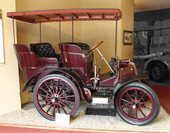
|
| 9[1] | Before 1903[note 1] | straight-twin, 1804 cc | 94 | 130 | ||
| 8[1] | Before 1903[note 1] | straight-four, 3054 cc | 90 | 120 | ||
| 16/18[1] | Before 1903[note 1] | straight-four, 3308 cc | 90 | 130 | ||
| 12[1] | Before 1903[note 1] | straight-four, 3402 cc | 95 | 120 | ||
| 14[1] | 1901–1903[note 3][3] | straight-four engine, 2324 cc | 86 | 100 | 1901 Royal car (TA12) to Edward VII, wagonette body[3] | |
| 22[1] | Before 1903[note 1] | straight-four engine, 4503 cc | 105 | 130 | 1903 Royal cars (TB22 and TC22) to Edward VII[3]
1904 Royal car (TB22) to the Prince of Wales[3] |

|
| 7[1] | 1904 | straight-twin, 1773 cc | 97 | 120 | ||
| 16/20[1] | 1904–1905 | straight-four, 3309 cc | 90 | 130 | ||
| 18/22[1] | 1904–1905 | straight-four, 3827 cc | 95 | 135 | ||
| 28/36[1] | 1904–1906 | straight-four engine, 5,703 cc | 110 | 150 | 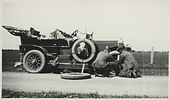
|
Edwardian (1905–1918)[edit]
During the Edwardian era, Daimler licensed and developed the Knight sleeve-valve system. Also during this era, Daimler switched from chain to shaft drive, first using conventional bevel gears, and then, from 1909, using worm gears.
| List of Edwardian Daimler cars | ||||||||
|---|---|---|---|---|---|---|---|---|
| Hp rating | Duration of production | Engine configuration and displacement | Bore (mm) | Stroke (mm) | Valve configuration | Final drive type | Notes | Image |
| 30/40[1] | 1905–06 | straight-four, 7247 cc | 124 | 150 | side valve | chain[3] | 1905 Royal car (TJ) to the Prince of Wales[3] | |
| 35[1] | 1906–07[1] | straight-four, 8462 cc | 134[3] | 150 | side valve | chain[3] | 1905 Royal car (TK) to Edward VII, limousine[3] | |
| 45[1] | 1906 | straight-four, 10,604 cc | 150 | 150 | side valve | |||
| 17[1] | 1907 | straight-four, 3817 cc | 90 | 150 | side valve | chain | ||
| 28[1] | 1907 | straight-four, 6786 cc | 120 | 150 | side valve | chain | 1904 Royal car (TB) to Edward VII[3] | |
| 30[4] | 1907 | straight-four, 7965 cc | 130 | 150 | side valve | chain | 1908 Royal car (TC42) to the Prince of Wales[3] | |
| 35[4] | 1907 | straight-four, 9237 cc | 140 | 150 | side valve | chain | 1905 Royal car (TK) to the Prince of Wales; 1907 Royal car to Edward VII, landaulet[3] |
|
| 30[4] | 1908 | straight-four, 4942 cc | 110 | 130 | side valve | chain | 1907 Royal car (TO) to Edward VII, brake[3] | |
| 36[4] | 1908 | straight-four, 6787 cc[note 4] | 110 | 150 | side valve | |||
| 38[4] | 1908–1913 | straight-four, 6281 cc | 124 | 130 | side valve[4] sleeve valve[3] |
bevel | 1909 Royal car (TC) to the Prince of Wales, limousine[3] | |
| 42[4] | 1908–? | straight-four, 7695 cc | 130 | 150 | side valve[4] | bevel | ||
| 48[4] | 1908–1909 | straight-four, 9237 cc | 140 | 150 | side valve[4] | 
|
||
| 58[4] | 1908 | straight-four, 10,431 cc | 154 | 140 | side valve[4] sleeve valve[3] |
chain | 1908 Royal car (TC) to Edward VII, landaulet; 1908 Royal car (TL) to Queen Alexandra[3] |
|
| 22[4] | 1909–1910 | straight-four, 3764 cc | 96 | 130 | sleeve valve[4] | see also Rover 12 | 
|
|
| 33[4] | 1909–1910 | straight-six, 5616 cc | 96 | 130 | sleeve valve[4] | |||
| 56[note 5][4] | 1909–1911 | straight-six, 9421 cc[4] | 124 | 130 | side valve[4] sleeve valve[3][5] |
bevel[3][5] worm[5] |
Royal cars:
|

|
| 15[4] | 1910–1912 | straight-four, 2614 cc | 80 | 130 | sleeve valve | 
|
||
| 12[4] | 1911–? | straight-four, 1705 cc | 69 | 114 | sleeve valve | |||
| 25[4] | 1911–1912 | straight-four, 4208 cc | 101 | 130 | sleeve valve | 
|
||
| 23[4] | 1911–12 | straight-six, 3921 cc | 80 | 130 | sleeve valve | bevel[5] | 1911 Royal car (TA) to George V[5] | |
| 38[4] | 1911–12 | straight-six, 6252 cc | 101 | 130 | sleeve valve | |||
| 20[4] | 1912–1915 | straight-four, 3309 cc | 90 | 130 | sleeve valve | worm[5] | 1914 Royal car (TO) to George V, ambulance[5] | 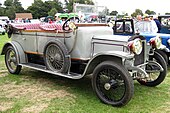
|
| 30[4] | 1912–1915 | straight-six, 4963 cc | 90 | 130 | sleeve valve | |||
| 26[4] | 1913 | straight-four, 4576 cc | 102 | 140 | sleeve valve | |||
| 40[4] | 1913 | straight-six, 6864 cc | 102 | 140 | sleeve valve | |||
| 30[6] | 1914–15 | straight-four, 4942 cc | 110 | 130 | sleeve valve | 1914 Royal car to Empress Sunjeonghyo [7] | 
|
|
| 45[6] | 1915 | straight-six, 7410 cc | 110 | 130 | sleeve valve | worm[5] | 1914 Royal car (TB) to George V, brougham[5] |
Vintage (1919–1930)[edit]
All Vintage Daimlers had sleeve valves and worm final drive.
| List of Vintage Daimler cars | ||||||
|---|---|---|---|---|---|---|
| Hp rating | Duration of production | Engine configuration and displacement | Bore (mm) | Stroke (mm) | Notes | Image |
| 30[6] | 1920–1925 | straight-six, 4962 cc | 90 | 130 | 1920 Royal car (TL) to George V[5] | 
|
| 45[6] | 1920 | straight-six, 7413 cc | 110 | 130 | 1923 Royal car (TJ) to George V, brake[5] | 
|
| 20[6] | 1922 | straight-four, 3308 cc | 90 | 130 | ||
| 12[6] | 1923 | straight-six, 1542 cc | 59 | 94 | ||
| 16[6] | 1923 | straight-six, 2165 cc | 66.5 | 104 | ||
| 21[6] | 1923–1925 | straight-six, 3021 cc | 75 | 114 | 
|
|
| 57[6] | 1923–1925 | straight-six, 9420 cc | 124 | 130 | These cars were made only for selected buyers and were not offered to the public[8] | 
|
| 16, 16/55[6] | 1924–1929 | straight-six, 1872 cc | 65 | 94 | 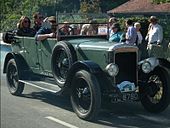
|
|
| 20, 20/70[6] | 1924–1929 | straight-six, 2648 cc | 73.5 | 104 | 1924 Royal car (C) to George V, limousine[5] | |
| 25, 25/85[6] | 1924–1930 | straight-six, 3568 cc | 81.5 | 114[5] | 1929 Royal car (V) to George V, brougham[5] | |
| 35, 35/120[6] | 1924–1932 | straight-six, 5764 cc | 97 | 130 | 1926 Royal car (R) to George V, limousine[5] | 
|
| 45[9] | 1925 | straight-six, 8458 cc | 117.5 | 130 | 1925 Royal car (N) to George V, limousine[5] Daimler claimed the 45 to be the largest production car in the world[10] |
|
| 50 «Double-Six»[9] | 1927–1930 | V12, 7136 cc | 81.5 | 114 | 
|
|
| 30 «Double-Six»[9] | 1928–1932 | V12, 3744 cc | 65 | 94 | Royal cars:
|

|
1930s[edit]
Daimler had introduced their patented Daimler Fluid Flywheel matched with Wilson preselector gearboxes across the range by the beginning of this decade. New engines returned to poppet valves, worm final drive continued throughout the decade into the 1950s.
| List of 1930s Daimler cars | |||||||
|---|---|---|---|---|---|---|---|
| Model or RAC hp rating | Duration of production | Engine configuration and displacement | Bore (mm) | Stroke (mm) | Valve configuration | Notes | Image |
| 20/30[9] | 1931–1934 | straight-six, 3568 cc | 81.5 | 114 | sleeve valve | ||
| 30/40[9] | 1931–1935 | V12, 5296 cc | 73.5 | 104 | sleeve valve | ||
| 40/50[9] | 1931–1935 | V12, 6511 cc | 81.5 | 104 | sleeve valve | Royal cars:
|
|
| 16/20[9] | 1932–1933 | straight-6, 2648 cc | 73.5 | 105 | sleeve valve | ||
| 20/25[9] | 1932 | straight-6, 3568 cc | 81.5 | 114 | sleeve valve | ||
| 15[9] | 1933–1934 | straight-6, 1705 cc | 63.5 | 90 | overhead valve | 
|
|
| 15[9] | 1934–1936 | straight-6, 2003 cc | 63.5 | 105 | overhead valve | 
|
|
| 20[9] | 1934–1936 | straight-6, 2443 cc or 2887 cc | 72 | 100 or 110 | overhead valve | ||
| 25[9] | 1935 | straight-8, 3746 cc | 72 | 115 | overhead valve | 1935 Royal car to the Household of George V, limousine[5] | 
|
| Light 20[9] | 1936–1940 | straight-6, 2565 cc | 72 | 105 | overhead valve | ||
| Light Straight 8[9] | 1936–1938 | straight-8, 3421 cc | 72 | 105 | overhead valve | ||
| 4 Litre[9] | 1938–1940 | straight-8, 3960 cc | 77.4 | 105 | overhead valve | bored out Light Straight Eight rigid front axle with semi-elliptic springs |

|
| 4½ Litre Straight 8[9] | 1936–1940 | straight-8, 4624 cc | 80 | 115 | overhead valve | Royal cars:
rigid front axle with semi-elliptic springs |

|
| 24[9] | 1936–1940 | straight-6, 3317 cc | 80 | 110 | overhead valve |
|

|
| 15[9] | 1937 | straight-6, 2166 cc | 66 | 105.4 | overhead valve | independent front suspension | 
|
| Double Six[9] | 1937 | V12, 6511 cc | 81.5 | 104 | overhead valve | rigid front axle with semi-elliptic springs | |
| 15[9] | 1938–1940 | straight-6, 2522 cc | 69.6 | 110.5 | overhead valve | independent front suspension | 
|
Military vehicles[edit]
| List of Daimler military vehicles | ||||||
|---|---|---|---|---|---|---|
| Model | Duration of production | Engine configuration and displacement | Weight (metric tons) | Main armament | Notes | Image |
| Daimler Scout | 1938–1945 | straight-6, 2522 cc | 3 | .303 in Bren gun or .55 in Boys Anti-tank Rifle | 4-wheel drive known to the Army as Dingo, made at J C Bamford Uttoxeter. | 
|
| Daimler Armoured Car | 1940– ? | straight-6, 4095 cc | 7.6 | 2 pounder QF | all-wheel-drive | 
|
| Ferret Scout Car | 1952–1971 | Rolls-Royce B60 ioe straight-6 | 3.7 | 7.62×51mm NATO GPMG or .30 M1919 Browning machine gun | 
|
Post-WWII BSA (1945–1960)[edit]
Daimler returned to bevel gear final drive with the big cars of 1946 and later replaced their fluid flywheel and epicyclic gearbox with Borg-Warner automatic transmissions.
| List of post-WWII Daimler cars, 1945–1960 | |||||||
|---|---|---|---|---|---|---|---|
| Model or RAC hp rating | Duration of production | Engine configuration and displacement | Bore (mm) | Stroke (mm) | Number made[12] | Notes | Image |
| DB18[13] | 1939–1950 | straight-6, 2522 cc | 69.6 | 110.5 | 3355 | Chassis developed from pre-war New Fifteen, engine developed from the Daimler Scout Car’s engine.[14]
This chassis carried the first of Hooper’s sweeping Empress style |

|
| DE27[13] | 1946–1951 | straight-6, 4095 cc | 85.09 | 120.015 | 255 | Engine developed from the Daimler Armoured Car’s engine. Daimler’s ambulance of this period was based on this chassis. First Daimler with bevel gear final drive since the Edwardian era. |

|
| DE36[13] | 1946–1953 | straight-8, 5460 cc | 85.09 | 120.015 | 205 | Daimler’s last straight-eight Extended DE27 chassis.[15] last State Car |
 
|
| Special Sports[13] | 1948–1953 | straight-6, 2522 cc | 69.6 | 110.5 | 608[note 7] | DB18 drophead coupé by Barker; also available with Hooper Empress saloon body[16] | 
|
| DB18 Consort[13] | 1949–1953 | straight-6, 2522 cc | 69.6 | 110.5 | 4250 | DB18 saloon, updated bodywork | 
|
| Regency[13] | 1951–1952 | straight-6, 2952 cc | 76.2 | 108.0 | 51,[17] also see Regency Mk III | ||
| Conquest[18] | 1953–1956 | straight-6, 2433 cc | 76.2 | 88.9 | 4568[19] | 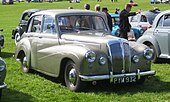
|
|
| Conquest Roadster[18] | 1953–1956 | straight-6, 2433 cc | 76.2 | 88.9 | 119 | Sports car based on the Conquest with an uprated engine[20] | 
|
| Conquest Century[18] | 1954–1956 | straight-6, 2433 cc | 76.2 | 88.9 | 4818 (saloon)[19] 234 (drophead)[21] |
Saloon or drophead with the Roadster engine | 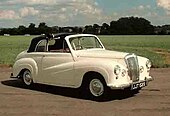
|
| Regina[13] | 1954–1956 | straight-6, 4617 cc | 95.2 | 108.0 | see DK400[note 8] | Replacement for the DE27 and DE36; long-wheelbase Regency[21] | |
| Regency Mk II[13] | 1954–1955 | straight-6, 3468 cc | 82.6 | 108.0 | See Regency Mk III | 3½ litre Regency | 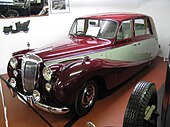
|
| Regency Mk III[13] | 1954–1956 | straight-6, 4617 cc | 95.2 | 108.0 | 560[note 9] | 4½ litre Regency | |
| Sportsman[13] | 1954–1955 | straight-6, 3468 cc | 82.6 | 108.0 | See Regency Mk III | 3½ litre Regency sports saloon | 
|
| One-O-Four (104)[18][22] | 1954–1955[18] | straight-6, 3468 cc | 82.6 | 108.0 | See Regency Mk III | Renamed, uprated Regency; supposedly capable of 104 mph (167 km/h)[23] | 
|
| DK400[18] | 1956–1960 | straight-6, 4617 cc | 95.2 | 108.0 | 132[note 8] | Renamed Regina with Carbodies standard steel limousine body,[24] last production Daimler car with fluid flywheel transmission[25]
car illustrated has Hooper Empress limousine body |

|
| Majestic[18] | 1958–1962[12] | straight-6, 3794 cc | 83.4 | 108.0 | 1490 | Restyled 104 with bigger bore,[18] Borg-Warner automatic transmission, and 4-wheel disc brakes[26] | 
|
| Majestic Major DQ450[27] | 1959–1968[12] | V8, 4561 cc[18] | 95.2 | 80.0 | 1180 | Majestic with 4.5 litre V8 engine[27] | 
|
| SP250[18] | 1959–1964 | V8, 2547 cc | 76.2 | 69.8 | 2645 | Fibreglas-bodied V8 sports car | 
|
| Daimler DR450[28] | 1961–1967[29] | ohv V8, 4561 cc | 95.2 | 80.0 | 864 | Limousine variant of Majestic Major;[30] the last Daimler car not based on a Jaguar.[28] | 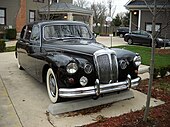
|
Owned by Jaguar (1960–1966)[edit]
BSA sold Daimler to Jaguar in 1960. Development of Daimler cars continued, but some «Daimler-ised» Jaguars were introduced as well.
| List of Daimler cars under Jaguar Cars ownership, 1960–1966 | ||||||
|---|---|---|---|---|---|---|
| Model | Duration of production | Engine configuration and displacement | Base vehicle | Number made[12] | Notes | Image |
| Daimler 2.5 V8 and V8-250 | 1962–1968[18] | ohv V8, 2547 cc | Jaguar Mark 2 | 17,620 | Basically a luxury-appointed Jaguar Mark 2 with a SP250 engine and a Daimler grille; greatest production of any Daimler model;[31] last Daimler not to use a Jaguar engine. | 
|
| Daimler Sovereign[29][32] XJ16 | 1966–1969[29] | dohc straight-6, 4235 cc | Jaguar 420 | 5,824[32] | Jaguar 420 with better finishes and Daimler grille and badges,[18][32] intermediate model between the 2.5 V8 and the Majestic Major[32] | 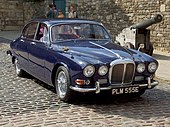
|
Owned by BMC/BMH/British Leyland/Austin Rover (1966–1984)[edit]
| List of Daimler cars under the ownership of BMC and its successors, 1966–1984 | |||||
|---|---|---|---|---|---|
| Model | Duration of production | Engine configuration and displacement | Base vehicle | Notes | Image |
| Daimler DS420[33] Limousine | 1968–1992[29] | dohc straight-6, 4235 cc | Jaguar 420G | Successor to the DR450 and to BMC’s Vanden Plas Princess, based on a lengthened Jaguar 420G floorpan with a completely new body;[33] last Daimler without a corresponding Jaguar version,[citation needed] last production car to use the Jaguar XK6 engine[34] | 
|
| Daimler Sovereign | 1969–1983 | dohc straight-6, 2791 cc[note 10] or 4235 cc[29] | Jaguar XJ6 | Jaguar XJ6 with better finishes and Daimler grille and badges[18] | 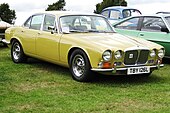
|
| Daimler Double-Six[29] | 1972–1992 | sohc V12, 5343 cc[29] | Jaguar XJ12 | Jaguar XJ12 with better finishes and Daimler grille and badges[18] | 
|
Owned by Jaguar (1984–1989)[edit]
Daimler version of the Jaguar XJ40
- 1986–1992 Daimler XJ40 new car and new engine as prescribed by British Leyland, the 1986 XJ40 Jaguar body could not accept Jaguar’s V12 engine
- 1992–1994 Daimler Majestic XJ340 wheelbase extended 5 inches (130 mm); 3.2- and 4-litre engines
- 1992–1994 Daimler Majestic Double-Six XJ381 6-litre engine. Intended to take 75% of group V12 sales
Owned by Ford (1989–2007)[edit]
- 1994–2002 Daimler X300 and X330 body returns to a more recognisable shape. V8 from 1997
- 1996 Daimler Century limited edition: 50 V12, 50 straight 6; marking 100 years of Daimler Coventry
- 2002–2005 Daimler Super V8 X350 V8 engine, alloy structure
- 2005 Daimler Super Eight
Notes[edit]
- ^ a b c d e f g h Culshaw and Horrobin are not specific about Daimler’s production dates between 1896 and 1902.
- ^ Montagu and Burgess-Wise refer to these cars as 6 hp, but the engine dimensions they give correspond to those of the 4½ hp as given in Culshaw and Horrobin.
- ^ Culshaw and Horrobin list this car as being produced only in 1903, but Montagu and Burgess-Wise list a 1901 Royal car with these dimensions.
- ^ A four-cylinder engine with a 110 mm bore and a 150 mm stroke should have a displacement of 5702 cc
- ^ Montagu and Burgess-White refer to this as a 57 hp car
- ^ a b One of the 1939 cars and the 1940 car were fitted with Lanchester radiators
- ^ Combined total of Barker dropheads and Hooper saloons
- ^ a b Total production for all DK400s, including the Regina.
- ^ Total production of all Regencys, plus the Sportsman and the One-O-Four
- ^ The 2.8 L engine was available only until 1973
References[edit]
Citations[edit]
- ^ a b c d e f g h i j k l m n o p q r s Culshaw and Horrobin, p. 111
- ^ Nixon 1946, p. 222.
- ^ a b c d e f g h i j k l m n o p q r s t u Lord Montagu and David Burgess-Wise, p. 295
- ^ a b c d e f g h i j k l m n o p q r s t u v w x y z aa ab Culshaw and Horrobin, p. 112
- ^ a b c d e f g h i j k l m n o p q r s t u v w x y z aa ab ac ad Lord Montagu and David Burgess-Wise, p. 296
- ^ a b c d e f g h i j k l m Culshaw and Horrobin, p. 114
- ^ «1914 Daimler Limousine».
- ^ Lord Montagu and David Burgess-Wise, p. 195
- ^ a b c d e f g h i j k l m n o p q r s t Culshaw and Horrobin, p. 115
- ^ Lord Montagu and David Burgess-Wise, p. 195
- ^ a b c Lord Montagu and David Burgess-Wise, p. 297
- ^ a b c d Sedgwick, Michael; Gillies, Mark (1998). A-Z of Cars 1945–1970. Bay View Books.
- ^ a b c d e f g h i j Culshaw and Horrobin, p. 116
- ^ Lord Montagu and David Burgess-Wise, p. 248
- ^ a b Lord Montagu and David Burgess-Wise, p. 249
- ^ Lord Montagu and David Burgess-Wise, p. 256
- ^ Lord Montagu and David Burgess-Wise, p. 260
- ^ a b c d e f g h i j k l m n Culshaw and Horrobin, p. 117
- ^ a b Lord Montagu and David Burgess-Wise, p. 265
- ^ Lord Montagu and David Burgess-Wise, p. 264
- ^ a b Lord Montagu and David Burgess-Wise, p. 266
- ^ Culshaw and Horrobin, p. 113
- ^ Lord Montagu and David Burgess-Wise, p. 269
- ^ Lord Montagu and David Burgess-Wise, p. 267
- ^ Lord Montagu and David Burgess-Wise, p. 271
- ^ Lord Montagu and David Burgess-Wise, p. 272
- ^ a b Lord Montagu and David Burgess-Wise, p. 275
- ^ a b Lord Montagu and David Burgess-Wise, p. 282
- ^ a b c d e f g Culshaw and Horrobin, p. 118
- ^ Lord Montagu and David Burgess-Wise, pp. 280–281
- ^ Lord Montagu and David Burgess-Wise, p. 279
- ^ a b c d Lord Montagu and David Burgess-Wise, p. 283
- ^ a b Lord Montagu and David Burgess-Wise, pp. 284–285
- ^ Lord Montagu and David Burgess-Wise, p. 292
Sources[edit]
- Culshaw, David; Horrobin, Peter (2013) [1974]. «Daimler». The Complete Catalogue of British Cars 1895 — 1975 (e-book ed.). Poundbury, Dorchester, UK: Veloce Publishing. pp. 109–118. ISBN 978-1-845845-83-4.
- Douglas-Scott-Montagu, Edward John Barrington & Burgess-Wise, David (1995). «Appendix: The Pre-War Royal Daimlers». Daimler Century: The full history of Britain’s oldest car maker. Foreword by HRH The Duke of Edinburgh. Sparkford, Nr Yeovil, Somerset, UK: Patrick Stephens. pp. 295–297. ISBN 1-85260-494-8.
- Nixon, St. John C. (1946), Daimler 1896 to 1946: 50 Years of the Daimler Company, G.T. Foulis & Co.
- Sedgwick, Michael; Gillies, Mark (1998). A-Z of Cars 1945–1970. Bay View Books.



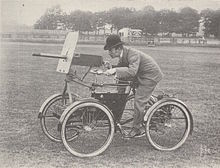
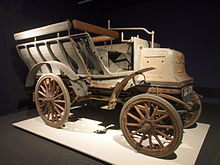
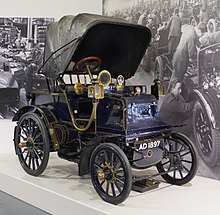













![Daimler-Foster 105 hp[note 1] artillery tractor](https://upload.wikimedia.org/wikipedia/commons/thumb/9/9c/NYT_-_Big_British_gun_going_to_its_position.jpg/120px-NYT_-_Big_British_gun_going_to_its_position.jpg)









